 22/08/2013 00:23 22/08/2013 00:23 |
|
| | | OFFLINE | | Post: 27.033
Post: 9.508 | Registrato il: 28/08/2005
Registrato il: 20/01/2009 | Administratore | Utente Master | |
|



ALWAYS AND EVER OUR MOST BELOVED BENEDICTUS XVI


Oops! Did it again - missed the page change earlier, sorry!


I am so thankful someone like Fr. Schall, a Jesuit like Pope Francis, has tackled this 'bleeding heart' idea of the poor as being no more than objects of perpetual charity. The old adage holds, "Don't just give them fish - teach them how to fish!" But most people in their liberal smugness and self-satisfaction think that beating one's breast about being on the side of the poor amounts to virtue, without really doing anything about helping the poor to be 'not poor'. I think of it as being a sick notion of poverty...
Rethinking the Christian
attitude towards 'poverty'
Insisting that the only thing the poor need is bread
consigns them to a world without signs of transcendence;
what the poor need is not a dole-out but
to be helped in order to be 'not poor'.
by James V. Schall, S.J.

August 16, 2013
I.
For some time, after listening to much of their rhetoric on the topic, the question has bothered me: Do Christians love poverty as such, as a positive good? Do they want people to be poor so that they can be loveable?
Somewhere in my memory, I recall a similar question: If we love our neighbor because we are “commanded” to love him, do we really love him? Or are we just obeying the commandment? Will the person we say we love recognize that what is really going on is that we are gaining points for virtue for ourselves by making it seem like we love him by law? These are questions asked without guile.
Poverty is not just a Christian concern, but also a socialist and a liberal one, though both may have gotten the idea one way or another from Christians. Are the poor the moral basis that justifies the actions of the government or the philanthropists?
In lieu of God, does concern for the poor become a substitute for God as the only visible way to prove that we are not just being selfish? In either case, the poor and “options” for them are but tools that rationalize self-centered lives that have no other reason for existing but their own self-esteem.
In the beginning, I would like to affirm that, in my opinion, it is not the purpose of Christianity to make men poor or to keep them that way, granted that riches or wealth can, if not ordered, be morally dangerous.
They (“all those beautiful things”) can become, as Augustine reflected, a means to obtain whatever we want. Several Latin American economists have remarked that the reason evangelical Christians make such headway in Latin America is because they perceive the need for discipline, work, virtue, honesty, knowledge, enterprise, and other aspects of learning to become productive — of becoming “not poor.”
Catholics, by contrast, (shades of Max Weber’s famous thesis in Protestantism and the Spirit of Capitalism), seem content with the status quo and with a static distribution or redistribution of existing goods that pits one group against another.
Catholics are not concerned with creating more goods, more wealth. In an honorable and effective way they think in terms of distributing their own, someone else’s, or the state’s limited store of goods, not of producing more goods, of increasing the whole of what is available. Though this thesis about Catholics economically lagging behind was challenged by people like George O’Brien and Amintore Fanfani, they did so by pointing to those Catholics, usually German or northern Italian, who did understand growth and innovation as something that can be learned and put into practice.
No doubt, we can also distinguish between loving or helping the poor persons — real individuals in need here and now — and loving “poverty” as such, an abstraction. It would seem that our love of the poor, in some basic sense, ought to include not just our helping the poor in his immediate needs but mainly inciting his capacity to help himself.
We want him not to need us to help him except in the sense that we all need an economic and social system that works for everyone. We want this system to be growing; we do not want a stagnant system which always produces the same or lesser amounts of available goods. We want and need people who do not think solely or mainly in terms of distributing existing goods, which they often conceive to have been ill-gotten simply because someone has more than others.
The poor man is not really much interested in our love of him or his poverty if we do not know how not to be poor. He does not want our love if it strikes him to be, on our part, an exercise in behalf of our private virtue and vanity—“See how I am concerned with the poor!”
We do not, furthermore, need good will towards or “love” of poor wrapped around ways of politics or economics that would, if put into practice, only make things worse or more totalitarian for everyone, including the poor. Almost all modern tyranny has ridden to power on a claim, sometimes even a sincere claim, to help the poor.
We cannot avoid asking where claims to help the poor actually lead, not just where they say they do. In that sense, claiming to “be on the side of” or to help the poor might well be something both of a Christian heresy and a failure of reason.
The “cause” of poverty elimination, even when sincerely (if not naively) intended, has become too much tied up with political and economic systems that seek complete control over citizens and economy in the name of the “common good” and “social justice.” We cannot just think of the poor or poverty without likewise thinking of freedom, virtue, reason, and experience.
II.
Part of the reason that I bring this issue up is because of a letter I recently received from a Midwestern correspondent whom I have never met. She wrote the following:
I have been reading Anne Carey’s revised book about religious sisters [Sisters in Crisis: Revisited]. They have a very strange attitude toward the poor and the “marginalized.” I’ve noticed — they seem to like them to be poor and marginalized. They seem to want them to stay that way. In the meantime, they themselves, the most educated group of women ever who can pretty much count on being taken care of, can think of themselves as champions of the poor and downtrodden. They are not all like that, of course, I know some really wonderful women who are members of some of the wacky congregations. But there really is a strange dichotomy among many of these.
This bluntly stated observation of an ordinary housewife does not just apply to some religious women from, as it were, “wacky” congregations. Whenever someone, religious or secular, tells us that he wants to “identify” with the poor, especially someone who has little clue about the causes of wealth and poverty, we can suspect that the poor are being used as a cloak to justify a political or personal agenda that needs careful examination.
Both the Old and New Testaments, as well as other literature, are, no doubt, filled with admonitions that urge us to give to and care for the poor. As such, no one can have much of a problem with this admonition. The New Testament also assumes that “the poor will always be with us” (Matt 26:11).
In the course of history, two kinds of poverty, as it were, have been distinguished. In part, this distinction had to do with the meaning of what we now call works of “charity.” That is, some people are poor because of natural or accidental defects in intelligence or health, whereby it was impossible for them to care for themselves and their own interests. Someone else had to care for them at least in part. This group was really what Aristotle meant by “slaves,” people by nature or accident who were unable to care for themselves.
The other group contained those who could care for themselves if they had an opportunity to do so. Ideally, they would be able to get themselves out of poverty if they lived in a place or in a system that allowed or encouraged them to do so.
Not every economic or political system can or will do this. Mankind’s history reveals a slow learning process whereby lessons are learned. The best intentions in the world or the highest talents and discipline will not work if either the system is disordered or the people are not basically virtuous. Some economic theorists claim, no doubt, that vice, waste, and luxury are the primary motives for growth. And they do cause a certain kind of development.
Let us ask, however, why did God give us a world in which all things were not provided to us by nature? We can best answer this query by affirming that God intended for us to learn by ourselves how to take the raw earth and transform it into something that served our transcendent purposes.
The greater good was not that everything was provided for us with no input of our own. The greater good was that we actually had something to learn and do, something that included our responsibility to others and to what works. That is why we were given reason and time, nothing much else but a planet and cosmos full of riches if we could but learn of them.
We have to think of these two groups in different ways. The first group will always need someone else to care for them. The latter will not, if they learn or are taught how not to be poor. Laziness and sloth are real negative factors.
When religion confuses these two groups, it identifies itself with the poor in the second sense as if they were poor in the first sense. They will look on the poor as permanently in a condition of need. The justification for one’s religious life is then to “care” for the poor rather than discover ways to teach the poor not to be poor.
III.
If we add to this mix the issue of the vow of “poverty,” we find, along with the classic philosophers like Socrates, a voluntary choice not to be rich, not to be bothered by the cares that having wealth of whatever size may bring.
This choice did not mean that those with vows of poverty did not themselves need enough riches to care for themselves. It meant that they were free to do myriads of other worthy things like philosophizing or, if they chose, assisting those who were poor.
St. Benedict, in a famous phrase, said that the monks are both to pray and to work. St. Ignatius said that we can pray in anything we do. Later economists have realized that this monastic working and not spending was the origin of savings. By being poor, they became rich. This wealth enabled further growth to take place, a growth that built some of the most beautiful places on our planet.
One other caution needs to be added here. The distinction of wealth and poverty is not necessarily a distinction between good people and bad. We can find robbers and cheats among the poor and among the rich, as we can find virtue among both.
Poverty, furthermore, is relative and must usually be thought in the context of envy. One’s sense of one’s own poverty does usually have something to do with “keeping up with the Jonses.” The transportation union of the BART system in San Francisco talked of a strike even if they were among the highest paid workers in the country. The poor in the United States or Europe, while still “feeling” poor, have more income and facilities at their disposal than many of those thought to be rich in the rest of the world.
Moreover, poverty is not the only cause of civic unsettlement. The Muslim world, in spite of huge oil revenues, is one of the poorest areas in the world. This largely is a result of ideas. The main Islamic concern is not to be rich but to establish the law of Mohammed everywhere so that Allah will be praised.
In conclusion, I want to return to issue of the Christian relation to poverty and the poor. But first let me note one school of thought that we hear of whenever anyone wants to build something noble or beautiful. We suddenly hear cries, first spoken by Judas, that “It would better to use the money for the poor” (Jn 13:29). This is the passage in Scripture designed to show that poverty was not always the most important thing to consider.
It has always been my contention that money spent on beautiful things is money spent for the poor. The poor have need of beauty as much as they do bread. And if we insist that the only thing the poor need in their poverty is bread, we will not only insult the poor who can appreciate beauty but we will lock him into a world with no signs of transcendence. The alternative is not beauty or helping the poor, but both.
It is always worth meditation for economists and theologians to wonder how small towns of two or three thousand inhabitants — poor people by our standards — managed over the course of centuries to build some of the most beautiful things in the world. Henry Adams talked of this in speaking of the Virgin and the Dynamo.
My main thesis, however, is that Catholic social thought should shift the direction of its rhetoric in dealing with any issue concerning the poor. It should not primarily stress the Christian’s associating himself with the poor or looking like he is poor, as if the poor man wants everyone to be destitute and is delighted to see well-off folks joining them.
The religious emphasis needs to be more oriented to teaching how not to be poor. It ought to realize that the first step in this change of emphasis is to rid itself of the idea that redistribution of existing goods is nothing but a revolutionary method that would really make everyone poor.
Again, the purpose of Christianity is not to make everyone poor. It must learn to understand profit, markets, and innovation as the primary way to enable the poor, by their own efforts, to become not poor. The poor are not really helped by well-meaning souls who identify with them but who have only confused or detrimental ideas about wealth production.
One final thought seems worth making. The only real resource in the world is the human brain. It is not oil, or material goods, or location. It is true that human intelligence is itself designed to know and deal with what exists in the world.
The world is intended to be a place for man wherein he can become through his own enterprise more fully what he ought to be. The virtue of charity, the need to give of one’s abundance, includes learning how to think and learn what works and what does not.
Aristotle had long ago remarked that men need a certain amount of wealth and goods to be virtuous. That is the kind of being we are. They also, having the goods, need a similar amount of virtue. They need to reject vice and corruption.
The worst thing that can happen to Christianity (itself responsible for much of the grounding of science in its teaching about the existence of a real world with secondary causality in it) is to associate itself or be associated with the love of poverty in such a way that Christians seem to want everyone to be poor and thus take no workable steps to make it otherwise.
Many seem to think that, by claiming to be on the side of the poor, the poor will be grateful and will reconnect with Christianity. I for one doubt this result. How one is perceived does make a difference, no doubt.
The poor, however, usually see where such sympathies lead, to political and ideological control in the name of poverty alleviation. In this area, we have little room for deluding ourselves. Much of world poverty has in fact been reduced or alleviated, as a recent essay in The Economist has shown. Christians often seem not to know that this change has happened or why it happened.
One last point is worth making. The “urgency” of poverty alleviation often makes it seem that the main purpose of the Church in this world is horizontal—that by attending to this issue, it will at the same time fulfill its main purpose. But the Church exists to lead us to a transcendent end, poor and rich alike.
Modern thought has often been an effort to substitute this transcendent end for an inner-worldly one as if making a better world here and now were what it was all about.
Salvation comes into the world whether the world is perfect or not. Christianity holds that the poor qua poor have as good a chance of reaching beatitude as the rich qua rich, probably a better one. Unless this end is understood, no amount of discussion of wealth and poverty in this world will make much difference.
But when the question of the poor does arise, as it should, the main question should not be identification with it, but what really alleviates their condition.
[Modificato da TERESA BENEDETTA 22/08/2013 13:41] |
| |
|
| |
 22/08/2013 12:36 22/08/2013 12:36 |
|
| | | OFFLINE | | Post: 27.034
Post: 9.510 | Registrato il: 28/08/2005
Registrato il: 20/01/2009 | Administratore | Utente Master | |
|

 On her site, Beatrice calls attention to a book that was published in France last year anthologizing 'the most beautiful homilies of Benedict XVI'. In their Preface, the two priests who prepared the anthology call him 'the jeweler of the Word of God', a most appropriate tribute to someone who has treated every homily during his Pontificate (and before that, even if I have only read some of them) as a work of literary and homiletic art, in the manner of the best miniaturist artists, art that exalts God and uplifts the listener, and not just as a platform for facile moralizing
On her site, Beatrice calls attention to a book that was published in France last year anthologizing 'the most beautiful homilies of Benedict XVI'. In their Preface, the two priests who prepared the anthology call him 'the jeweler of the Word of God', a most appropriate tribute to someone who has treated every homily during his Pontificate (and before that, even if I have only read some of them) as a work of literary and homiletic art, in the manner of the best miniaturist artists, art that exalts God and uplifts the listener, and not just as a platform for facile moralizing .
The jeweler of God's Word
by Vincent Cabanac, AA, and Jean Lndousies, CM
Preface, translated from
HOMELIES: Les plus belles homelies de Benoit XVI
Since his election in 2005, Benedict XVI has revealed an unparalleled talent as preacher that has helped correct the distorted image that had been thought of him.
e is admired for his intellectual qualities. With his studies, and then his teaching in the best German universities, this eminent theologian had earned the acknowledgment of his peers.
An expert on the Second Vatican Council, a professor esteemed by his students, lecturer and author of numerous works of theology [and cultural analysis], the future Pope possessed, in the eyes of all, an aptitude for rendering Catholic doctrine intelligible.
His interview books with Catholic journalists [Vittorio Messori and Peter Seewald] show how well he was prepared to confront the questions of contemporary society, daring to go against the mainstream of fashionable thinking.
Meanwhile, a facet of his personality was for a long time little known. Without parochial experience and having been Archbishop of Munich only a short time, his ministry rarely included preaching to Sunday congregations. [Actually, it wasn't all that limited! he spent at least a year being parish factotum in three parishes of Munich, shortly after his ordination as priest, and five years as Archbishop of Munich, during which his Sunday homilies are said to have packed the cathedral of Munich (and an overflow crowd outside the church) and the diocese found itself having to print as many as 50,000 copies of these homilies each time; and even as cardinal, he did parish duties in the little village church near his house in Pentling whenever he was home on vacation.]
In a surprising way, preaching became the art through which Joseph Ratzinger, exercised his new pontifical ministry. [One of the arts, and not surprising at all, because preaching is a literary and rhetorical form, and Joseph Ratzinger's literary gifts enabled him to make an art of anything that had to do with the spoken or written word - homilies, catecheses, books, writings, interviews, off-the-cuff responses - in which form and content are exceptional, complementary and perfectly integrated.]
We can discover that talent in the pages of this book in which we have collected sixty of his homilies made during the great feasts of the liturgical year and other important occasions for the Church. We selected them from the 111 homilies he has given as Pope as of this day (in August 2012) at the Vatican as well as during his pastoral trips in italy and abroad, which make up a corpus of great spiritual, theological and catechetical density.
In dealing with all the great subjects of the faith, they reflect the confidence as well as precision of long meditation and study in depth of Biblical texts and the Patristic tradition.
The first powerful public impression came on the day of John Paul II's funeral, presided by the Dean of the College of Cardinals, in St. Peter's Square. Cardinal Ratzinger touched the hearts of millions of faithful present in Rome and the many more who watched on television.
One can still hear the gentle voice of the preacher who concluded his eulogy by saying of his departed fried: "We can be sure that our beloved Holy Father is at the window of God's house, that he see us and blesses us. Yes, please give us your blessing..." And thus did the Pope's dear friend participate in the emotion of all the faithful.
From his first appearance as Pope at the loggia of St. Peter's Basilica on April 19, 2005, the current Successor of Peter started to cultivate a new way of making the Word of God accessible to all, and of highlighting its spiritual treasures.
At the start of his Petrine ministry, in his first public Mass as Pope, he declared that "At this time, I do not need to present a program of governance... My program of government is not to do my will, not to follow my ideas, but with the Church, to listen to the Word of God and what he wills, and to let myself be led by him". That was indeed his principal objective.
The true genius of Benedict XVI lies in his eye for detail, his search for an authentic and actual interpretation of what the Bible says. He can be compared to a jeweler. Every book of the Bible, like a precious gemstone, becomes more lucid through the skill of he who who, through his commentary, cuts and refines each of its facets. He 'polishes' Scripture so that the faithful can see its clarity, its luminosity. His reading and exegeses of the Fathers of the Church are constant inspirations as we see from his numerous citations and references to them.
Benedict XVI is a faithful disciple of St. Augustine, 'one of the great converts of history', whose wisdom and humility have been his constant source of inspiration. Indeed, the Pope is much more Augustinian than Thomist. He wants to be a Christian with us, and a bishop for us, in exercising his function as teacher and pastor.
Through the pages of this book, re-reading the homilies o Benedict XVI, presented according to theme and liturgical occasions, we can enjoy the the beauty of texts which have been chiselled with faith and intelligence by this Pope.
His homiletic art, as mentioned, can be compared to that of a jeweler of God's Word, or more technically, to a sculptor who always seeks to bring into relief what the Bible says as a veritable treasure for the Church and the faithful.
For prayer and meditating on the Word of God, these texts are like precious gems that never cease to evoke wonder. That was our intention in undertaking the work that led to the publication of this book whose author is Benedict XVI, the Pope who preaches love and hope. [And faith!]
August 29, 2012
Feast of St. Augustine
In 2010, 2011 and 2012, Sandro Magister anthologized the homilies given by Benedict XVI in the year preceding the publication date, and included many of the reflections he gives before the Sunday Angelus prayers which amount to mini-homilies in their form and content. It may be presumed he will complete the series by anthologizing the homilies asnd mini-homilies of 2012 and the two months that remained of the Pontificate in 2013.

Meanwhile, Lella on her blog has posted a brief but lovingly written tribute from a nun that apparently comes from a book anthologizing commentaries about Benedict XVI... I appreciate the fact that Mother Anna Maria Canopi picks up on the endearing but little-noted practice of Benedict XVI to end his discourses with a simple 'Grazie' (especially when one thinks of the continual to-do about he fact that his successor began his first words as Pope with the greeting "Buona sera", Good evening, as though that were a supreme mark of courtesy that was totally lacking in any of his predecessors, none of whom did that, but did at the end of their discourses by way of saying 'till next time')...
Behind that 'Grazie'
from Benedict XVI
by Mother Anna Maria Canopi, OSB
Translated from

August 22, 2013
At the end of his discourses, Benedict XI had the habit of saying "Grazie!" - thanking those who have listened to him.
I think this reveals an essential trait of his personality, characterized, in fact, by amiability, modesty and simplicity, and I would even say, a sense of reserve about having the highest responsibility in the Church hierarchy.
Behind that 'Grazie' is the awareness that he is a humble servant of Christ and of the Church. Wherever he appears, his person presents nothing that is 'imposing', but rather, he has the simplicity and even the shyness of a child.
His very language expresses elevated ideas with such linearity as to be understood by all, by adults and children, by the educated and the not so educated.
He can truly be called 'a true theologian' because he lives intensely his faith, in charity and in prayer.
His amiable attention is always directed at whoever he meets as though he already knows them. That was my own experience with him, and I was left with great wonder for his affectionate way of conversing, as with a brother or a friend, in tune with one's own thoughts and sentiments.
Whenever any campaign of denigration, or even blasphemy, against him is under way, I wonder how it ispossible to sling mud at a person who has all his transparency of truth and gentleness of heart.
I find just one answer: It is the mystery of evil which continues to oppose our Lord Jesus Christ in those who represent him. Indeed, like Jesus, the Vicar of Christ is silent [against such attacks] because truth does not have to be defended.
Like Jesus, Benedict XVI continues to love and to forgive, because love has already conquered in just allowing him to be nailed to the cross.
This is the Holy Father whom I know, and for whom I thank the Lord who has filled him with the Holy Spirit and given him to the Church and the entire world.
About Mother Canopi, from Wikipedia:
Anna Maria Cànopi (born Pecorara, April 24, 1931) is a Benedictine nun. She is the founder and Mother Prioress of the Mater Ecclesiae Abbey, which is located in the San Giulio Island, Lake of Orta, Province of Novara, Italy. She is the author of several books on Christian and monastic spirituality, and a prominent scholar in the Patristic literature. She contributed to the publication of the Italian official edition of the Bible by the Catholic Church. She also wrote the text of the Good
Friday Via Crucis meditations and prayers in 1993 at the request of John Paul II.
[Modificato da TERESA BENEDETTA 23/08/2013 03:29] |
| |
 22/08/2013 14:45 22/08/2013 14:45 |
|
| | | OFFLINE | | Post: 27.035
Post: 9.511 | Registrato il: 28/08/2005
Registrato il: 20/01/2009 | Administratore | Utente Master | |
|

 Thursday, August 22, 20th Week in Ordinary Time
Thursday, August 22, 20th Week in Ordinary Time
MEMORIAL OF THE QUEENSHIP OF MARY
 Pius XII established this feast in 1954 as a logical follow-up to the Assumption - thus it is celebrated in the octave of the Assumption. Mary's queenship has roots in Scripture where the Archangel Gabriel announces that her Son would receive the throne of David and rule forever. Her queenship is a share in Jesus's kingship. The Fathers of the Church, starting with St. Ephrem in the 4th century, called Mary 'Lady' and Queen'. In the Middle Ages, hymns and devotional prayers (particularly by the Dominicans and Franciscans) addressed her invariably as Queen.
Pius XII established this feast in 1954 as a logical follow-up to the Assumption - thus it is celebrated in the octave of the Assumption. Mary's queenship has roots in Scripture where the Archangel Gabriel announces that her Son would receive the throne of David and rule forever. Her queenship is a share in Jesus's kingship. The Fathers of the Church, starting with St. Ephrem in the 4th century, called Mary 'Lady' and Queen'. In the Middle Ages, hymns and devotional prayers (particularly by the Dominicans and Franciscans) addressed her invariably as Queen.
Readings for today's Mass:
www.usccb.org/bible/readings/082213.cfm
No bulletins today from the Vatican so far.
 One year ago...
One year ago...
Benedict XVI dedicated his catechesis at the General Audience to a reflection on the Queenship of Mary which the Church commemorates on this day.
 GENERAL AUDIENCE
GENERAL AUDIENCE
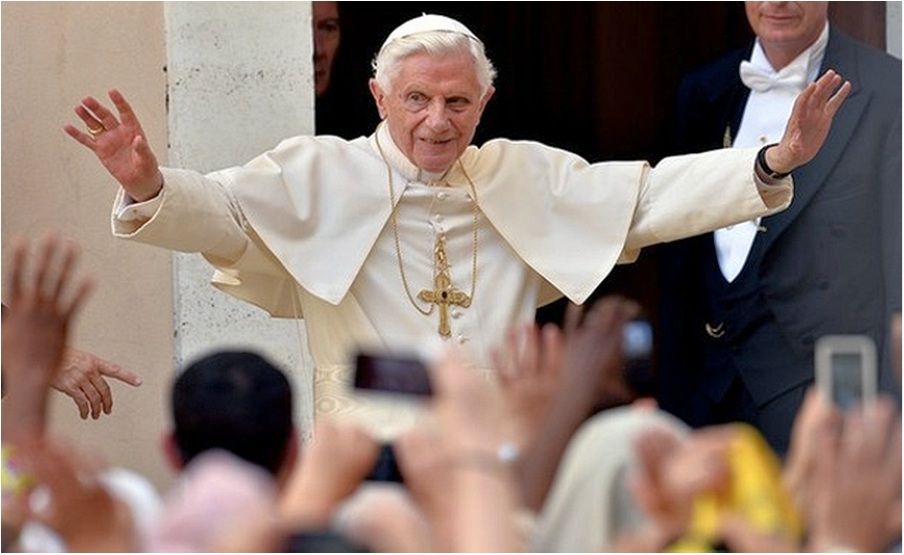 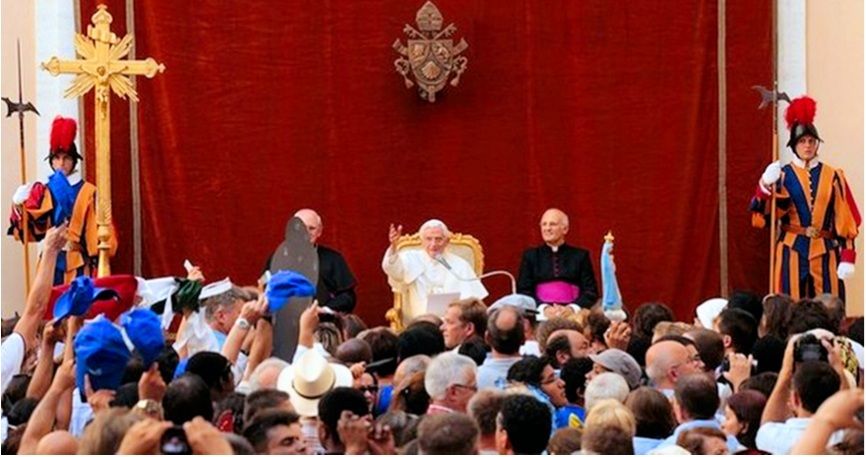 On the Queenship of Mary
Adapted from
On the Queenship of Mary
Adapted from

August 22, 2012
At his weekly General Audience today, Pope Benedict XVI spoke about the Queenship of Mary, the feast that the Church observes on the Octave of the Assumption.
“Devotion to Our Lady is an important part of spiritual life,” the Pope told the faithful who gathered in the courtyard of the Apostolic Residence in Castel Gandolfo, as he asked them to always turn confidently to Mary in prayer, because "she will not fail to intercede for us with her Son.”
The Holy Father also had special greetings for the visiting Chaldean Sisters of Mary Immaculate, praising them for their work on behalf of people in their native Iraq.
The Pope is in Castel Gandolfo for the Summer months, with a reduced schedule of appointments, but he will be travelling to :Lebanon for an apostolic visit on September 14-16.
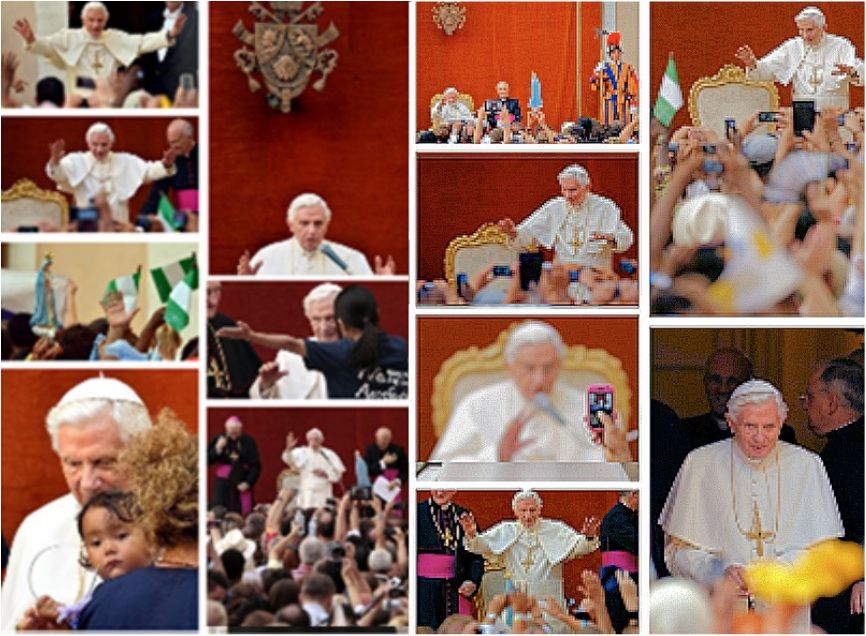
Here is a translation of the Holy Father's catechesis:
Dear brotehrs and sisters,
Today is the liturgical commemoration of the Blessed Virgin Mary invoked with the title of Queen. It is a feast that was recently instituted, even if its origin and the devotion itself are ancient.
The feast was established, in fact, by the Venerable Pius XII at the end of the Marian Year 1954, setting the date of its observance as May 31 (cfr Enc. Ad caeli Reginam, 11 Oct 1954; AAS 46 [1954], 625-640).
On that occasion, Pius XII said that Mary is Queen more than any other creature because of the elevation of her soul and the excellence of the gifts she had received. She does not cease to spread the treasures of her love and her concern for all mankind (cfr Address in honor of Mary the Queen, Nov. 1, 1954).
After the post-Conciliar reform of the liturgical calendar, the feast of the Queenship of Mary was transferred to the Octave of the Assumption, to underscore the close link between the queenship of Mary and her glorification in body and soul next to her Son.
In the Second Vatican Council's Constitution on the Church, we read: "Mary was assumed to celestial glory and exalted by the Lord as Queen of the Universe so that she might be more fully conformed to her Son" (Lumen gentium, 59).
This is the root of today's feast: Mary is Queen because she is associated in a unique way to her Son, both in her earthly journey as well as in the glory of Heaven. The great Syrian Saint, Ephrem the Syrian, said that Mary's queenship derives from her motherhood: She is the Mother of the Lord, of the King of Kings(cfr Is 9,1-6) and she points us to Jesus as our life, salvation and hope.
The Servant of God Paul VI in his Apostolic Exhortation Marialis cultus recalled that "In the Virgin Mary, everything is relative to Christ and everything depends on him: Because of him, God the Father, from all eternity, chose her as the all-holy Mother and adorned her with the gifts of the Holy Spirit that have not been granted to anyone else" (No. 25).
But we may well ask: What does it mean that Mary is Queen? Is it just another title added to the others, a crown, an ornament along with her other titles? What does it mean? What does this queenship mean?
As indicated earlier, it is a consequence of her being united to the Son, of her being in heaven, namely, in communion with God. She participates in God's responsibility for the world and in God's love for the world.
There is a vulgar, or common, idea about a king or a queen: that he or she would be a person of power and wealth. But this is not the regality of Jesus and Mary.
Let us think of the Lord: the regality and the being of Christ consist of humility, service love - it is, above all, to serve, to help, to love.
Let us recall that Jesus was proclaimed king on the cross with an inscription from Pilate: "King of the Jews" (cfr Mk 15,26). And during his time on the Cross, he showed that he is King. How? By suffering with us, for us, loving to the very end, and thus he governs and creates truth, love and justice.
Or let us think of another moment: Before the Last Supper, he bent down to wash the feet of his disciples. So, the regality of Jesus has nothing to do with that of the powerful of the earth. He serves his sevrants - that is what he showed during all his life.
The same goes for Mary: she is queen in her service to God and to mankind. She is the queen of love who lives the gift of herself to God in order to enter into his plan of salvation for mankind. To the angel, she answered: "Behold the handmaid of the Lord" (cfr Lk 1,36). In the Magnificat, she sings: "He has looked upon his handmaid’s lowliness" (cfr Lk 1,49).. She helps us. She is a queen, precisely by loving us, helpign us in our every need. She is our sister, a humble servant.
Now we come to the point. How does Mary exercise her queenship of service and love? By watching over us, her children: children who turn to her in prayer, to thank her or to ask for her maternal protection and her heavenly help, perhaps after losing our way, or are oppressed by sorrow or anguish for the sad and troubled vicissitudes of life.
In serenity or in the darkness of life, we turn to Mary, entrusting ourselves to her continual intercession so that she may obtain from her Son every grace and mercy that we need on our pilgrimage in the world.
Through the Virgin Mary, we trustingly turn to him who rules the world and has the destinies of the universe in his hands. For centuries, she has been invoked as the Queen of Heaven. Eight times, after praying the Holy Rosary, she is implored in the Loretan litanies as Queen of the Angels, of the Patriarchs, of the Prophets, of the Apostles, of the Confessors, of Martyrs, of Virgins, of all the Saints, and of Families.
The rhythm of these ancient invocations, and daily prayers like the Salve Regina [Hail, Holy Queen...] help us understand that the Blessed Virgin, as our Mother who is seated by her Son Jesus in the glory of heaven, is always with us, in the daily unfolding of our daily life.
The title of queen is therefore one of trust, of joy, of love. We know that she who holds in part the fate of the world is good - she loves us and helps us in our difficulties.
Dear friends, devotion to Our Lady is an important element of pour spiritual life. In our prayers, let us not fail to turn trustfully to her. Mary will never fail to injtercede for us to her Son.
Looking to her, let us imitate her faith, her full readiness for God's plan of love, her generous acceptance of Jesus. Let us learn to live from Mary. She is the Queen of Heaven who is close to God, but is also a mother close to each of us, who loves us and listens to us.
Thank you for your attention.

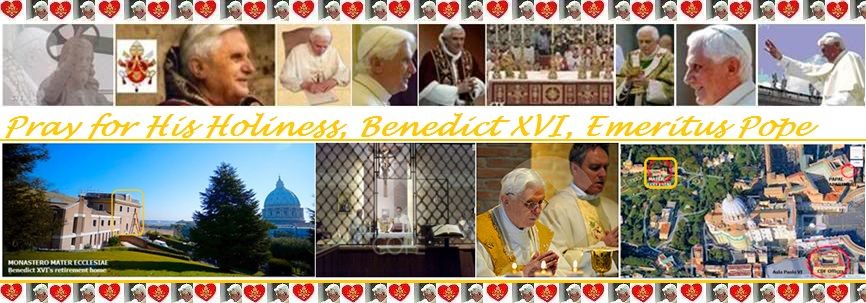
 |
| |
 23/08/2013 04:07 23/08/2013 04:07 |
|
| | | OFFLINE | | Post: 27.036
Post: 9.512 | Registrato il: 28/08/2005
Registrato il: 20/01/2009 | Administratore | Utente Master | |
|
 I thought this post from last year deserves a lookback because it is a rare presentation of an aspect of Benedict XVI's Pontificate that Vaticanistas and other Vatican observers have generally ignored - his scrupulous attention to the quality of bishops around the world, as an example of his hands-on executive leadership, for all that even some of his staunchest admirers generally dismiss his administrative abilities to be virtually non-existent, though no one seems to have a basis for that. Was it ever said that the theology department at Regensburg, or the Archdiocese of Munich, or the CDF, were in administrative chaos and disarray when he was in charge?
I thought this post from last year deserves a lookback because it is a rare presentation of an aspect of Benedict XVI's Pontificate that Vaticanistas and other Vatican observers have generally ignored - his scrupulous attention to the quality of bishops around the world, as an example of his hands-on executive leadership, for all that even some of his staunchest admirers generally dismiss his administrative abilities to be virtually non-existent, though no one seems to have a basis for that. Was it ever said that the theology department at Regensburg, or the Archdiocese of Munich, or the CDF, were in administrative chaos and disarray when he was in charge?

 Thanks first of all to Lella and her blog
Thanks first of all to Lella and her blog

for leading me to this account, which illustrates how the media - including the best Vaticanistas and the usually attentive John Allen - failed, or did not think it important, to look at the totality of the private documents from the Pope's desk that were published by Gianluigi Nuzzi in his book Sua Santita : Le carte segrete di Benedtto XVI ['Your Holiness': The private papers of Benedict XVI]. (Nuzzi has said that 'Sua Santita' in his title comes from the usual heading for letters or notes addressed to the Pope, therefore I translate it as 'Your Holiness', in which Italian uses the third-person singular to address a distinguished or older person. English news reports have translated it literally as 'His Holiness', which does not make sense as a form of direct address)...
Anyway, translation quibbles aside, the more I think of it, the more I think that the book could have been entitled simply 'SUA SANTITA' in the general sense, meaning 'HIS HOLINESS' - precisely because it contains nothing that impugns Benedict XVI's personal holiness in any way, as the author himself says so in his introductory chapter to the book.
What is obviously the failure by most reporters in their reporting of Nuzzi's book was that they were all so focused on finding the negative aspects they could write about - nothing about the Pope, but yes, about other people who wrote the Pope or who had committed themselves in writing to comment about important Vatican and Church affairs - that not one of them thought to write about the positive information contained in the book about the Pope himself.
Yet Andres Beltramo Alvarez, whose reporting I sometimes have problems with, does so in this article, citing a memorandum by Benedict XVI to the then Prefect for Bishops, Cardinal Re, about a problem bishop in Australia. When was the last time we were made privy to an internal memorandum by a Pope, least of all one of this kind that shows us at first hand the attention and detail devoted by Benedict XVI to matters that need his intervention?
And yet, not one reporter before Beltramo Alvarez, at least among the manifold articles I have read about Nuzzi's book, even thought that this memorandum was in itself rare of its kind and therefore newsworthy for that alone. [A weak analogy would be if a similar memorandum had been made public, from the President of the United States to his Secretary of Defense, telling him why he has no choice but to fire a dissident general from his position.] If they had appreciated the rarity of such a papal memorandum, they would have written about it, as they ought to have! My only question is why Beltramo who writes for VATICAN INSIDER did not write this up for the Insider, and only used it on his blog.
How does Benedict XVI govern?
Translated from the blog

August 21, 2012
Benedict XVI is a Pope who governs, as we have repeated on this space on numerous occasions, because that is what the facts show.
But again and again, from the time he assumed his Petrine ministry, there has been an effort to 'extend' by some artifice or other the idea that Joseph Ratzinger is a Pope who is isolated, ailing or incapable of holding the reins of the Catholic Church. [In fact, Marco Politi and the rest of the cabal that persists in defaming Benedict XVI this way have never provided any 'proof' that he is any of those things - they simply state it ex cathedra!]
Now, let us look at a document that demonstrates the very opposite.
The book by Gianluigi Nuzzi, 'Sua Santita', is not only the concrete symbol of the scandal known as Vatileaks, because it contains a great number of private documents that were never meant to leave the confidential files of the Holy See. [Let it not be forgotten, BTW, that the documents published appasrently all dated to the period from late 2009 to early 2012 - which indicates that the thief Paolo Gabriele began his treasonous work only two years ago, more or less, a fact not explained or even cited in the documents that the Vatican has released so far about his case.]
But it is also a valuable source of information. Not all the documents contained in the book are embarrassing. In fact, some texts show hitherto-unknown positive facts about the work of the Bishop of Rome.
More importantly, going through its 326 pages, one will not find any huge international conspiracies, shameful laundering of money or links with the Mafia and other criminal elements, as one may have been led to believe. [Nor, it must be said, evidence of the 'corruption' that almost every MSM news report attributes to the Vatican based solely on Mons. Vigano's broad but unsubstantiated accusation!]
The book reflects matters regarding ordinary pontifical administration - some serious, and some not. Most of the documents are letters or messages sent by persons in different parts of the world to the leader of the Church, to seek his intervention in concrete situations.
But it also has some interesting reports, under-estimated by Nuzzi, perhaps because of his relative unfamiliarity with the ecclesiastical world (he has never been a Vatican reporter; he was and continues to be a reporter on judicial matters). And because these reports are presented towards the end of the book, little attention has been paid to them by reporters.
In fact, these are notes by Benedict XVI himself about key issues, in which one can appreciate how the Pope governs, and when looked at all together, provide the profile of a zealous pastor who is concerned, patient, informed and by no means 'fragile', despite all the real pressures he is subjected to.
Let me just cite the case of William M. Morris, who was the Bishop of the Australian diocese of Toowoomba. On May 2, 2011, the Vatican Press Office made the announcement that the bishop had been dismissed by the Pope from his diocesan responsibility. In keeping with its usual practice, the Holy See [other than citing the applicable canon law provision] does not explain the circumstances of the dismissal, the reason for which was uncommon and represented a serious problem.
However, the case was well known. Morris was someone who was never silent about his progressivist thinking. In 2006, he sent a pastoral letter defending the ordination of women as priests, and allowing Anglican priests to administer Catholic sacraments. He also proceeded to impart collective absolution on the faithful, bypassing the need for individual confession. He justified all of this by the lack of priests in his diocese which covers a territory of 487,000 sq km.
In 2007, the Holy See sent US Archbishop Charles Chaput (then Archbishop of Denver) to make an apostolic visitation to Toowoomba. [Alvarez fails to mention that before the visitation, the Holy See warned Morris several times against his heterodox teaching and practices, to no avail.]
After receiving Mons. Chaput's report, and with all available facts in hand, Benedict XVI summoned Morris to the Vatican and had a private audience with him. Morris assured him that he would present his resignation, but he never did, and openly proclaimed his 'rebellion', defending his dissent to the press and raising a great stir.
Benedict XVI followed his case meticulously, as shown by the memorandum reproduced below integrally, which shows a well-informed Pontiff who knows the case and is unequivocally clear about the doctrinal responsibility demanded of any bishop.
A Pope who carries out his work with diplomacy and respect. He never questions the intentions of the bishop even in his open disobedience, and even suggests that he himself, the Pope, may have misunderstood Morris because he does not know English enough, although obviously, he acquits himself quite well in that language.
His memorandum is addressed to the then Prefect of the Congregation for Bishops, Cardinal Giovanni Battista Re, and is dated from December 2009. Morris was not dismissed until 17 months later, when even the patience of the Pope reached a limit.
Vatican City
December 11, 2009
Memorandum for His Eminence
Re: Morris
Thank you for the draft of a letter to H.E. Mons. Morris. I would add the following elements:
- The prelate always speaks of 'process' and 'defects in the process' (Page 1 of Morris letter, Par. 5), and goes on to say “I have been denied natural justice and due process” (Page 2, Par 6); and “there has not been a canonical process” (ibid), etc.)
One should say that in fact, there was no process at all, but a fraternal dialog and a call on his conscience to freely renounce his responsibility as a diocesan bishop. We are convinced that his doctrinal formation is not adequate for this position, and it was our intention to explain to him the reasons for our belief.
- The prelate speaks of “a lack of care for the truth” on our part (Page 1, Par. 4). This statement is unacceptable. But obviously, there was a misunderstanding, created, it seems to me, by my insufficient knowledge of the English language.
In our meeting, I intended to convince him that his resignation was desirable, and I understood him to have expressed his readiness to resign his position as Bishop of Toowoomba. I see from his letter that this was a misunderstanding, of which I take note, but I am obliged to say firmly that this was not 'a lack of care for the truth'.
- The prelate states that it is all a question of cultural differences, which do not have bearing on communion. In fact, his pastoral letter - which also contained highly questionable pastoral choices - contains at least two proposals that are incompatible with the Catholic faith.
- The letter says that the Church could proceed with ordaining women in order to make up for the shortage of priests. But the Holy Father John Paul II decided in an infallible and irrevocable way that the Church does not have the right to ordain women in the priesthood.
- Morris also says that the ministers of other Christian communities (e.g., Anglicans) could help in the Catholic Church. But the doctrine of the Catholic faith holds that their ministries are not valid in the Church because (their ordination was) not sacramental, and therefore, they cannot perform acts in the Catholic Church that are linked to the sacraments. [That is why the Anglican bishops and priests who rejoin the Church under Anglicanorum coetibus first have to be re-ordained by the Church.]
There are no doubts that he has good pastoral intentions, but it also appears clear that his doctrinal formation is inadequate. And yet, the diocesan bishop must be, above all, a teacher of the faith, since faith is the foundation of pastoral work. That is why I asked him to examine his conscience before God about freely giving up his present ministry in favor of a ministry that is more compatible with his gifts.
Please assure him of my prayers.
BXVI


[Modificato da TERESA BENEDETTA 23/08/2013 04:14] |
| |
 23/08/2013 11:29 23/08/2013 11:29 |
|
| | | OFFLINE | | Post: 27.037
Post: 9.513 | Registrato il: 28/08/2005
Registrato il: 20/01/2009 | Administratore | Utente Master | |
|

 As appalled as I was by what I have come to think of as a ZENIT reporter's invention of statements he attributes to Benedict XVI - implausible because IT'S JUST SO OUT OF CHARACTER! the emeritus Pope would be the last person in the world to articulate anything so private and personal as a 'mystical experience', much less to a 'recent guest' who then goes on to blab about it to a reporter - I am even more appalled at the absurd havoc wrought by that invention. To the point that even the lead priest-commentator of the UK Catholic Herald apparently buys into the 'truth' of the story, without even questioning the circumstances - because if he does not buy the story, then the entire article in today's CH is completely gratuitous and unnecessary.
As appalled as I was by what I have come to think of as a ZENIT reporter's invention of statements he attributes to Benedict XVI - implausible because IT'S JUST SO OUT OF CHARACTER! the emeritus Pope would be the last person in the world to articulate anything so private and personal as a 'mystical experience', much less to a 'recent guest' who then goes on to blab about it to a reporter - I am even more appalled at the absurd havoc wrought by that invention. To the point that even the lead priest-commentator of the UK Catholic Herald apparently buys into the 'truth' of the story, without even questioning the circumstances - because if he does not buy the story, then the entire article in today's CH is completely gratuitous and unnecessary.
http://www.catholicherald.co.uk/commentandblogs/2013/08/22/benedict-xvis-mystical-experience-was-nothing-out-of-the-ordinary-all-catholics-can-discover-gods-will-in-prayer/
To seek to explain what B16's 'mystical experience' is or might have been is to accept that he told someone he resigned the papacy because God told him to do so, as the ZENIT tall tale goes. From which the whole world extrapolates that God did want Benedict XVI to leave in order that Cardinal Bergoglio could become Pope... And contrary to Fr. Smith's assumption, secular media is not 'excited' about whether B16 had a mystical experience or not - what matters to them is that now they can use the ZENIT invention as the ultimate 'divinely inspired' endorsement of the new Pope...I thought of just making do with the link to Fr. Smith's article, but for the record, here it is, in minor mode, so to speak...
Benedict XVI’s ‘mystical experience’
was nothing out of the ordinary
Despite the excitement of the secular media,
the Pope went through the same process as
any other Christian faced with a major decision
By FR ALEXANDER LUCIE-SMITH

Thursday, 22 August 2013
Talk of Pope Benedict’s mystical experience of God telling him to resign the Papacy seems to have struck a chord with the secular media. The Guardian has the story here and the Telegraph has it here. And yet, if ever there was a non-story, this it is.
Let me try and explain. There is a very good old joke that goes the rounds of preachers (all the best jokes are old, by the way) and which I heard, if I remember right, from Nicky Gumbel, the rector of Holy Trinity Brompton. A young Londoner was in love with two girls, as sometimes happens, and had given the impression he was interested in marrying both of them, which again sometimes happens. But he really could not choose between them: one was called Claire and the other Maria. So he went to Church and knelt down in front of the altar, and prayed to the Almighty. He prayed really hard, and he asked for a sign: “Dear Lord,” said the young cockney, “Please tell me, ’oo shall I ’ave? Shall I ’ave Claire or shall it be the other one?” And he looked up, hoping for an answer, and there over the altar in large letters was God’s reply: AVE MARIA.
Mystical experience? Of course not. Neither for that matter was there anything mystical about the way Charles I consulted the sortes virgilianae. God does speak to people, Popes included, but he does so in rather a different way.
Essentially what happened to Pope Benedict is that he became convinced in prayer that it was the will of God that he should lay down the burden of office. He must have been thinking about this matter, and he prayed about it, and the conviction came, through long hours of prayer, that this was the right thing to do. And this would be the same process that any other Christian would go through when faced with a major decision; so that is why I call this a non-story, in that the story does not reveal anything specially privileged about being Pope, but points to the privileges that all the baptised and confirmed share. Each one of us can pray, and can take dilemmas to God, and the peace of mind that follows a decision is often the providential sign that this is the decision that God wants us to make.
The Pope, while he does have special powers vested in him by virtue of his office, presiding as he does over the Universal Church, at the same time approaches the throne of God just like you and me. Years ago, Catholics were told that Pope Pius XII had a vision of Our Blessed Lord when he was gravely ill in 1954. I remember reading about this as a child; but since then the Church has steered away from portraying the Pope as somehow more spiritually privileged than the rest of us.
Indeed the contemporary picture is the Pope as co-pilgrim with other members of the Church, which I think is the right emphasis. In other words, the holiness and saintliness of the Pope is a holiness and saintliness to which we are all called and in which we can all share. Benedict’s story of conversation with God in prayer is a reminder that all of us are called to speak to God in prayer, and all of us can discover his will for us in prayer.
More to the point is this reaction by Peter Seewald, who also calls the allegations in ZENIT 'invention':
Peter Seewald on the ZENIT tale:
'All twaddle and invention'
Translated from

MUINCH, August 22, 2013 (kath.net) - "I can only say that it is all twaddle and invention", Peter Seewald, who has published three interview books with Joseph Ratzinger, the third of them while he was Pope, told kath.net on Thursday.
He was asked about the now widely-disseminated report by the Rome-based agency ZENIT harking back to Benedict XVI's renunciation of the Papacy, a story which he called nonsense.
[kath.net then goes on to summarize the ZENIT story.]
Seewald, who has known the emeritus Pope since 1992 and has since met him often, told kath.net: "Even if all the media have fallen for this moonshine, I can only refer to the best source. I myself visited Benedict XVI recently, and we spoke about his resignation. He never expressed himself in any way in such a direction".
If Benedict XVI were not in retreat from the world, one would hope for a statement, say, through Mons. Gaenswein, that "The Emeritus Pope regrets to say that, contrary to reports, he has never claimed to anyone that his decision was the result of a mystical experience...", or words to that effect.
Another German writer, Armin Schwibach, a veteran Vatican correspondent, wrote a piece for kath.net revolving around the ZENIT tale and hown during an August when the Pope has no public events other than the Sunday Angelus, news from the Vatican has been so scant that the media have to make up for it, and ZENIT gave everyone the much-needed push.
His article is entitled "Here's news: The (ex-)Pope is Catholic - he prays and seeks to discern the will of God in order to act. The search for a 'scoop' at any cost". I really must try to translate Schwibach's article because in it, he goes into a most relevant reference to Benedict XVI's last great catechetical cycle on Christian prayer and what it tells us about him indirectly.]
CNS at least showed healthy skepticism about the ZENIT tale, citing 'Vatican officials', alas unnamed, who are skeptical not about the report per se, but about the 'mystical experience' supposedly claimed by Benedict XVI - when the report itself should be questioned. It cites an anonymous source who claims to have been told by this very private Pope of a very personal experience that is not meant for public broadcast, and then promptly divulges it to a reporter! Gimme a break!... Yet no one said, "It's not at all like Benedict XVI to exploit his own personal spiritual experience, whatever it was!", because that is the basic implausibility of this invention...
Vatican officials dubious
of 'mystical experience'
attributed to Benedict XVI
By Cindy Wooden

VATICAN CITY, Aug. 21, 2013 (CNS) -- When Pope Benedict XVI announced his resignation in February, he made it very clear that he had done so only after intense prayer and that he intended to live the rest of his life praying and studying.
Vatican officials and Vatican watchers were surprised recently when a report circulated that Pope Benedict had told an anonymous visitor that his decision was the result of some form of extraordinary "mystical experience" rather than a decision made after long and careful thought and deep prayer. Catholics traditionally would consider that kind of intense prayer a "mystical experience," although not something extraordinary.
Those skeptical of the report, carried in the Italian service of the Zenit news agency, quoted Pope Benedict's explanation in his own announcement Feb. 11: "After having repeatedly examined my conscience before God, I have come to the certainty that my strengths, due to an advanced age, are no longer suited to an adequate exercise of the Petrine ministry."
He also told the cardinals that he wanted to dedicate the rest of his life to serving the church through his prayers.
Since stepping down Feb. 28, retired Pope Benedict has led a very quiet life, far from the public eye, although he did accept Pope Francis's invitation to be present July 5 for the dedication of a statue in the Vatican Gardens.
Living in a remodeled monastery in the Vatican Gardens, he occasionally welcomes visitors, especially friends, former students and small groups accompanying former students. The meetings are private and rarely reported in the news.
In a report Aug. 19, Zenit said someone who had visited Pope Benedict "a few weeks ago" had asked him why he resigned. "God told me to," the retired pope was quoted as responding before "immediately clarifying that it was not any kind of apparition of phenomenon of that kind, but rather 'a mystical experience' in which the Lord gave rise in his heart to an 'absolute desire' to remain alone with him in prayer." [EEEWWWW!!! Even just re-reading those statements attributed to B16 makes me recoil. In what distorted universe would Joseph Ratzinger.Benedict XVI be so self-referentially sanctimoniously goody-Godly!]
[Modificato da TERESA BENEDETTA 23/08/2015 23:26] |
| |
 23/08/2013 13:29 23/08/2013 13:29 |
|
| | | OFFLINE | | Post: 27.038
Post: 9.514 | Registrato il: 28/08/2005
Registrato il: 20/01/2009 | Administratore | Utente Master | |
|

 Now this is real news - even if and especially since the Vatican's own media has never reported it - not the invention of some agency hack citing an anonymous (and probably fictitious) source - and yet, this has not been reported till now. The article appears on www.chiesa run by Sandro Magister but is one of those pieces inexplicably bylined "***"
Vatican Diary:
Now this is real news - even if and especially since the Vatican's own media has never reported it - not the invention of some agency hack citing an anonymous (and probably fictitious) source - and yet, this has not been reported till now. The article appears on www.chiesa run by Sandro Magister but is one of those pieces inexplicably bylined "***"
Vatican Diary:
Among Pope Benedict's last acts as Pope
He changes the text of the Baptism rite to explicitly say
the new Christian is being received into 'the Church of God'
not just into 'the Christian community'
by ***
Translated by Matthew Sherry for

VATICAN CITY, August 22, 2013 – The Sunday after the Epiphany is the Sunday of the baptism of Jesus. And on each of these Sundays, year after year, Benedict XVI administered the first sacrament of Christian initiation to a certain number of children, in the Sistine Chapel.
Each time, therefore, he had occasion to pronounce the formulas supplied by the rite of baptism in effect since 1969. But two of the words in this rite never entirely convinced him.
And so, before renouncing the chair of Peter, he ordered that they should be changed in the original Latin, and as a result in the modern languages as well.
The amendment was published in the official bulletin Notitiae of the Congregation for Divine Worship and the Discipline of Sacraments, Its existence was pointed out, amid the silence of the Vatican media, by Avvenire, the newspaper of the Italian episcopal conference. [THIS IS TRULY OUTRAGEOUS: Why the Vatican media thought this was not at all worthy of being reported as news is one of those unfathomable 'perplexities' we have grown accustomed to with them! Does the rest of the Curia even know about this???? When and how was the universal Church going to be informed about the change properly and clearly, though it's too late now to say 'promptly'? This appears to be yet another 'bureaucratic' sabotage of Benedict XVI's intentions and acts, as was the recent one done on Summorum Pontificum]
In the decree published in Notitiae, 557-558, Ian.-Feb. 2013, 1-2, pagg. 54-56, "communitas christiana" is changed to "Ecclesia Dei" in paragraphs 41, 79, 111, 136, and 170 of the second "editio typica," or normative, in Latin, of the 1973 rite for the baptism of children.
The decree that introduces the innovation, published in Latin, begins as follows:
"The gate of life and of the kingdom, baptism is a sacrament of faith, by which men are incorporated into the one Church of Christ, which subsists in the Catholic Church, governed by the successor of Peter and by the bishops in communion with him.”
It is precisely on the basis of this consideration that the CDW explains the change to the wording of the rite in the second Latin “editio typica" of the 1973 rite for the baptism of children (which is is identical to the wording in the first “editio typica" of 1969):
"So that in this same rite more light may be shed on the doctrinal teaching of the task and duty of Mother Church in the sacraments to be celebrated.”
The change introduced is the following: From now on, at the end of the rite of reception, before signing with the cross the forehead of the child or of the children, the priest will longer say: "Magno gaudio communitas christiana te (vos) excipit," but instead: "Magno gaudio Ecclesia Dei te (vos) excipit".
In practice Papa Ratzinger, as a sophisticated theologian, has maintained that in the baptismal rite, it should be clearly said that it is the Church of God - which subsists fully in the Catholic Church - that receives those who are being baptized, and not generically the “Christian community,” a term that also signifies the individual local communities or non-Catholic confessions, like the Protestants.
The decree published in CDW bulletin Notitiae specifies that Benedict XVI “benevolently established” the aforementioned variation in the course of an audience granted to the prefect of the congregation, Cardinal Antonio Cañizares Llovera, on January 28, 2013, just two weeks before the announcement of his resignation as pope.
The decree bears the date of February 22, 2013, the feast of the chair of St. Peter, and is signed by the cardinal prefect and by the secretary, Archbishop Arthur Roche. It is said there that it went into effect on March 31, 2013, when the Pope was already Francis, who evidently did not object to his predecessor's decision.
The introduction of the change into modern languages will be overseen by the respective episcopal conferences.
Currently in English, the phrase reads "The Christian community welcomes you with great joy" - which with the change will now read "The Church of God welcomes you with great joy".
In French: "La communauté chrétienne t’accueille avec une grande joie."
In Spanish: "La comunidad cristiana te recibe con gran allegria."
In Portuguese: "È com muita allegria que la comunidade cristã te recebe."
Departing slightly from the original Latin are the German version: “Mit großer Freude empfängt dich die Gemeinschaft der Glaubenden [The community of believers welcomes you with great joy]" and the one now used in Italian: “Con grande gioia la nostra comunità cristiana ti accoglie [With great joy our Christian community welcomes you].”
The Italian formula is the one that Benedict XVI used each time he administered the sacrament on the Sunday of the Baptism of Jesus. And perhaps it is precisely that excessively self-referential “our” that induced the Pope-theologian to decide on the change.
Until 2012, in fact, Benedict XVI omitted the “our,” and although he was celebrating in Italian, he told the little baptizands: "With great joy the Christian community welcomes you.”
But in the end he must have considered the original Latin ambiguous as well. So that last January 13, in celebrating baptism for the last time as supreme pontiff, he said: "Dear children, with great joy the Church of God welcomes you.”
And shortly afterward, among the last measures of his pontificate, he prescribed this formula for the whole Church.
[The site then goes on to publish the full text of the decree in Latin.][Modificato da TERESA BENEDETTA 23/08/2013 14:47] |
| |
 23/08/2013 13:53 23/08/2013 13:53 |
|
| | | OFFLINE | | Post: 27.039
Post: 9.515 | Registrato il: 28/08/2005
Registrato il: 20/01/2009 | Administratore | Utente Master | |
|

 Friday, August 23, 2013, 20th Week in Ordinary Time
Friday, August 23, 2013, 20th Week in Ordinary Time
 ST. ROSA DE LIMA (Peru, 15816-1617), Dominican Lay Sister, Mystic, First Saint of the Americas
ST. ROSA DE LIMA (Peru, 15816-1617), Dominican Lay Sister, Mystic, First Saint of the Americas
Born Isabel Flores de Oliva to Spanish parents, the future saint was baptized by the future St. Toribio de Mongrovejo, Archbishop of Lima. Pious and devout even as a girl, she was unmindful of her family's position and wealth and her own personal beauty. An admirer of Catherine of Siena, she imposed mortifications on herself, tended a garden and did fine embroidery from which she earned money to care for the poor. At age 20, she professed her vows in the Third Order of St. Dominic, and spent the remaining years of her short life in good deeds - caring for homeless children, the elderly and the sick - penance and devotion to the Blessed Sacrament, experiencing many ecstatic visions. When she died, all of Lima turned out for her funeral, and many miracles were soon attributed to her. She is venerated in Lima's Basilica of St. Dominic along with two other Lima saints, Martin de Porres (who had been her confessor) and Alonso Abad. She was beatified in 1667 and canonized in 1671. As a Hispanic saint, she was one of the official patron saints of the WYD 2011 in Madrid. and one of the intercessors for WYD 2013 in Rio de Janeiro.
Readings for today's Mass:
www.usccb.org/bible/readings/082313.cfm
The only Vatican bulletin today is a report that an Auxiliary Bishop for the Arch-Eparchy of Ernakulam-Angamaly of the Syro-Malabar Church (India) has been elected by the Church Synod. Fr. Jose Puthenveettil's election has the approval of Pope Francis, who named him titular bishop of Rusubbicari.
 One year ago...
One year ago...
There were no events announced for Benedict XVI either, from Castel Gandolfo where he spent the summer. But the Vatican released the text of the Holy Father's telegram of condolence for the death yesterday at the age of 88 of Cardinal Paul Shan Kuo-hsi, S.J., emeritus bishop of Kaohsiung (Taiwan). The telegram (in English) was sent to the current Bishop of Kaohsiung, Mons. Peter Liu Cheng-chung.
However, last year, it was an occasion for me to recall the terrible summer of 2011 and the relentless attacks on Benedict XVI at the time... IMHO, it is never inopportune - indeed, it is always useful and instructive - to recall this feigned and artificially fanned rage, along with the objective facts that are relevant to the case.
THE THREE-WEEK 'RAGE OF THE IRISH'
AGAINST THE VATICAN IN THE SUMMER OF 2011

The release of the so-called Cloyne Report on July 13, 2011, triggered an unprecedented national anti-Vatican, anti-Church hysteria in Ireland for about three weeks - from July 13-August 2 based on the reports I posted on this thread at the time, as reflected in MSM coverage - which included the Irish PM's highly 'truth-challenged' rant on July 20. The hysteria was in total disproportion to the actual negative findings of the report, which moreover, had been known to everyone since December 2010. However, the full text of the report could not be released at the time because one of the accused priest still had a court case pending.
A psychologist of mass hysteria can probably explain why the furor exploded in July 2011, when nothing new was disclosed about the contents of the report. Especially since nothing similar had erupted following the three earlier reports on child abuse in Ireland:
(1) The 2005 report on abuses committed in the diocese of Ferns cfrom 1962-2002. The figures: In a 40-year period, 'more than 100 complaints' presented against 10 priests. [This is an unusually high offense rate for a smalll diocese, and it was the basis for Benedict XVI's stern admonition to the Irish bishops during their first ad-limina visit in his Pontificate in October 2006.]
2) The Ryan Report in May 2009 on physical, pscyhological and sexual abuses committed against children and minors, not just by priests but also by lay employees, from 1913-2000 in 200 schools run by Catholic religious orders, which had about 25,000 pupils during the period investigated. The figures: In a 35-year period (1965-2000 when it was possible to track most of those conferned), 1500 complaints (of which only 391 were sexual), 800 accused abusers.
3) The Murphy Report in November 2009 on abuses committed in the Archdiocese of Dublin from the 1940s to 2000, during which time, altogether 2,800 priests and religious served in the archdiocese. During that period, 102 priests/religious were named in complaints received by the Commission. Again, because of practical time considerations, the investigation focused on the period from 1975 to 2004. The figures: For the 29-year period, 320 complaints were presented against 46 priests, of which 11 had confessed or been convicted, 1 was clearly a case of false accusation, and two were merely 'suspected' but not accused.
The Murphy Commission extended its investigation to the Diocese of Cloyne because there was evidence of unsavory things happening as late as 1996-2005, the period investigated by the commission. And here's what the July 2011 eruption was all about:
The Murphy Report on The Diocese of Cloyne, July 2011
Let me cite the Irish Times's summary of the objective findings of the report - because this newspaper wouldn't be expected to be restrained, much less to whitewash, anything bad at all against the Church
www.irishtimes.com/newspaper/breaking/2011/0713/breaki...
and indeed it frontloads its article with everything bad that the report can say about the Vatican.
The 'case against the Vatican' comes down to two things -
1) that it was 'entirely unhelpful' and 'unsupportive' of the civilian inquiry; [What could the Vatican have told them about local events which even the bishop and his collaborators sought to conceal from local investigators? And did the investigators fail to find out anything significant because the Vatican was 'unsupportive'?};; and
2) that the 1997 letter from the Nuncio 'gave individual bishops the freedom to ignore' guidelines set by the Irish Church to resolve the problem of child abuse by priests. [But the Report itself makes it clear that the bishops of Cloyne, in this case, admitted they chose not to follow Vatican directives, and not because of anything Storero's letter said. Besides, did they investigate how many other Irish bishops, if any, openly violated directives after Storero's letter? Even the scrupulous Mons. Martin of Dublin - when pushed - can only cite the Diocese of Cloyne in this regard.]
Then, the key issue in the Cloyne affair: "The primary responsibility for the failure to implement the agreed child sexual abuse procedures lies with then Bishop of Cloyne John Magee, who resigned in March 2010." [in fairness to him, he stopped running the diocese in March 2009 in order 'to cooperate with the inquiry'.]
More than halfway down the story we find the other substantive facts uncovered by the inquiry:
- There were 15 cases between 1996 and 2005 which “very clearly” should have been reported by the diocese to the police. Nine (9) of the cases were not reported.
- Bishop Magee had misled (i.e, lied to) former inquiries by the Health Service Executive (HSE) in 2009.
- An accusation against Bishop Magee himself was dismissed; another 18 priests were named using pseudonyms.
And the supposed 'smoking gun':
- "In a secret letter the Vatican described the Irish bishops' 1996 guidelines to be a "study document", and not a binding set of rules". [Which is, as anyone who has read the letter knows, a flat-out distortion of the sense and the words of the letter. It was obviously not so 'secret' that copies of it were not soon floating all over the Internet... And because it was a study document, the Congregation for the Clergy felt it could still present its reservations or objections to the formulation of the 'mandatory reporting' guideline.]
The Diocese of Cloyne has pointed out that the number of cases unearthed (19) must be seen in the context of the 415 priests in the diocese during that period about whom no complaints were made. [And that is only fair to the good priests.]
Nothing in this presentation excuses a single crime that was committed by the sex-offender priests and the bishops who sought to cover up for them. God will forgive the culpable who have repented or will repent, quite apart from the justice that should be meted to them by the law, canonical and civil.
But figures provide a sociological perspective, as well as a measure of fairness. The culture within the Church is obviously not overwhelmingly malignant as it is made out to be when we consider the numbers, and by what we know of our own personal experience with good priests and good bishops, bad priests and bad bishops.
One could argue that the only perspective that matters is that of the individual victim. But Christ was always just as concerned with the sinner. The Church must treat both the victim and the offender as Christ would.


[Modificato da TERESA BENEDETTA 23/08/2015 23:30] |
| |
 23/08/2013 13:58 23/08/2013 13:58 |
|
| | | OFFLINE | | Post: 27.040
Post: 9.516 | Registrato il: 28/08/2005
Registrato il: 20/01/2009 | Administratore | Utente Master | |
|
 The occasion for the reprise of the summer-of-2011 eruption against Benedict XVI and the Church was a visit to the Marian shrine of Knock in Ireland on this day last year by Mons. Charles Brown, whom Benedict XVI had appointed to be the Apostolic Nuncio to Ireland. That entire post bears re-posting, too, because it includes a backgrounder on Knock that I put together then, which I was unable to post with the last report on this thread about Knock...
The occasion for the reprise of the summer-of-2011 eruption against Benedict XVI and the Church was a visit to the Marian shrine of Knock in Ireland on this day last year by Mons. Charles Brown, whom Benedict XVI had appointed to be the Apostolic Nuncio to Ireland. That entire post bears re-posting, too, because it includes a backgrounder on Knock that I put together then, which I was unable to post with the last report on this thread about Knock...
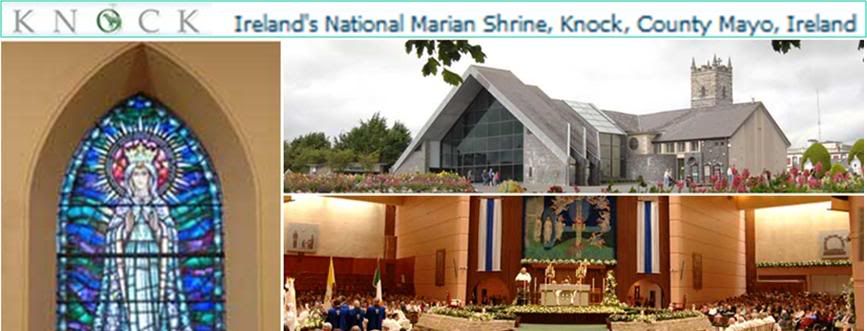 Nuncio Brown on the future
Nuncio Brown on the future
of the Church in Ireland

August 23, 2012
The site of the Irish Bishops' conference has posted the text of the homly delivered by Archbishop Charles Brown, Apostolic Nuncio to Ireland, at the concluding Mass yesterday of the National Novena in Knock, Ireland's major Marian shrine.
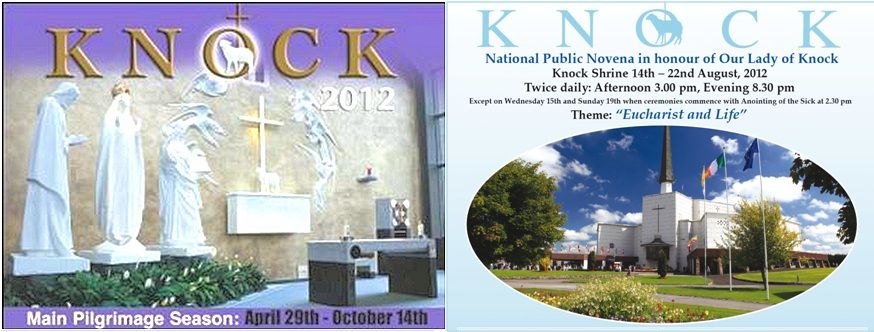
Your Excellencies… Father Richard Gibbons [Parish Priest of Knock], my fellow priests, dear men and women religious, beloved brothers and sisters in Jesus Christ.
It is truly an honour and a joy for me to be here with you today on the final day of the National Novena at Our Lady’s Shrine in Knock.
When Blessed John Paul II came here on September 30, 1979, to celebrate Holy Mass, he began with the words: “Here I am at the goal of my journey to Ireland: the Shrine of Our Lady of Knock” and, in a certain sense, his words are true for all of us here today, as we celebrate the conclusion of the National Novena; we too have come to the goal of our journey.
We come as pilgrims to pray at the feet of Mary, the humble girl of Nazareth, the glorious Mother of God, the “woman clothed with the sun” who appeared here in 1879 to comfort and console the Catholic people of Ireland.
The passage of time tends to make us forget what things were like in Ireland when Mary appeared. Ireland was not yet a free and independent nation; close to a million people had suffered and died during the Great Famine thirty years previously, and in the year 1879 when Mary appeared, hunger had returned to the West of Ireland. Huge numbers of Irish people had been forced to leave as immigrants, never to return, so much so that the population of Ireland plummeted by something like 25 per cent.
And so it was that, in those very bad times, Mary appeared, to comfort and to console and – although she never spoke a word – to lead her people, to direct her children to the Lamb on the altar, the Lamb who was slain but who now is alive, the “Lamb of God who takes away the sins of the world”.
Yes, the times in which Mary appeared here in Knock were very bad, and yet it bears noting that the century which followed the apparition would be marked by an extraordinary flourishing of the Catholic Church in Ireland, with huge numbers of vocations to the priesthood and religious life and a deep Christianisation of all aspects of society. Such a flourishing would have seemed impossible in 1879. But the night is often darkest before the dawn.
When we reflect on Our Lady’s apparition at Knock and the historical circumstances in which it occurred, we cannot help thinking about our times and our own future. Certainly, there are reasons for discouragement.
It seems as if every few months, a new survey is released showing, or purporting to show, that the Catholic faith is disappearing in Ireland. We have had two decades of scandals, crimes and failures. ‘The Church is finished!’ seems to be the cry heard everywhere.
But, my brothers and sisters, let me tell you what I have seen and heard (cf. 1 John 1:3). Two months ago, I saw the International Eucharistic Congress in Dublin exceed everyone’s expectations, with tens of thousands of people coming to learn more about the central mystery of our faith – the real presence of Jesus in the Eucharist.
One month ago today, I was in Ballyvourney in County Cork, where I had the joy of ordaining a young man to the priesthood. The small country church was filled with people young and old; the liturgy was celebrated in a beautiful way, with music and hymns in the Irish language. The sanctuary was packed with more than eighty good and faithful priests, many very young, some quite old, all of them there to welcome and to support their newest brother in the priesthood.
Three weeks ago, in County Mayo, I saw thousands of pilgrims climbing Croagh Patrick on Reek Sunday. Many young people. Many men. Some climbing in bare feet. I saw hundreds of people that day going to confession to the priests on the top of the mountain.
Ten days ago, I was at Clonmacnoise and I saw literally hundreds of young people kneeling in adoration in front of Jesus in the Blessed Sacrament, praying the Rosary, confessing their sins, rejoicing in the liberating love of God, and sharing the joy and excitement of being Catholic with their peers.
That, my brothers and sisters, is the future of the Church in Ireland.
So what is this future going to be like? Before all else, I would say that the future needs to be authentically Catholic if there is to be a future. We need to propose the Catholic faith in its fullness, in its beauty and in its radicality, with compassion and with conviction. We need to be unafraid to affirm the elements of the Catholic way which secular society rejects and ridicules.
I believe that the Gospel for today’s Mass points the way for the future of the Church in Ireland. Jesus speaks to his disciples about priorities. He tells us not to worry about things like what we are to wear and what we are to eat, or about how much money we can amass. He says put first things first: “Seek first the Kingdom of God and his righteousness, and all these other things will be given you as well” (Mt 6:33).
And what is this Kingdom of God proposed by Jesus? It cannot be identified with a worldly kingdom. As Jesus says in front of Pontius Pilate, “My Kingdom is not of this world” (John 18:36). It is a Kingdom which only reaches its fulfilment and fruition in the life of the world to come, as described in our first reading from the Book of the Apocalypse. Only in the end, will the Kingdom be complete: “a new heaven and a new earth”, the heavenly city, the New Jerusalem.
That city – to paraphrase Pope John Paul II’s words about Knock – is the goal of our journey. If we seek that city, that goal, that Kingdom, then everything else will be taken care of. But that Kingdom of light and joy is not only a future reality, it is also anticipated, made real in advance, wherever Jesus Christ is truly present in our world, in the celebration and adoration of the Holy Eucharist, in the sacraments and in the love we have for one another.
As the Church in Ireland moves into the future, we need to recognise that everything the Church does is somehow related to that reality: the reality of salvation.
Pope Benedict XVI has instituted a number of initiatives designed to help the Church move into the future. He has established an office for the New Evangelisation, which means finding new ways of presenting and communicating the ancient faith, especially in those countries like Ireland which were first given the gift of Catholic faith many centuries ago.
The Holy Father has called a Synod of Bishops, that is, a meeting of Bishops in Rome, which will take place in October of this year, in order to have Bishops from all over the world reflect on this most critical question.
And thirdly, Pope Benedict has established a “Year of Faith”, which will also begin this October, on the fiftieth anniversary of the opening of the Second Vatican Council.
Pope Benedict writes: “We want to celebrate this Year in a worthy and fruitful manner. Reflection on the faith will have to be intensified, so as to help all believers in Christ to acquire a more conscious and vigorous adherence to the Gospel, especially at a time of profound change such as humanity is currently experiencing. We will have the opportunity to profess our faith in the Risen Lord in our cathedrals and in the churches of the whole world; in our homes and among our families, so that everyone may feel a strong need to know better and to transmit to future generations the faith of all times” (Porta fidei, 8).
The Holy Father is insistent on this point. If we are indeed to “transmit to future generations the faith of all times,” we need to deepen our own understanding of that faith. In calling for the Year of Faith, the Holy Father has also indicated a means for deepening our understanding of the faith.
The opening day of the Year of Faith (October 11, 2012) is not only the fiftieth anniversary of the opening of the Second Vatican Council, it is also the twentieth anniversary of the publication of the Catechism of the Catholic Church, which is a magnificent summary and synthesis of the Catholic faith.
The Holy Father recommends that we study the Catechism as part of the Year of Faith. He describes the Catechism as a means of encountering the person of Christ. Remarkably, he writes “on page after page, we find that what is presented here is no theory, but an encounter with a Person who lives within the Church” (Porta fidei, 11). That Person is Jesus Christ, God made man.
Here in Ireland, the recently published National Directory for Catechesis of the Bishops of Ireland, entitled Share the Good News, also recommends that Catholics “consider setting up a [study] group to look at the Catechism over a period of time”… “like a book club taking a night to discuss a particular section read beforehand” (page 74). This is a great idea, which would have a very positive effect on the future life of the Church in Ireland.
Brothers and sisters, the future of the Church in Ireland begins now. We have all been revitalised in our faith by the unforgettable experience of the International Eucharistic Congress, which, pray God, has marked a turning point in the life of the Church in Ireland.
Certainly, the road ahead is not an easy one, but the road ahead for Catholics in Ireland did not look very easy in 1879 when Our Lady appeared here on that rainy evening in August. And yet her appearance was followed by one of the most fruitful periods in the fifteen centuries of Catholicism on this Island.
Yes, brothers and sisters: “Seek first the Kingdom of God and his righteousness, and all these other things will be given you as well” (Mt 6,33).
Here's some background about this little-known manifestation of the Mother of God:
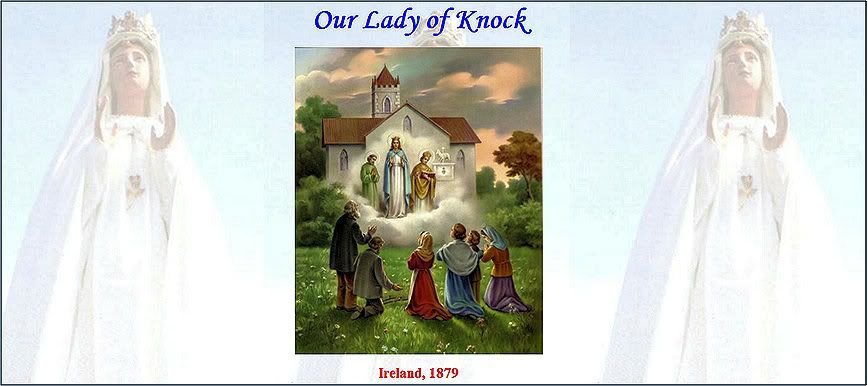 The Apparition at Knock took place on 21st August, 1879, eight years after Pontmain in 1871. The two apparitions are broadly similar, in that they both took place in the evening and only lasted for three hours or so, and similarly, in both, no words were spoken.
The Apparition at Knock took place on 21st August, 1879, eight years after Pontmain in 1871. The two apparitions are broadly similar, in that they both took place in the evening and only lasted for three hours or so, and similarly, in both, no words were spoken.
On the evening of Thursday, 21 August 1879, two women from the small village of Knock, Mary McLoughlin and Mary Beirne, were walking back to their home in the rain when they passed by the back of the town church. There against the wall of the church stood the Blessed Virgin Mary, St. Joseph, St. John the Evangelist, and an altar with a lamb and a cross on it. Flying around the altar were several angels.
The women called several other people to the church. They too saw the apparition. What they and thirteen others saw in the still-bright day was a beautiful woman, clothed in white garments, wearing a large brilliant crown. Her hands were raised as if in prayer. This woman was understood by all who saw her to be the Blessed Virgin Mary, the Mother of Jesus and the Queen of the Angels.
Other villagers, who were not involved with the apparition, nonetheless reported seeing a very bright light illuminating the area around where the church was located. There were subsequent reports of inexplicable healings associated with visits to the church at Knock.
Ten days after the first apparition, the first cure occurred. A young girl, born deaf, was instantly given the gift of hearing. At the end of 1880, some 300 cures, apparently miraculous, had been recorded in the diary of the parish priest.
One of the pilgrims, who had been cured soon after the apparition, testified many years later that he had seen "as many as half-a-dozen pilgrims simultaneously undergoing their cure, or getting relief, and in vision I see the lame walk, my case included, the sightless seeing, the withered skins smoothening."
As the news spread, pilgrims by the thousands arrived here with their sick. A large number of unusual cures were reported. Those who claimed a cure left their crutches and canes at the site, and many of those supports were attached to the wall. Pilgrims snatched plaster and bits of cement off the apparition wall for relics in 1879 and the 1880s.
In the fall of 1880, a statue of Our Lady of Knock was erected where she had been seen during the vision. This place in Ireland had become a place for pilgrimage: one-and-a-half million visitors trek there annually.
The Church response to this series of events was typically circumspect. The Church officially investigated the apparition at Knock in 1879, and again in 1936. It was found that the witnesses were believable and that there was nothing contrary to the faith. A record of purported cures and devotional material was maintained until 1936. At that time, the head of the diocese of Tuam, Archbishop Gilmartin, authorized the publication of a pamphlet supporting devotion to the apparition at Knock.
Four recent popes have honored Knock. Pius XII blessed the Banner of Knock at St. Peter's and decorated it with a special medal on All Saints' Day, 1945. It was the Marian year. On this occasion, the Pope announced the new feast of the Queenship of Mary.
Pope John XXIII presented a special candle to Knock on Candlemas Day in 1960. He had always regarded it as one of outstanding shrines devoted to Our Lady. Pope Paul VI blessed the foundation stone for the Basilica of Our Lady, Queen of Ireland, on June 6, 1974.
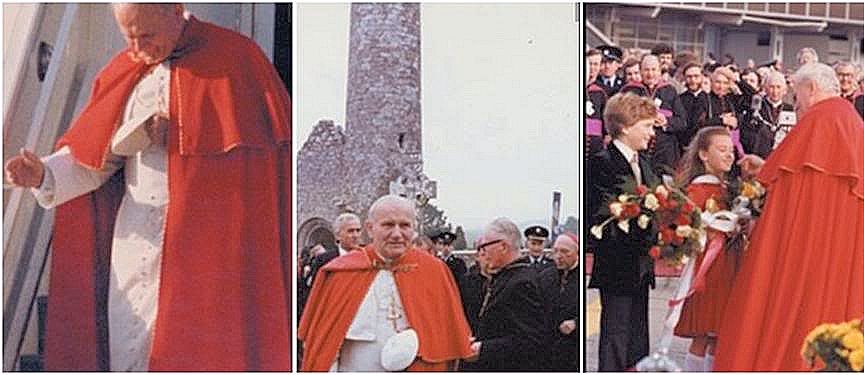 Pope John Paul II made a personel pilgrimage to the Shrine on Sept. 30, 1979. He addressed the sick and the nursing staff, celebrated Mass, established the shrine church as a basilica, presented a candle and the golden rose to the shrine, and finally knelt in prayer at the apparition wall.
Pope John Paul II made a personel pilgrimage to the Shrine on Sept. 30, 1979. He addressed the sick and the nursing staff, celebrated Mass, established the shrine church as a basilica, presented a candle and the golden rose to the shrine, and finally knelt in prayer at the apparition wall.
Knock was different from other approved apparitions in many ways. The first difference is the number of figures in the apparition. Usually, only Mary appears. The second difference is the lack of a verbal message. In all of the other apparitions, Mary appears with a request or a warning. Another difference is the large number of people that saw the apparition.
Apparitions are typically seen by no more than five people. Finally, the apparition was very brief. It only occurred once, for a two hour duration. Other Marian apparitions involved multiple visitations.
The Irish people have always understood that the Blessed Virgin Mary was a human being, a sister to humankind, as well as mother. However, she is the mother of Jesus Christ, and therefore, the mother of God. She has no power of her own, but she is, and always will be, the mother of God made man. She has been assumed into heaven, but sometimes she comes back to earth as a heavenly messenger, sent by her Son. When the Virgin Mary speaks, she brings no new messages, nothing that is not contained in the biblical teachings of Jesus. The Virgin Mary represents Him to us, and she calls upon us to have sorrow for sin, to repent and turn to God.
Mons. Brown's hopeful portrait of Catholics in Ireland today comes just as the Rome correspondent of an Israeli newspaper has filed a highly inflammatory article
www.ynetnews.com/articles/0,7340,L-4271916,00.html
claiming that the appointment of Mons. Giuseppe Lazzarotto as the new Apostolic Nuncio to Israel is a 'slap in the face to Israel' because the new Nuncio was the papal representative to Ireland in 2000-2007. The correspondent cites false allegations by the Irish government that the Nuncio refused to cooperate with the Murphy Commission hich investigated sex abuses committed by Irish priests against children and minors; as well as the wild unfounded charges made in the Irish Parliament by the Irish Prime Minister in July last year.
[Modificato da TERESA BENEDETTA 23/08/2013 14:42] |
| |
 23/08/2013 20:10 23/08/2013 20:10 |
|
| | | OFFLINE | | Post: 27.041
Post: 9.517 | Registrato il: 28/08/2005
Registrato il: 20/01/2009 | Administratore | Utente Master | |
|
 I don't have the time to translate it yet, but Angela Ambrogetti says in a report today on korazym.org that very likely, the members of the Ratzinger Schuelerkreis who are holding their annual seminar-reunion in Castel Gandolfo from Aug. 31 to Sept. 3, will take part in a Mass with Benedict XVI at his Mater Ecclesiae retirement home. It was announced earlier that because of his retreat from the public eye, their ex-Professor will not be attending this year's event, for the first time since it began in 1977. The rest of Ambrogetti's article is a backgrounder on the Schuelerkreis and a description of the reunion-seminars they held with Benedict in Castel Gandolfo for eight summers, from 2005 to 2012.
I don't have the time to translate it yet, but Angela Ambrogetti says in a report today on korazym.org that very likely, the members of the Ratzinger Schuelerkreis who are holding their annual seminar-reunion in Castel Gandolfo from Aug. 31 to Sept. 3, will take part in a Mass with Benedict XVI at his Mater Ecclesiae retirement home. It was announced earlier that because of his retreat from the public eye, their ex-Professor will not be attending this year's event, for the first time since it began in 1977. The rest of Ambrogetti's article is a backgrounder on the Schuelerkreis and a description of the reunion-seminars they held with Benedict in Castel Gandolfo for eight summers, from 2005 to 2012.
P.S. Actually, Andrea Gagliarducci had a far more informative earlier article for CNA, so I will go with that now...
Benedict XVI's students will meet
to discuss God in an age of secularism
By Andrea Gagliarducci

ROME, Aug 21, 2013 (CNA/EWTN News).- The annual meeting of Benedict XVI's students from his time at the University of Regensburg [not just from his time at regensburg, but from Bonn, Muenster and Tuebingen, as well!] will gather next week to discuss “the question of God,” though the former Pope will not be joining them.
“Since he is retired, he does not want to attend any more public meetings,” Father Joseph Fessio, founder of Ignatius Press and a member of the group, told CNA Aug. 20.
“The circle of students will meet in Castel Gandolfo, as usual, and then they will all go to the Vatican,” he explained, “where they will participate in a Mass celebrated by the Pope Emeritus in the monastery of Mater Ecclesiae.”
The “Ratzinger Schuelerkreis,” or “students' circle,” has met to discuss topics in theology and the life of the Church since 1977, when their professor was pulled from academia to become a bishop.
This year's meeting will be held Aug. 29 to Sept. 2, and will discuss the topic of “the question of God against the background of secularization.” Benedict XVI chose the topic, as well as the primary resource person, French philosopher Rémi Brague [winner of one of the Ratzinger Prizes for Theology in 2012].
Fr. Fessio said that “the idea of the annual meetings arose when Joseph Ratzinger was appointed Archbishop of Munich and Freising” in 1977.
When he moved to Rome to take up the post of prefect of the Congregation for the Doctrine of the Faith in 1981, the annual event continued.
When in the spring of 2005, Cardinal Ratzinger was chosen as Pope, his former students thought that their annual tradition would stop, but were proved wrong.
Fr. Fessio recounted that “Pope Benedict said he was pleased to continue meeting with us.”
The Ratzinger Schuelerkreis is formed by about 50 people who studied for their doctorates under Ratzinger, but usually between 25 and 30 are able to make it to any year's meeting.
However, the 2005 meeting was “crowded with all the members, and so it was a little more formal because there were more people than usual.”
The schuelerkreis discusses a different topic of their mentor's choosing each year; the last meeting discussed ecumenism.
Fr. Fessio became a pupil of Ratzinger during the 1970s, when he went to Regensburg to conclude his studies in theology.
He had earned a master's in theology in 1972 under the supervision of Henri de Lubac, whose thought greatly shaped the Second Vatican Council.
After completing his studies in Lyon with de Lubac, Fr. Fessio asked for a suggestion of what to write this doctoral dissertation on, as well as under whom.
“De Lubac told me that one of the most important theologians of history, and maybe the most important theologian ever, was Hans Urs von Balthasar.”
“And he added that the best person who could supervise a thesis on von Balthasar was the young professor Ratzinger in Regensburg, and he sent him a recommendation letter to receive me among his students.”
The year Fr. Fessio completed his studies under de Lubac, the three professors – de Lubac, von Balthasar, and Ratzinger – founded the theological journal Communio, which is now published in 14 international editions and stands for a renewal of theology in continuity with the living Christian tradition.
Under Ratzinger's supervision, Fr. Fessio wrote his dissertation “The Ecclesiology of Hans Urs von Balthasar” and graduated with a Ph.D. in 1976.
“Professor Ratzinger was exactly the way we learned to know him as Pope: simple, humble, clear in exposition, cultivated. One of the best professors I have ever met.”
Discussing Benedict XVI's resignation this spring, Fr. Fessio said, “I was not surprised, since he spoke about this option with the journalist Peter Seewald, in the book Light of the World’
Fr. Fessio maintained that the “decision to resign has been a decision of great 'modernity', and the Pope showed humility and courage in making it.”
He added that “none of us in the circle could be in any way surprised by the modernity of Benedict XVI. I have attended several meetings of the Schuelerkreis, and every time Joseph Ratzinger had something new to say, something that no one had explored, or ever thought before.”
Have you ever wondered if Hans Kueng, certainly a highly celebrated professor in his prime, ever had a Schuelerkreis develop around him? And if not - and apparently not - why not?
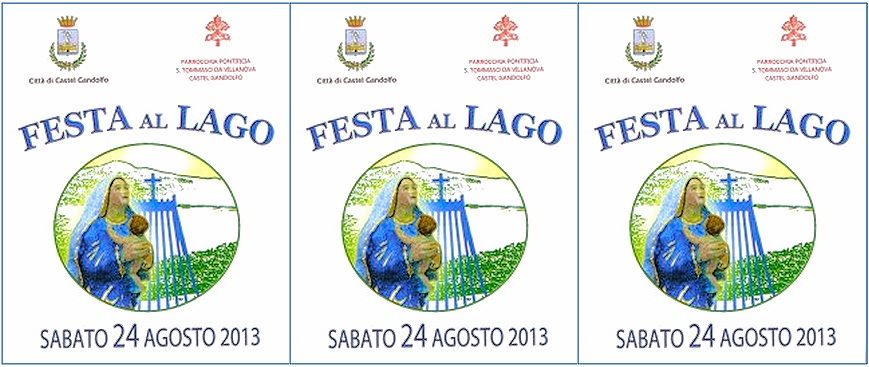 Mons. Gaenswein to say Mass
Mons. Gaenswein to say Mass
on the Feast of the Madonna
of Lake Albano in Castel Gandoifo
Meanwhile, VATICAN INSIDER reports that Mons. Georg Gaenswein, prefect of the Pontifical Household, will preside at a Mass tomorrow evening to celebrate the 36th anniversary of the inauguration of a church dedicated to the Madonna del Lago (Our Lady of the Lake) on the shores of Lake Albano. It is under the pontifical parish of San Tommaso Villanova which has its parish church on the town square near the Apostolic Palace.
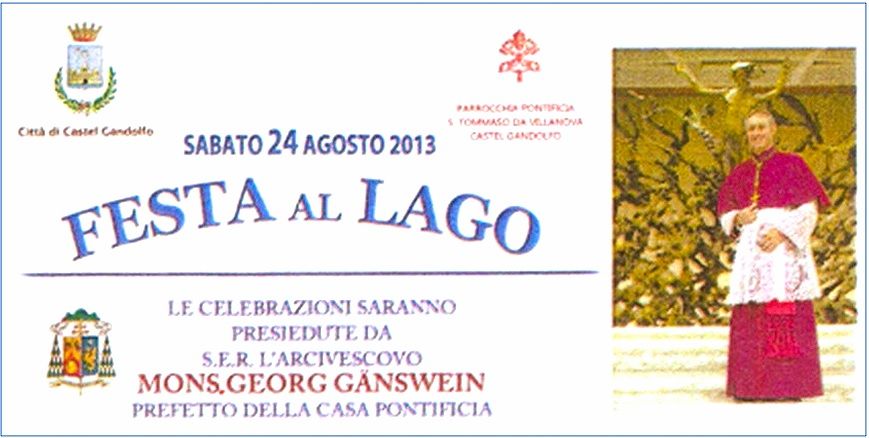
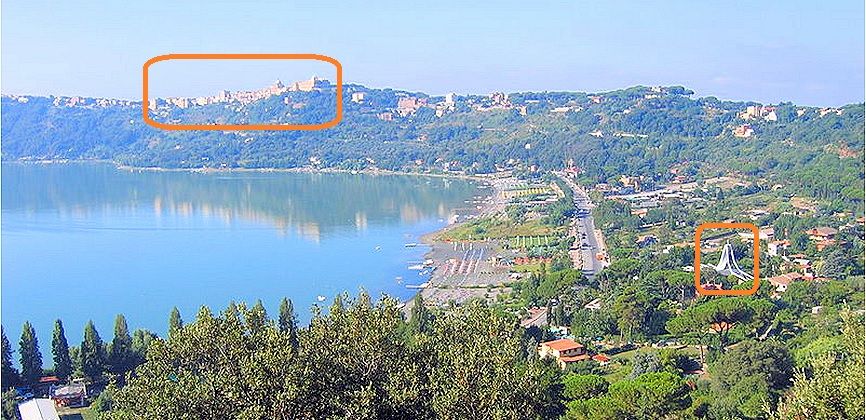
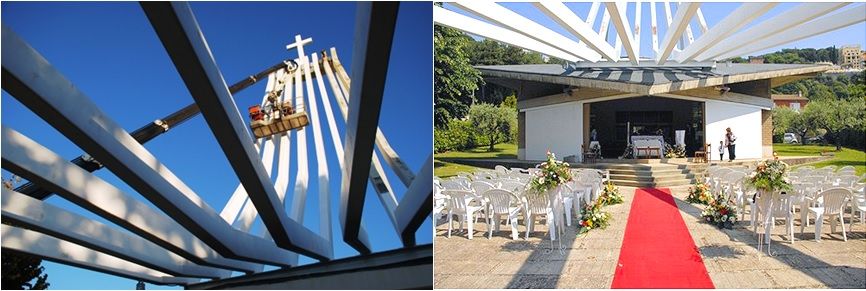
The church was ordered built by Paul VI, and he inaugurated it less than a year before hie died. The Mass will be followed by a procession of the image through Castel Gandolfo, after which it will be mounted on a boat for a second water-borne procession on the lake.
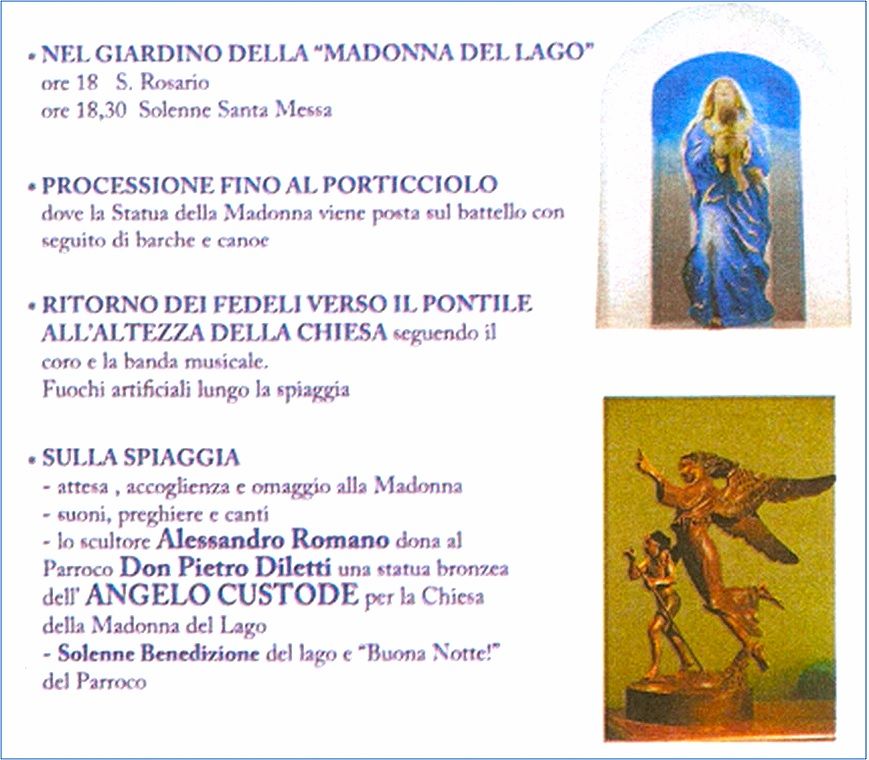

[Modificato da TERESA BENEDETTA 24/08/2013 07:31] |
| |
 24/08/2013 00:39 24/08/2013 00:39 |
|
| | | OFFLINE | | Post: 27.042
Post: 9.518 | Registrato il: 28/08/2005
Registrato il: 20/01/2009 | Administratore | Utente Master | |
|
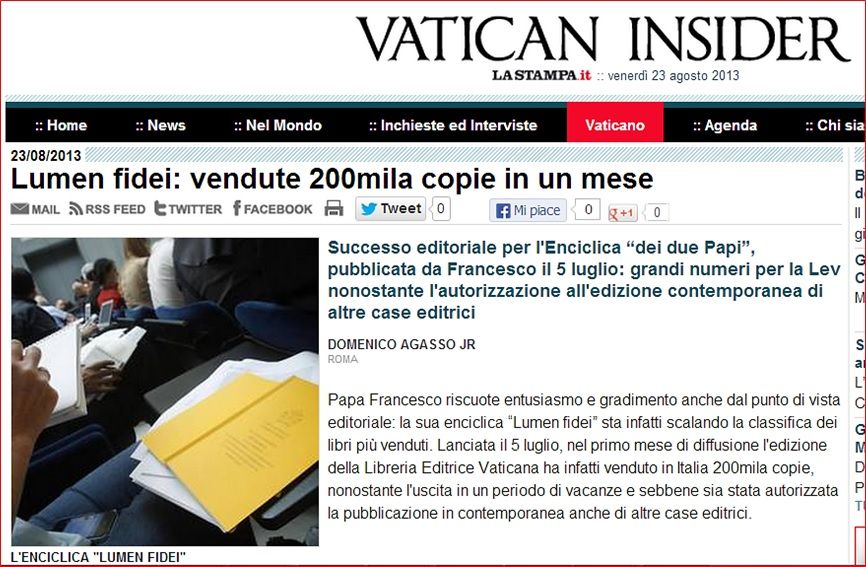 So now we know... I had been wondering at the lack of reports on the sales of the encyclical Lumen fidei, as well as the lack of any photograph online of Pope Francis signing his first encyclical, as one might see from the image results for a Google search of 'Pope Francis signs first encyclical' [only the top part shown here], unthinkable for the most popular Pope in history.
So now we know... I had been wondering at the lack of reports on the sales of the encyclical Lumen fidei, as well as the lack of any photograph online of Pope Francis signing his first encyclical, as one might see from the image results for a Google search of 'Pope Francis signs first encyclical' [only the top part shown here], unthinkable for the most popular Pope in history.
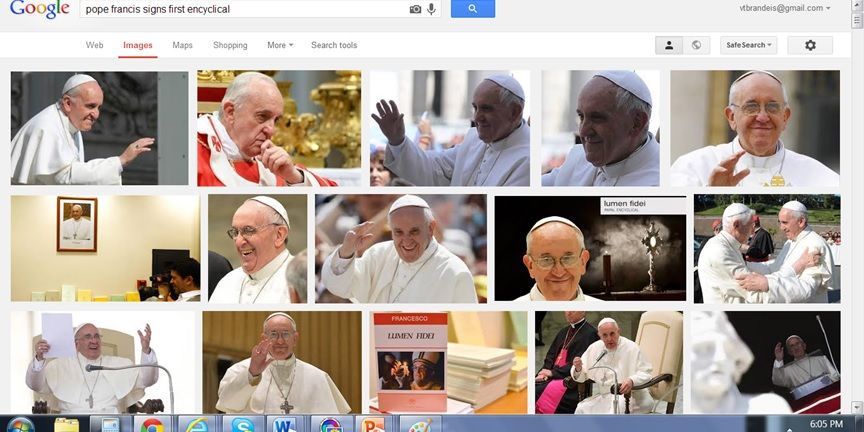
One would think the world should share such a historic photo, but perhaps, PF is too modest for such photo-ops and finds it vain. I shall translate only the lead paragraphs of the INSIDER story (which does not appear in its English edition), because the rest of it is background stuff meant to underscore the Pope's authorship of the encyclical:
'Lumen fidei':
200,000 sold in first month
by DOMENICO AGASSO JR
Translated from the Italian service of

August 23, 2013
A publishing success for the 'encyclical by two Popes', published by Pope Francis on July 5. Great numbers for the Vatican publishing house LEV despite simultaneous editions by other publishers.
Pope Francis has been earning enthusiasm and approval even by publishing standards: his encyclical Lumen fidei is in fact in the list of the best-selling books in Italy today.
Since it was launched on July 5, LEV alone has sold 200,000 copies in its first month of release, although it was released during a vacation month and other publishing houses have also been authorized to publish it....
[The article does not mention the publishing success of Benedict XVI's first encyclical, so I looked back and here are a couple of reports from that time, from the 'POPE-POURRI' thread of the PAPA RATZINGER FORUM. I had very little facility for reproducing graphics and for photo usage at the time, so the accounts are truly 'bare bones'...]

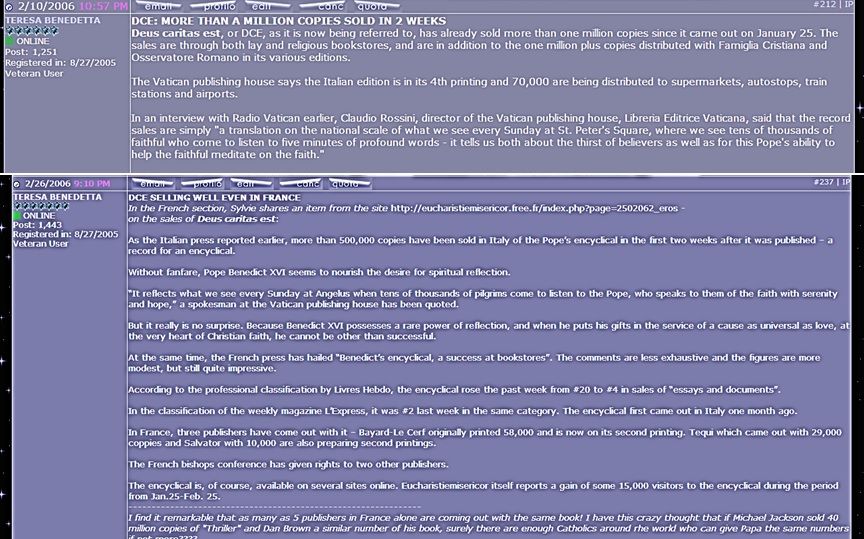
 I will look further for similar reports on the initial sales for Spe salvi and Caritas in veritate. I recall they were just as impressive. Personally, I am disappointed that the faithful who did rush to buy the sold-out initial printings of Benedict XVI's encyclicals didn't do the same thing for Lumen fidei, which is 'his' encyclical, too, after all. And that Pope Francis's own legion of devotees have not stampeded the bookstores to set yet another 'popularity' record for PF. I wonder why... .
I will look further for similar reports on the initial sales for Spe salvi and Caritas in veritate. I recall they were just as impressive. Personally, I am disappointed that the faithful who did rush to buy the sold-out initial printings of Benedict XVI's encyclicals didn't do the same thing for Lumen fidei, which is 'his' encyclical, too, after all. And that Pope Francis's own legion of devotees have not stampeded the bookstores to set yet another 'popularity' record for PF. I wonder why... .
[Modificato da TERESA BENEDETTA 24/08/2013 13:01] |
| |
 24/08/2013 02:30 24/08/2013 02:30 |
|
| | | OFFLINE | | Post: 27.043
Post: 9.518 | Registrato il: 28/08/2005
Registrato il: 20/01/2009 | Administratore | Utente Master | |
|
 After his thought-provoking piece on poverty and the Christian attituDes towards it, Fr. Schall now turns his attention to another 'cliche of faith', for want of a better term, that we hardly ever bother to examine, namely, the idea of loving everybody...
On loving everybody – and nobody
After his thought-provoking piece on poverty and the Christian attituDes towards it, Fr. Schall now turns his attention to another 'cliche of faith', for want of a better term, that we hardly ever bother to examine, namely, the idea of loving everybody...
On loving everybody – and nobody
By James V. Schall, S.J.

20 AUGUST 2013
Joseph Wood once asked me why I so highly esteem Samuel Johnson. Basically, I think that, if someone reads him, he has little other choice. In watching Pope Francis greet people, an issue comes up that Johnson addressed.
The pope, along with many politicians, spends much time engaging people, touching them, making them feel known to him. Pope Wojytla was a genius at this. To the despair of police and those directing him to his next engagement, such figures insist on chatting with almost anyone and everyone.
We are urged to love our neighbor as our selves. But the minute we try to do this, we run up against the Aristotelian caution that “he who is a friend of everybody is a friend of nobody.” It is for this reason, among others, that we suspect that popes and politicians are rather lonely people.
We increasingly hear it said of the president [Obama], greeter that he is on every stage, that “he seems to have no friends.” Kings are said to have no friends but other kings.
This same issue came up in Boswell’s recording (April 15, 1778) of Johnson’s conversation with “the ingenious Quaker lady,” Mrs. Knowles, with whom Johnson seems to have been a bit smitten. Evidently, Mr. Soame Jenyns had written a book, Views of the Internal Evidence of the Christian Religion, in which he remarked that “friendship is not a Christian virtue.” Mrs. Knowles vigorously objected to this view.
But Johnson agreed with Jenyns. “Why, Madam, strictly speaking, he is right. All friendship is preferring the interest of a friend, to the neglect of, or, perhaps, against the interest of others. . . .Now, Christianity recommends universal benevolence, to consider all men as our brothers, which is contrary to the virtue of friendship.” Johnson next recalls the classic name given to the Quakers: “Surely, Madam, your sect must approve of this; for you call all men ‘friends.’”
Mrs. Knowles responds to Johnson: We are “commanded” to call all men our friends, especially those of the “household of the faith.” Johnson replies that this “household” is “very large” – meaning that such friendships must be quite diffused. To this, Mrs. Knowles observes that Christ had twelve apostles but He loved one the best. Johnson answers, “with eyes sparkling benignantly, 'Very well, indeed, Madam. You have said very well.”
- Dr. Johnson among friends: The Club, c. 1780
This passage always reminds me of the curious impact of Christian revelation on human relationships. Aristotle knew the differing kinds of friendship – of utility, of pleasure, and those based on the highest kind of virtue.
We would be fortunate if, during our lifetime, we had one or two good friends. We know that it takes a whole lifetime just to know some one person well. Does Christianity deny this? As Mrs. Knowles implied, Christianity wants it both ways, to love everyone as friends and to keep the intimacy of a few friends. This fact means that we must keep things straight.
Is there any sense in thinking that we can be friends with everyone or even of those of the “household of the faith?” Many of the problems such considerations bring up were already in Plato. In the Republic, he wanted to destroy the family because its inner relationships were exclusive. They tended to separate everyone into small groups.
Yet the separation of friends into a small group is the very essence of the highest forms of friendship in which we live together in life and conversation. Plato too wanted everyone to be friends. This is precisely where Aristotle stepped in to warn of the dangers of thinking of everyone could be our friends in this world. Plato and Christianity had the same end: that we all be friends.
We are told that in Paradise, there is neither marrying nor giving in marriage, the most obvious example of exclusive and permanent friendship. Does this teaching mean that no marital friendships are found in heaven? It means that no further begetting takes place once the full number of elect is completed.
But were Johnson’s initial remarks right about Christianity? Does it absolve the bonds of friendship? Is this desire that we see in the popes to greet and know everyone, to urge us to be friends with everyone, an illusion?
Christianity teaches that anyone can be our friend, not just those of our city or household. Then there is the little issue of loving our enemies and those who hate us. But we are not to be naïve.
Christianity does not overturn Aristotle. What it does tell us is to find what is loveable in everyone, to recognize that we are all loved by God. All our lives are but introductions, glimpses of that eternal life in which we, finally, have the abiding presence to know and love those who respond to God’s call of everyone to Himself.
"Such figures insist on chatting with almost anyone and everyone", Fr. Schall observes above about gregarious public figures like Popes John Paul II and Francis, the latter perhaps to a more literal degree than any previous Pope, as evidenced by the latest anecdote about his penchant for calling people on the telephone. A truly unusual gesture for any Pope to make, probably Francis's most disarming trait - and a most remarkable privilege for the recipient of the call. If it had been done before Pope Francis, it certainly has not been reported.
US Presidents have made it an admirable custom to call up various US servicemen around the world on occasions like Thanksgiving or Christmas or Memorial Day, and have been known to call ordinary folk to express their personal condolences after a major tragedy, but they don't generally call people out of the blue as Pope Francis does (Obama recently caused a furor when he called to congratulate a football player who admitted publicly that he was gay, but he had a 'news excuse' for doing so)...
This gushy story, which recounts quite a few of those now-famous phone calls from the Pope is from the UK Guardian which never had a good word for Benedict XVI (except in a rare commentary by one of their contributors, not staffers)...
Unstuffy Pope Francis rings
Italian teenager for a chat
IT student from Padua 'lost for words' when Francis called
after receiving his letter and asked him to use informal 'tu'
by Tom Kington

August 22, 2013
An Italian teenager who wrote to Pope Francis was shocked when the informal Argentinian pontiff phoned him for a chat.
In the latest of series of calls made by Pope Francis which embody his unstuffy style, the pontiff rang Stefano Cabizza, an IT student from Padua, for a jokey conversation after the youth wrote to him about his life and his hopes of finding a job after graduating.
Cabizza reported he was lost for words when a voice said: "This is Pope Francis."
"I couldn't believe it. We laughed and joked for eight minutes," he told Italian newspaper Il Gazzettino, adding: "It was certainly the best day of my life."
Francis started by asking Cabizza to address him using the informal Italian word 'tu', rather than the more formal 'lei'.
Cabizza reported Francis reminded him Jesus and the apostles used 'tu'. "They were friends as you and I are now and I am used to using 'tu' with friends," Cabizza said Francis told him.
The student said Francis blessed him and asked him to pray for him.
The pope had already called him once, said Cabizza, but called back after missing him because he was out.
It was reported earlier this month that the pope had rung a man in central Italy who had written to him after his brother was murdered.
Michele Ferri, 40, said he had been stunned to pick up the phone and hear a voice say, "Ciao Michele, it's Pope Francis."
"He told me he had cried when he read the letter I had written him," Ferri said.
Francis's disregard for protocol was first evident days after his election as pope in March when he called his newsagent in Buenos Aires to cancel his newspaper subscription, explaining he was staying in Rome for good.
Francis needed to persuade the newsagent, Daniel Del Regno, that it was really him, and not a joke call. He also called his dentist to cancel an appointment.
The 76-year-old pope has sent shockwaves through the Vatican by his decision not to move into the papal apartment, instead taking a room at the busy residence at the Vatican where visiting prelates stay, and where he joins them for meals in the canteen. [It's not a canteen - it's the hotel restaurant!]
[Modificato da TERESA BENEDETTA 24/08/2013 14:51] |
| |
 24/08/2013 14:34 24/08/2013 14:34 |
|
| | | OFFLINE | | Post: 27.044
Post: 9.520 | Registrato il: 28/08/2005
Registrato il: 20/01/2009 | Administratore | Utente Master | |
|
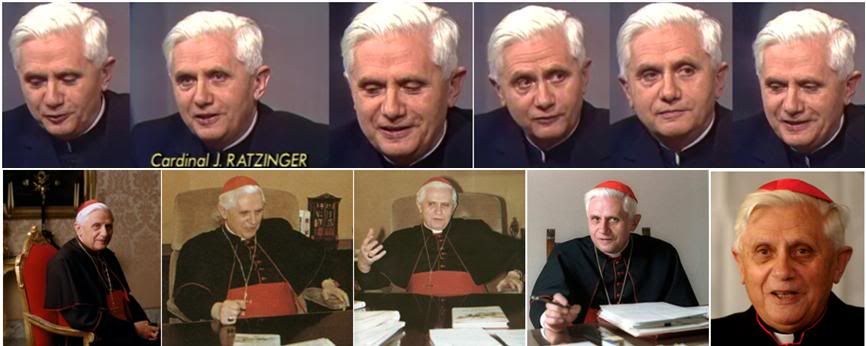 Re-reading Joseph Ratzinger's memoir:
Re-reading Joseph Ratzinger's memoir:
He reflects on Marxists, modernist theologians
and their 'elimination' of God as the Nazis did
by JOSEPH PEARCE

August 23, 2013
I've been spending a lot of time in the company of the Pope Emeritus lately, not literally of course. but within the pages of his books. I've been reading his memoirs, published when he was still known to the world as Cardinal Ratzinger, and was struck by his description of the unholy alliance between ideological Marxism and theological Modernism.
Shortly after Ratzinger’s joining the faculty at the University of Tübingen in 1966, the university succumbed to the madness of the 1960s. The philosophy of existentialism and the ideas of Heidegger, which had dominated the intellectual life of the university, were replaced by a Marxist ascendency.
“Existentialism fell apart,” wrote Ratzinger, “and the Marxist revolution kindled the whole university with its fervor, shaking it to its very foundations.”
More disturbingly, the theology faculty, which might have been expected to have resisted this Marxist tendency, became the very ideological epicenter from whence the earth-shattering and iconoclastic movement had emanated.
Ratzinger considered the development nothing less than “the destruction of theology”, the inversion of Christian hope so that religious fervor is directed towards political action to the exclusion and elimination of the role of God:
Hope remains, but the party takes the place of God, and, along with the party, a totalitarianism that practices an atheistic sort of adoration ready to sacrifice all humanness to its false god.
I myself have seen the frightful face of this atheistic piety unveiled, its psychological terror, the abandon with which every moral consideration could be thrown overboard as a bourgeois residue when the ideological goal was at stake.
All of this is alarming enough in itself; but it becomes an unrelenting challenge to the theologian when the ideology is presented in the name of the faith and the Church is used as the instrument.
The blasphemous manner in which the Cross now came to be despised as a sign of sadomasochism, the hypocrisy with which some still passed themselves off as believers when this was useful, in order not to jeopardize the instruments that were to serve their own private ends: all of this could and should not be made to look harmless or regarded as just another academic quarrel.
Since, at the height of these debates, I was dean of my faculty [in Regensburg] … and a member also of the commission in charge of designing a new constitution for the university, I experienced all these things at very close range indeed.
Although Ratzinger was referring to the Marxist upheaval in the academy in the late 1960s, one can’t help but see the shadow of the Nazi past in his description of his experience at the University of Tübingen [and Regensburg, to which he moved during that fateful year of 1968, and where he was given higher administrative responsibilities in addition to his academic load].
As a child in 1930s Germany, Ratzinger had seen “the frightful face of this atheistic piety unveiled, its psychological terror, the abandon with which every moral consideration could be thrown overboard as a bourgeois residue when the ideological goal was at stake”.
He had already lived in a culture in which “the party takes the place of God, and, along with the party, a totalitarianism that practices an atheistic sort of adoration ready to sacrifice all humanness to its false god”.
He had, as a child, “experienced all these things at very close range indeed” and one can only wonder at what he must have thought and felt as he seemed to see history repeat itself.
As his Marxist and modernist colleagues on the theology faculty were declaring the death of God, he must have been seeing the resurrection of Big Brother.
Pearce is a familiar name to those who follow Ignatius Insight and even more to those who have read his books. The Ignatius Press author page on him informs us that "Twenty-five years ago he was a radical activist, a skinhead, and the editor of two hate-filled, extremist magazines". Today, the London-born Pearce is the author of several critically acclaimed, best-selling biographies of great nineteenth- and twentieth-century Christian authors, as well as two books on Shakespeare. He is also the co-founder and co-editor of an international magazine dedicated to reclaiming Catholic culture (the St. Austin Review), and currently Writer-in-Residence and Professor of Humanities at Thomas More College of Liberal Arts in Merrimack, New Hampshire.
|
| |
 24/08/2013 15:33 24/08/2013 15:33 |
|
| | | OFFLINE | | Post: 27.045
Post: 9.521 | Registrato il: 28/08/2005
Registrato il: 20/01/2009 | Administratore | Utente Master | |
|
 What a welcome fresh look this is at the seemingly universal 'gender revolution', its underlying and overriding ideology, and its far-reaching consequences for bringing down the basic insitutions and principles of natural law that have constituted the bedrock for human civilization as we have known it...
Revolutionizing the idea of family:
What a welcome fresh look this is at the seemingly universal 'gender revolution', its underlying and overriding ideology, and its far-reaching consequences for bringing down the basic insitutions and principles of natural law that have constituted the bedrock for human civilization as we have known it...
Revolutionizing the idea of family:
The Marxist roots of ‘homosexualism’
BY HILARY WHITE

August 23, 2013
I have been asked recently “what is homosexualism?” I started using the term in my writing on these issues a few years ago when it became clear that we were dealing not with a group of people, but with a particular ideology that is often held by people who are not themselves homosexuals.
A few days ago in The Guardian, Peter Tatchell wrote a pretty good description not only of that ideology’s goals but its origins. This political ideology, often called “queer theory” by its proponents in academia, is what is being pushed, quite openly these days, by the “gay rights” movement.
Despite what we are told all day by their collaborators in the mainstream media, from the six o’clock news to your favourite sit-com, this movement is not about “equal rights”. It is about re-writing the foundational concepts of our entire society. I predict that it will not be much longer before the pretense of “equality” is dropped, having done its work.
Many people are scratching their heads and asking how we have suddenly found ourselves at the point where two men can be “married,” a woman can be called a “husband” and a man, a “wife,” and children are reduced to political bargaining chips in the adoption wars, when it seems just yesterday we were only talking about equal rights. Since when do “equal rights” mean deconstructing, dismantling, these foundational social concepts?
If we read them closely, however, the activists themselves have begun to explain it in quite straightforward terms. For them, it has never been about “equal rights” but about the re-writing of our entire social order. The “gay rights” movement has always been, in Peter Tatchell’s own words, “revolutionary, not reformist.”
Others have pointed out the Marxist origins of the Sexual Revolution as a whole, and it is clear that the sudden explosion of homosexualism is merely the next logical step in a systematic programme.
A close cousin to radical feminism and grandchild of Marxism, homosexualism was developed out of the politico-academic pseudo-field of “gender studies” and has, for 30 or 40 years, been pushed on a mostly unwilling public, through “anti-discrimination” and “equalities” legislation by a coalition of lobbyists, NGOs and politicians on the extreme left, and in increasingly powerful international circles.
Peter Tatchell is a prominent British homosexualist, which means he is a proponent of a specific political and social ideology that he wants to see adopted in British society and elsewhere.
He is also a homosexual man, that is, he experiences sexual attraction for other men, a condition whose origin is still debated by doctors, psychiatrists and geneticists. The two things are not the same. This is a fact that tends to escape a lot of people who read and write about the Culture Wars, especially in its current manifestation that seems to have suddenly become all about homosexuality.
Not all homosexuals are homosexualists, and not all homosexualists are homosexuals.
Tatchell’s Guardian piece was a paean to a document put together in 1971 by what he describes as a collective of “anarchists, hippies, leftwingers, feminists, liberals and counter- culturalists” to bring about “a revolution in consciousness”.
He called the Gay Liberation Front: Manifesto “a pioneering agenda for social and personal transformation” that started with the proposal that “subverting the supremacy of heterosexual masculinity was the key to genuine liberation.” Tatchell said it was the book that changed his life.
The Manifesto sums it all up, Tatchell says, by “critiquing” “homophobia, sexism, marriage, the nuclear family, monogamy, the cults of youth and beauty, patriarchy, the gay ghetto and rigid male and female gender roles” … the whole kaboodle of the sexual revolution.
The Manifesto itself is quite blunt about identifying the main enemies to defeat: “The oppression of gay people starts in the most basic unit of society, the family.”
“Consisting of the man in charge, a slave as his wife, and their children on whom they force themselves as the ideal models. The very form of the family works against homosexuality.”
"The very form of the family works against homosexuality," says the Manifesto, professing that the only solution is a complete revolution in the social order.
Most tellingly, the Manifesto says that “reform,” in other words “equality,” is never going to be enough; what is needed is a total social revolution, a complete reordering of civilisation.
Reform, it said, “cannot change the deep-down attitude of straight people that homosexuality is at best inferior to their own way of life, at worst a sickening perversion. It will take more than reforms to change this attitude, because it is rooted in our society’s most basic institution - the Patriarchal Family.”
Far from being “the source of our happiness and comfort,” it says, the family is the oppressive “unit” in which the “dominant man and submissive woman” teach children “false beliefs” about traditional “gender roles” “almost before we can talk”.
The core concept of gender ideology is given: there is “no proven systematic differences between male and female, apart from the obvious biological ones. Male and female genitals and reproductive systems are different, and so are certain other physical characteristics, but all differences of temperament, aptitudes and so on, are the result of upbringing and social pressures. They are not inborn.”
“Human beings could be much more various than our constricted patterns of ‘masculine’ and ‘feminine’ permit - we should be free to develop with greater individuality.”
“Our entire society,” the Manifesto says, “is built around the patriarchal family and its enshrinement of these masculine and feminine roles. Religion, popular morality art, literature and sport all reinforce these stereotypes. In other words, this society is a sexist society, in which one's biological sex determines almost all of what one does and how one does it; a situation in which men are privileged, and women are mere adjuncts of men and objects for their use, both sexually and otherwise.”
It is this that must be overturned, entirely eradicated, before the true freedom we all deserve can be put in place.
It does not take a degree in political theory to recognise the origins of this kind of language: throw off your chains, comrades! Indeed, a very little digging will take you directly to the origins of the Gay Liberation Manifesto in the writing of the first Marxists: in this case, Friedrich Engels, who wrote a document describing what most of us call the traditional family in terms nearly identical to that of the Manifesto.
Engels called it “monogamous marriage” and said that it exists “not as the reconciliation of man and woman, still less as the highest form of such a reconciliation. Quite the contrary. Monogamous marriage comes on the scene as the subjugation of the one sex by the other; it announces a struggle between the sexes unknown throughout the whole previous prehistoric period.”
“The first class opposition that appears in history coincides with the development of the antagonism between man and woman in monogamous marriage, and the first class oppression coincides with that of the female sex by the male.”
“The modern individual family is founded on the open or concealed domestic slavery of the wife, and modern society is a mass composed of these individual families as its molecules.” Engels’ solution, of course, we all know already.
The Gay Liberation Manifesto, like Mr. Engels’ work before it, proposes that once we throw off the ancient shackles of “heterosexism, male privilege and the tyranny of traditional gender roles” we all get to live in a glorious and shining “new sexual democracy” in which “erotic shame and guilt would be banished”. This means, in practice, more or less what we now have: everyone gets to sleep around with whomever, and nobody gets to have any long-term claims on anyone else either in marriage or as parents.
Now that it has started the global “gay marriage” snowball, the ideology’s promoters seem to have only a few mop-up operations left to accomplish. The pressure is already starting to widen the burst-open definition of marriage to include multiple partners of either sex and to legalise and accept paedophilia – as an expression of “children’s rights”.
But as with all utopian visions, homosexualism’s great weakness is the failure to consider the entirety of human nature. It proposes, essentially, a permanent state of self-indulgent adolescence, and to other self-indulgent adolescents, this sounds pretty good. Have all the cake you want, eat it for breakfast, lunch and dinner, and never get fat.
Unfortunately, since the 1960s, most of us have been raised to think that this programme is the very meaning of freedom and securing it the whole purpose of democracy. The ideology was already being promoted to children on television to children when I was a child.
I remember the huge splash made in 1974 by an animated TV show called “Free to be you and me” that told us through a series of cute animated sketches, narrated by the icons of the 70s lefties Marlo Thomas and Alan Alda, that it was wrong to assume, or adopt, traditional sex roles. Gender ideology for tots.
For those who actually try to put it into practice, however, it quickly becomes obvious that humans were simply not meant to function this way, and basing an entire culture on the proposition, as we have since the 1960s, is going to create dismal state of emotional and social chaos, misery, loneliness, poverty and selfishness such as the world has never seen before.
The main problem with the homosexualist version of the Marxist dream is that you have to get everyone to agree. And I mean everyone. Marxist theorists have always known that utopia will only work if no one is allowed to raise any objection. Everyone has to agree, and no voice of dissent can be tolerated to pop the soap bubble logic of the enterprise.
The first voice to be aggressively silenced, as always, is therefore the Church that proposes something rather more rich and (ahem) fertile for man’s destiny than this facile materialism and sensualism. The Church that, furthermore, has a more comprehensive understanding of human nature, and knows that total license is not a recipe for human happiness… far from it.
August 24, 2013
P.S. I did not think the following item deserved a separate post at all, especially since it is directly related to the phenomenon of homosexualism described above It is but one of many commentaries by leading Catholic bloggers on a 'surprise 'coming out' yesterday by the former edtior of the Catholic journal First Things, whch wa a rambling but unconditional endorsement of same-sex unions as being right under natural law and even according to Thomas Aquinas! Wow! How could Catholic theologians down the centuries to Benedict XVI have missed that point completely?
Former First Things editor
comes out in favor of gay 'marriage'
Joseph Bottum points to natural law and Thomas Aquinas
in explaining his change of heart
By Catherine Harmon
Managing Editor

August 23, 2013
In a more than 9,000 word essay for Commonweal,
http://www.commonwealmagazine.org/things-we-share
claiming a basis in the work of Thomas Aquinas and of Pope Francis, former editor of First Things Joseph Bottum has announced his support for same-sex marriage. He writes:
By July 2013, thirteen states had already recognized it, and under any principle of governmental fairness available today, the equities are all on the side of same-sex marriage. There is no coherent jurisprudential argument against it—no principled legal view that can resist it. The Supreme Court more or less punted this June in its marriage cases, Hollingsworth v. Perry and United States v. Windsor, but it was a punt that signaled eventual victory for advocates of same-sex marriage.
And by ruling in Windsor that Section 3 of DOMA (the 1996 Defense of Marriage Act) is unconstitutional, the justices made it clear that the court will not stand in the way of the movement’s complete triumph. We are now at the point where, I believe, American Catholics should accept state recognition of same-sex marriage simply because they are Americans. [i.e., Being American trumps being Catholic. Because 'everybody else' is for it, go for it!]
About two-thirds of the way through his essay—in which, among other things, he describes the cooling of a friendship with a gay man over the marriage issue and his current regret over signing and publishing the pro-traditional marriage Manhattan Declaration while he was editor at First Things, Bottum makes two basic arguments in support of same-sex marriage; the first amounts to, “How can we say gays can’t marry when no-fault divorce is already on the legal books?”:
I’m not trying to argue here directly for an end to the culture’s embrace of legalized divorce, much as the sociological evidence about the harm to children now appears beyond dispute.
Rather, the point is that the legal and social acceptance of divorce, building in Protestant America from the late nineteenth century on, culminated in the universal availability of no-fault divorce. And if heterosexual monogamy so lacks the old, enchanted metaphysical foundation that it can end in quick and painless divorce, then what principle allows a refusal of marriage to gays on the grounds of a metaphysical notion like the difference between men and women?{The difference is not a 'metaphysical notion' - it is biological and a law of nature for all living things, including plants.]
Think of the parallel with laws against sodomy. Justice Thomas may actually have been right that, bad as such laws were, it’s better to have our feckless legislators accept democratic responsibility and replace them than it is to have the courts rule on their constitutionality.
But whatever the cruelty and prurience [???? Is it prurience now to prohibit unnatural acts?] of such laws in the first place, they had become entirely ungrounded by the time of the 2003 Lawrence case.
If marriage is nothing more than a licensed sexual playground, without any sense of sin attached to oral sex and anal sex and almost any other act, then under what intellectually coherent scheme can one refuse to others the opportunity for the same behavior? [The obvious fallacy of Bottum's circuitous argument! The Church - and most traditional cultures - have not changed their definition of marriage because of some recent ambiguous jurisprudence in the United States. It remains what it always was.]
Bottum believes that his position on same-sex marriage — rather than flying in the face of natural law, as is argued by many conservative and religious proponents of traditional marriage —actually has a basis in natural law as articulated by Thomas Aquinas:
I believe in a thick [???] natural law. To read the questions on law in the Summa is to watch Thomas Aquinas assemble a grand, beautiful, and extremely delicate structure of rationality.
As the Duke theologian Paul Griffiths pointed out in a prescient 2004 Commonweal article (“Legalize Same-Sex Marriage,” June 28, 2004), the premises may not be provable, but they are visible to faith, and from them a great and careful mind like Thomas’s can logically derive extraordinary things.
The delicacy is revealed, for example, in his analysis of the questions of marriage. Too careful, too honest, simply to condemn everything except the sanctified monogamy that Christianity had given him, Thomas works through an escalating series that ends up preferring the Christian idea of nuptials as the richest, most meaningful form of marriage — without condemning even polygamy as necessarily a violation of the most philosophically abstract application of the natural law. [Let the Thomists answer that tortuous sophistry! In the seven centuries since Aquinas, how is it not one Thomist ever saw this possible 'interpretation' of Aquinas at all???]
In this, I think, is a model for how Catholics might think about the world in which legal recognition of same-sex marriage has emerged. The goal of the church today must primarily be the re-enchantment of reality. [Nice phrase, that, but the goal of the Church - then, today, and ever - is to bring God to man, and man to God. And how does the legalization of unnatural acts and acceptance of such legalization bring any 're-enchantment' to reality at all????] This is the language in which Pope Francis speaks: Marriage “as a sign and presence of God’s own love.” Birth as “a manifestation of the Creator’s goodness, wisdom, and loving plan.” Mutual love as something that engages our entire lives and “mirrors many features of faith.” [So this is how Bottum uses the Pope to justify himself! PF may have said all those things, but was he applying them to same-sex unions in any way? And how does the phenomenon of birth get included here, when same-sex unions are, by definition, sterile and preclude procreation?]
The piece is quite lengthy, but will no doubt be the subject of much online discussion in the coming days. Published apparently simultaneously is a piece in the New York Times [Ever quick to exploit what they must consider as a God-given propaganda tool, not that they believe in God at all. But why do they need to propagandize soemthing they're already boasting of as one of the greatest of secular victories????] by Mark Oppenheimer, who visited Bottum at his home in South Dakota and spoke with him about his change of heart:
[Bottum] attends Mass weekly and objects to the death penalty as well as abortion, which leaves him frustrated with both political parties. (On balance, the Republicans are “usually more educable on the death penalty than Democrats are on abortion.”) He took his family from Manhattan back to South Dakota three years ago, after he was fired by First Things, for reasons he will not discuss.
If Mr. Bottum had testy relations with his co-workers at First Things, many of them Catholic conservatives, there was little sign that he would break with them on same-sex marriage. And a disagreement over Aquinas seemed even more unlikely.
Religious Catholics are generally united in their reverence for St. Thomas Aquinas, whose theology dominates Catholic thought. The traditional-marriage movement is led by men like Brian S. Brown, the president of the National Organization for Marriage, and Prof. Robert P. George of Princeton, Catholics who rely on Aquinas’s reasoning to make the contemporary case for traditional marriage. [And has anyone contradicted their use of Aquinas in their arguments before this????] So Mr. Bottum’s change of heart is noteworthy.
The first response to Bottum’s piece at the publication he once headed is a post on its blog, First Thoughts, from contributor Matthew J. Franck:
...Others who really know the author may wish to comment at greater length on an essay that is avowedly very personal. But what I detect in it is the work of someone who was never all that interested in investigating the arguments on either side of the same-sex marriage debate; whose scant interest in it has now been fully exhausted, both intellectually and morally; and whose present conclusions hover in mid-air without anything to support them other than a wistful regret that he has lost a hoedown partner in a gay man who has come fairly unglued over the issue.
Nothing other than intellectual and moral exhaustion (I am sure it cannot be native incapacity) can explain such howlers as this: “under any principle of governmental fairness available today, the equities are all on the side of same-sex marriage. There is no coherent jurisprudential argument against it—no principled legal view that can resist it.”
No one with the least comprehension of legal reasoning who has followed the actual jurisprudential arguments in the relevant cases could have written such lines.
[Modificato da TERESA BENEDETTA 25/08/2013 15:04] |
| |
 25/08/2013 01:03 25/08/2013 01:03 |
|
| | | OFFLINE | | Post: 27.046
Post: 9.522 | Registrato il: 28/08/2005
Registrato il: 20/01/2009 | Administratore | Utente Master | |
|

 Saturday, August 24, 20th Week in Ordinary Time
Saturday, August 24, 20th Week in Ordinary Time
 Fifth from right: Bartholomew holding his skin, from Michelangelo's Last Judgment.
ST. BARTHOLOMEW (b Judea, d Armenia, 1st cent), Apostle and Martyr
Fifth from right: Bartholomew holding his skin, from Michelangelo's Last Judgment.
ST. BARTHOLOMEW (b Judea, d Armenia, 1st cent), Apostle and Martyr
Benedict XVI dedicated his catechesis on Oct. 4, 2006,
www.vatican.va/holy_father/benedict_xvi/audiences/2006/documents/hf_ben-xvi_aud_20061004...
to this apostle about whom little is known for certain. He is mentioned in all four Gospels, always associated with Philip, and once in the Acts, but as Bartholomew, he was never the center of any Gospel episode. It has become widely accepted however that he was likely the man called Nathanael who became a disciple after an encounter when Jesus told him, "Before Philip called you, I saw you under the fig tree", a reference known only to Nathanael, who then professed "Rabbi, you are the Son of God, the King of Israel!" In John's Gospel, Nathanael is quoted to have told Philip "Can anything good come from Nazareth", after Philip tells him he has found "the man of whom Moses and the prophets wrote" in Jesus of Nazareth. The early historian Eusebius claimed that after the Ascension, Bartholomew brought the Gospel eastward up to India. A stronger tradition holds that he and Jude Thaddeus evangelized Armenia (they are the patron saints of the Armenian Apostolic Church), where Bartholomew converted the king, and was then flayed alive and crucified head downward by the king's brother. A famous monastery in Armenia was built in the 13th century on what was said to be the site of Bartholomew's martyrdom. Eventually, his remains were brought to Rome, where he is venerated in the church named for him on Tiberina island on the Tiber river. The legend of his martyrdom, particularly the aspect of having been skinned alive, was a favorite subject of artists in the past. Michelangelo depicts him in the Last Judgment, holding out his skin, on which the artist painted his own face.
Readings for today's Mass:
www.usccb.org/bible/readings/082413.cfm
AT THE VATICAN TODAY
Pope Francis met with the Rev. Fr. Jose Maria Di Paola.
Since the bulletin provided no information on the guest, I googled his name - and here is what I came up with - a CNS article from mid-March, five days after Cardinal Bergoglio became Pope Francis.
In Buenos Aires slum, the Church
counters drugs and evangelicals:
Interview with Father Di Paola
By David Agren
Catholic News Service
BUENOS AIRES, Argentina, March 18, 2013(CNS) -- Mass at the Christ the Worker Parish is celebrated on a cement soccer pitch. There, parishioners sit on portable pews and relax on the embankment of an overpass; shipping containers soar over the fence behind the altar.
The service starts as the sun sets, with children and local youth beating drums and dancers dressed in blue and white costumes -- similar to the national patroness, Our Lady of Lujan -- circling the pitch.
The Mass unfolds like any other: readings, homily, consecration, handshakes and Communion.
The chapel near the soccer pitch is part church, part community center and serves Villa 31, one of the more than 500 shanties surrounding the Argentine capital, places the authorities are often absent and drug dealing is rife. Christ the Worker Parish has six chapels in Villa 31 and adjacent areas.
It's an example of the outreach to outcasts and the poor employed by Pope Francis during his 15 years as archbishop of Buenos Aires, where he wanted the church brought closer to the people and sent seminarians and priests to serve them.
"The outskirts of Buenos Aires" -- where many "villas de emergencia," or shanties, are located -- "were the center for him, not the downtown," said Father Jose Maria di Paola, or, "Padre Pepe," perhaps the best-known of the priests who live and work in the villas.
"The orientation of the archdiocese has been directed toward the most needy," Father di Paola said, adding that the church at times has provided more social assistance in the villas than the state has provided.
The villas were such a priority for Pope Francis that he established chapels and missions, providing education, serving hot meals and organizing youth groups and drug rehabilitation programs.
He also denounced drug use, drug decriminalization and drug dealing -- especially paco, a form of crack cocaine processed with sulfuric acid and kerosene and sold in the villas. In 2009, the pope's denouncements forced Father di Paola, 50, to temporarily leave the villas after he received death threats.
None of that slowed down the mission work, which Father di Paola suspected has been successful because priests actually live and work in the villas and become part of the community. Their numbers grew under Pope Francis, going from "eight or nine" priests to more than 20, he said.
"This has stopped evangelicals" from moving in, added Father di Paolo, 50, who looks like a man in late 30s with his shaggy hair, thin beard and black tennis shoes.
It also gives a sense of community to those originally from other places: Father di Paolo said priests often incorporate customs that Catholics bring from the neighboring countries into their celebrations.
Pope Francis frequently visited the villas, places polite society members, and some taxi drivers, avoid. He arrived on the bus or collective transport, walked the rutted roads and baptized and confirmed the children of the residents -- many of whom worked as bricklayers and maids or came from countries such as Bolivia, Peru and Paraguay in search of better economic opportunities.
"He used to come to the villas, sip mate (an infusion) and visit with the people," Father di Paola said.
"People can show you photos of him in their house," he added. "Humble people can't believe that he came to my 'villa,' my barrio, and now he's pope."
Maria Laura, 20, said, "It's pretty strange to say that I was confirmed by the pope."
She participates with a youth group at Christ the Worker and said her group tried to help "a lot of kids getting into drugs."
The youth groups also provide a path for young men to enter the seminary, although many seminarians and priests not from the villas are sent to serve them.
Father Martin Carrozza, 36, grew up near the archdiocesan seminary, but was asked by Pope Francis to serve the villas.
"He said, 'If you don't like it, I (will) remove you from them," recalled Father Carrozza, vicar at Christ the Worker.
Father Carrozza said he would not consider leaving the community, explaining: "The people made me feel at home. They really opened their hearts."
With his former archbishop now in the Vatican, Father di Paolo expects pastors like him to be priority in the papacy of Pope Francis.
"Any priest working with the poor will have a pastor close by," he said.
********
Today the Vatican also announced that Pope Francis has named Mons. Gabriele Sciacca, till now Secretary of the Vatican Governatorate, to be the adjunct secretary of the Apostolic Seghnatura (the Church's canonical Supreme Court).
 One year ago...
One year ago...
No events announced for Benedict XVI, who was preparing for his apostolic visit to Lebanon on September 14-16. Vatican officials earlier said that despite security concerns because of the civil war in neighboring Syria, there were no plans to cancel the Holy Father's trip. It was to be his last foreign travel as Pope.
And there was this article recalling JosephRatzinger's initial involvement in Vatican II:
 Joseph Ratzinger on Vatican-II
Joseph Ratzinger on Vatican-II
in the summer before it began
by Gianni Valente
Translated from the Italian service of

August 24, 2012
Half a century ago, the future Pope Benedict XVI was 'under pressure' in his role as a theological expert in the forthcoming Second Vatican Ecumenical Council.
In the quiet summers of Castel Gandolfo, Benedict XVI has concluded the draft of his third and last volume on the life of Jesus and it is said he is also drafting his fourth encyclical.
Even 50 years ago, around this time, the then 35-year-old Joseph Ratzinger, who was at that time a professor of dogmatic theology at the University of Bonn - was occupied with books to study, papers to correct, and texts to contemplate and to write.
Adding to his workload were requests coming from the Archbishop of Cologne, Cardinal Joseph Frings, who had asked him to be his theological consultant for the Council and wished to avail of his help even during the final exchanges with the Vatican during the preparatory phase for the Council.
Frings was a member of the Council's central preparatory committee, and even then, he stood out for his interventions and his initiatives as a future playmaker in the Council.
Thanks to Frings, Ratzinger had access, in the spring of 1962, to the so-called 'schema', the drafts of documents prepared by the various preparatory committees on various themes to be discussed and approved by the Council.
Between May and September, as documented in the authoritative study by historians Norbert Trippen and the Jesuit Jared Wicks, Ratzinger analyzed for Frings a good part of the materials produced by the drafting committees, expressing opinions about them which were lucid, clearcut and often surprising.
For example, in a letter written in May 1962 to Fr. Hubert Luthe, Frings's secretary, who had been Ratzinger's fellow student at the theological faculty of Munich - Ratzinger was most enthusiastic about the drafts produced by the Secretariat for Christian Unity, which was led by Cardinal Augustin Bea, which had been increasingly emerging as the dialectical opposite of the Theological Commission, then presided by the Secretary of the Holy Office [predecessor organism pf the Congregation for the Doctrine of the Faith, Cardinal Alfredo Ottaviani.
Among the schema signed by Bea were the first drafts of what would become the conciliar decrees on ecumenism and religious freedom.
"If the Council could be oriented to the point of adopting these texts," wrote Ratzinger to Frings's secretary in May 1962, "it will have been worthwhile for that alone, and true progress would be achieved. This is truly language that serves our time, that can be understood by all men of good will".
At the end of June, still at the request of Frings - who by that time had become the spokesman for the growing dissatisfaction by ample sectors of the European episcopates at the way the preparatory phase of the Council was going - Ratzinger offered a draft of an Apostolic Constitution which would synthesize and define with didactic clarity the objectives of Vatican II before it began: three typewritten pages in Latin, in which the young Bavarian theologian presented a realistic observation of the historical circumstances during which Vatican II had been convoked ("The divine light seems obscured, and Our Lord seems to be sleeping in the middle of today's storms and buffeting waves"), and concludes by citing the model of announcing the Gospel laid down by St. Paul, who, in order to give witness to Jesus Christ, "became everything to everyone" (1 Cor 9,22).
The critical discernment of Ratzinger with regard to the preparatory drafts for Council documents reached its peak in September 1962. Less than a month from the opening of the Council, Ratzinger applied it directly to the first body of seven schema that had been proposed in definitive form by the preparatory commissions, largely under the dominant influence of the doctrinal organisms in the Roman Curia.
In a text prepared by Ratzinger in mid-September - and promptly forwarded by Cardinal Frings without changes and under his signature to Secretary of State Amleto Cicognani - positive evaluations were given only to the schema on liturgical reform and on unity with the Oriental churches.
According to Ratzinger, only these texts "correspond very well to the purpose of the Council as stated by the Roman Pontiff". If the intention is "the renewal of Christian life and adaptation of the regimen of the Church to the needs of today's world", he wrote, it is methodologically important to avoid having the Council bogged down from the start "in complicated questions raised by theologians which people in our time cannot grasp and which can only end in confusing them".
All the other schema - especially those elaborated by the preparatory theological commission presided by Cardinal Ottaviani - were considered by Ratzinger to be 'too scholastic'. In particular, he was very critical of the draft on preserving the purity of the depositum fidei [the deposit of faith] - "It is so deficient that it cannot be presented to the Council int his form".
For the schema dedicated to the 'sources' of divine Revelation, Ratzinger proposed substantial changes in structure and content. [This would become the Dogmatic Constitution on Divine Revelation Dei verbum, which was the Vatican II document most associated with the work of theological expert Joseph Ratzinger, as Gaudium et spes was associated with the work of Archbishop Karol Wojtyla of Cracow.]
Ratzinger criticized the texts on Christian morality, celibacy, marriage and the family, arguing against their practical pastoral application. He also said they tended "to lose the reader in an excess of words".
He stressed that the Conciliar texts "should give answers to the most urgent questions for the faithful, and should do this, as much as possible, not by judging or condemning, but using a maternal language, with an ample presentation of the treasures of the faith and her comforts".
From the suggestions he made to Cardinal Frings, starting from the preparatory phase, one sees that Joseph Ratzinger did not come to Vatican II unprepared. The young Bavarian professor appeared very much aware of what was at stake in this ecclesial event even before it began.
In his collaboration with Frings, Ratzinger already availed of a flexible but well-defined armamentarium of proposals and reflections which would give depth to his intense participation in the conciliar event.


|
| |
 25/08/2013 05:24 25/08/2013 05:24 |
|
| | | OFFLINE | | Post: 27.047
Post: 9.523 | Registrato il: 28/08/2005
Registrato il: 20/01/2009 | Administratore | Utente Master | |
|
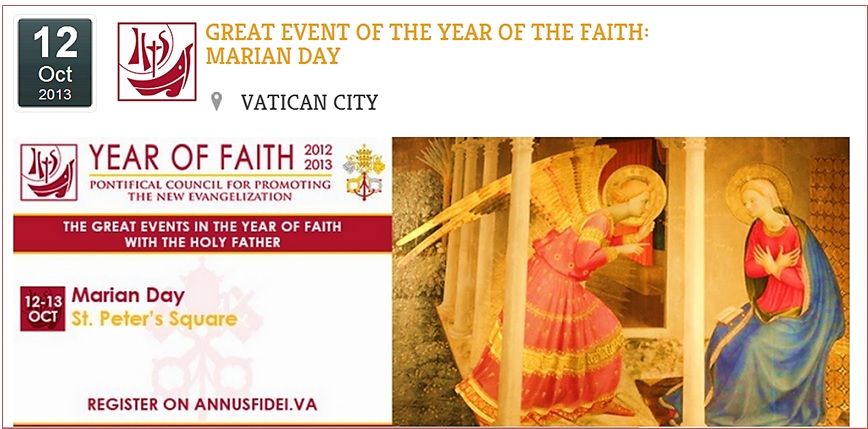 For weeks now, the Anglophone Catholic blogosphere has been excited about Pope Francis's announced intention to consecrate the world to the Immaculate Heart of Mary at the next great event in the Year of Faith - Marian Days to be observed on October 12-13 in the Vatican. Such a great to-do: "Oh wow! Imagine, not any of the Popes before him, after the apparitions at Fatima, ever thought of doing that!", forgetting that John Paul II did [But ultra-trads say, "Well, Our lady said Russia ought to be consecrated to Mary, not the world, and he pointedly excluded Russia," or some such ridiculous quibble. And Benedict XVI? "Not a Marian Pope at all, compared to John Paul II and Francis!" (Yes, that Benedict-who-could-do-nothing-right-dearLord-what-a-disastrous-clueless-Pope!, as if he had no Marian creds at all, and yet, to begin with, he wrote three books about Mary before he even became Pope, and grew up venerating the Madonna of Altoetting, and we could go on and on... "Who cares? He did not venerate 'Maria salus popoli Romani' the way this Pope does" (How do we know? Perhaps he did it in private without benefit of full multimedia coverage. Why even argue?)... And yet, this Vatican Radio news report does credit him for something...
Marian Days at the Vatican
For weeks now, the Anglophone Catholic blogosphere has been excited about Pope Francis's announced intention to consecrate the world to the Immaculate Heart of Mary at the next great event in the Year of Faith - Marian Days to be observed on October 12-13 in the Vatican. Such a great to-do: "Oh wow! Imagine, not any of the Popes before him, after the apparitions at Fatima, ever thought of doing that!", forgetting that John Paul II did [But ultra-trads say, "Well, Our lady said Russia ought to be consecrated to Mary, not the world, and he pointedly excluded Russia," or some such ridiculous quibble. And Benedict XVI? "Not a Marian Pope at all, compared to John Paul II and Francis!" (Yes, that Benedict-who-could-do-nothing-right-dearLord-what-a-disastrous-clueless-Pope!, as if he had no Marian creds at all, and yet, to begin with, he wrote three books about Mary before he even became Pope, and grew up venerating the Madonna of Altoetting, and we could go on and on... "Who cares? He did not venerate 'Maria salus popoli Romani' the way this Pope does" (How do we know? Perhaps he did it in private without benefit of full multimedia coverage. Why even argue?)... And yet, this Vatican Radio news report does credit him for something...
Marian Days at the Vatican
during the Year of Faith

August 23, 2013
"Blessed are you for believing!" That is the theme of the Marian Day which will be held in the Vatican on 12 and 13 October next, in the presence of the Holy Father Pope Francis and all the associations of Marian spirituality.
Organized by the Pontifical Council for Promoting the New Evangelization, the event is part of the celebrations of the Year of Faith organized by the then Pope Benedict XVI to commemorate the fiftieth anniversary of the Second Vatican Council - and coincides with the anniversary of the last apparition of the Blessed Virgin at Fatima.
It was, in fact, on October 13, 1917, when at Cova da Iria, Portugal, Our Lady appeared for the sixth and final time to the three shepherd children, Lucia, Francisco and Jacinta. Soon after, there was the so-called "miracle of the sun" the solar disc changed colour, size and position for about ten minutes.
In memory of this date, therefore, the original statue of Our Lady of Fatima will be brought to St. Peter's Square and exposed to the veneration of the faithful.
This is the program of the day in detail: Saturday, October 12, at 8:00 am, there will be a pilgrimage to the tomb of Peter. An hour later, Eucharistic Adoration will begin with the celebration of the sacrament of reconciliation in some churches adjacent to St. Peter's Square.
In the afternoon, at 17.00, the statue of Our Lady of Fatima will be welcomed by Pope Francis in St. Peter's Square and then the Pope will hold a Marian catechesis.
At 19.00, the statue of the Virgin will be brought to the Santuario del Divino Amore, where the Rosary will be recited with a link up to all the Marian shrines in the world. A prayer vigil at Divino Amore will begin at 22.00.
The next day, Sunday, October 13, the statue will return to St. Peter's Square at 10.00 am, there will be a recitation of the Holy Rosary, and at 10.30 the Pope will preside at Mass.
I was pleasantly surprised, almost shocked, that Vatican Radio reported this event as an initiative of Benedict XVI, contrary to almost all Vatican publicity about the Year of Faith events that have taken place after Benedict XVI stepped down as Pope. That was A decision by the Vatican media bigwigs that is consistent with their determination to ignore, as much as possible, the existence of Benedict XVI or his Pontificate. And specifically, in this case, given that Mons. Rino Fisichella, president of the Pontifical Council for Promoting the New Evangelization, which is the Church's lead agency in the Year of Faith, has appeared to have totally erased Benedict XVI from his consciousness in his rather obvious pandering to his new boss.
I can give no better example of such pandering than what he said as one of the three official presenters of Lumen Fidei when it was released last July 5:
“Lumen Fidei, while recovering some insights and some content of the teaching of Benedict XVI, is totally a text of Pope Francis,” the archbishop said at the Holy See’s press office during the encyclical’s release on July 5.
“Here we find his style, and the peculiarity of the content to which we have become accustomed in the first months of his pontificate, especially with his daily homilies,” he added.
Archbishop Fisichella stressed that “the usage of expressions, the wealth of images to which he makes reference, and the peculiarity of some quotations from ancient and modern authors make this text a true introduction to his teaching and allow a better understanding of the pastoral style that makes him unique.”
As I remarked at the time, the stark untruthfulness in all of that must have been embarassing to Pope Francis himself (when even L'Osservatore Romano and Vatican Radio appeared to have been so embarassed by the outright falsehood of Fisichella's statements they decided not to report his presentation at all). But we have here someone trying to make sure Pope Francis does not forget to name him when he decides to create the first cardinals of his Pontificate.
And yet, as far as the Year of Faith itself is concerned, it was Mons. Fisichella himself who announced the full calendar of the planned events - especially those with the participation of the Pope - ack in 2012, months before Benedict XVI's shock announcement that he was renouncing the Papacy. In short, no new events for the Year of Faith were added on by the new Pope that had not already been programmed and approved by his predecessor. Which is certainly not the impression that the Vatican media as a whole have been fostering in their reportage of the YOF events.
But on the Year of Faith website run by Mons. Fisichella's Council, there is a glaring discrepancy that no one has noticed enough to correct. The announcement for the YOF calendar poster still advertises "Poster for the Great Events of the Year of Faith with Benedict XVI', as it was when the YOF began in 2012, whereas the poster itself has since been edited to say "The great events in the Year of Faith with Pope Francis":

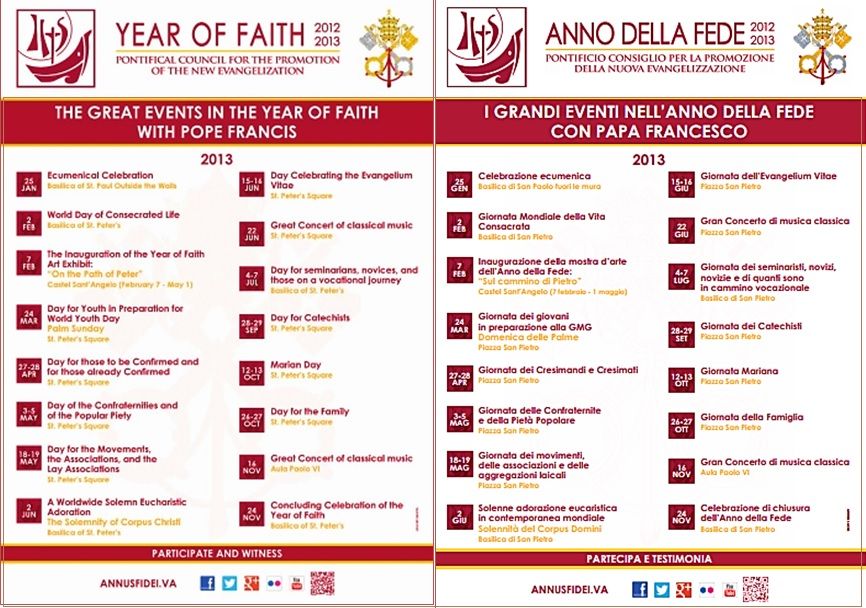 And yet the 2013 calendar includes events in January and February when Benedict XVI was still Pope, so why couldn't the poster read "...with Popes Benedict XVI and Francis"? And whose idea was it again to celebrate a Year of Faith? In the eyes of Mons. Fischella, after March 13, 2013, it would seem Benedict XVI gets no points at all for decreeing the Year of Faith.
And yet the 2013 calendar includes events in January and February when Benedict XVI was still Pope, so why couldn't the poster read "...with Popes Benedict XVI and Francis"? And whose idea was it again to celebrate a Year of Faith? In the eyes of Mons. Fischella, after March 13, 2013, it would seem Benedict XVI gets no points at all for decreeing the Year of Faith.
Perhaps Mons. Fisichella is too busy polishing apples for the boss he has not checked his Council's website lately. I do bear him a big big grudge for his evidently self-willed Benedict amnesia. And as petty as it may seem, IMHO, he has it in for B16 because he was not made a cardinal in his last consistory, the mini-consistory with six new cardinals - but neither was Mons. Gerhard Mueller of the CDF, and surely, the CDF Prefect is more senior in terms of the importance of his dicastery than the head of the Vatican's youngest pontifical office! If you want a signal example of careerism in the Vatican, look no further than Mons. Fisichella.]
I could have found any number of news reports and commentaries during the nearly eight years of Benedict XVI's Pontificate to 'attest' to his Marian devotion in his own way, but the following best illustrates it, I think. From the coverage of his apostolic trip to Portugal in 2010, one of the most satisfying of his visits:


 It was particularly difficult to keep up with the coverage of the Portugal visit not only because of its wealth of events - the two days in Fatima were intense - but because the entire visit fell during the week, when one does not have the relative leisure of a weekend to try to be prompt and comprehensive in posting reports, let alone commentary on the events.
It was particularly difficult to keep up with the coverage of the Portugal visit not only because of its wealth of events - the two days in Fatima were intense - but because the entire visit fell during the week, when one does not have the relative leisure of a weekend to try to be prompt and comprehensive in posting reports, let alone commentary on the events.
One of the immediately memorable commentaries I saw thanks to Beatrice on her site

benoit-et-moi.fr/2010-II/
was a blog entry by Jean Marie Guenois, religion editor of Le Figaro. A commentary that brings back all the emotion of watching the event - Benedict XVI praying to Our Lady of Fatima upon arriving at the Shrine on Wednesday, May 12... This is a most unexpected spiritual reflection from a secular journalist, a reflection that I have been swirling around in my palate like a sip of a rare wine that must be shared... Fortunately, the moments he describes were rather well documented on photographs.
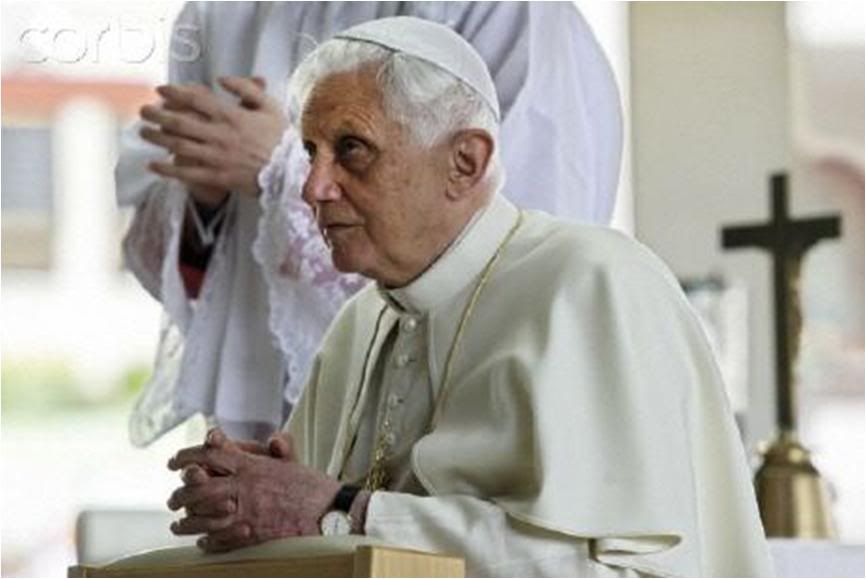
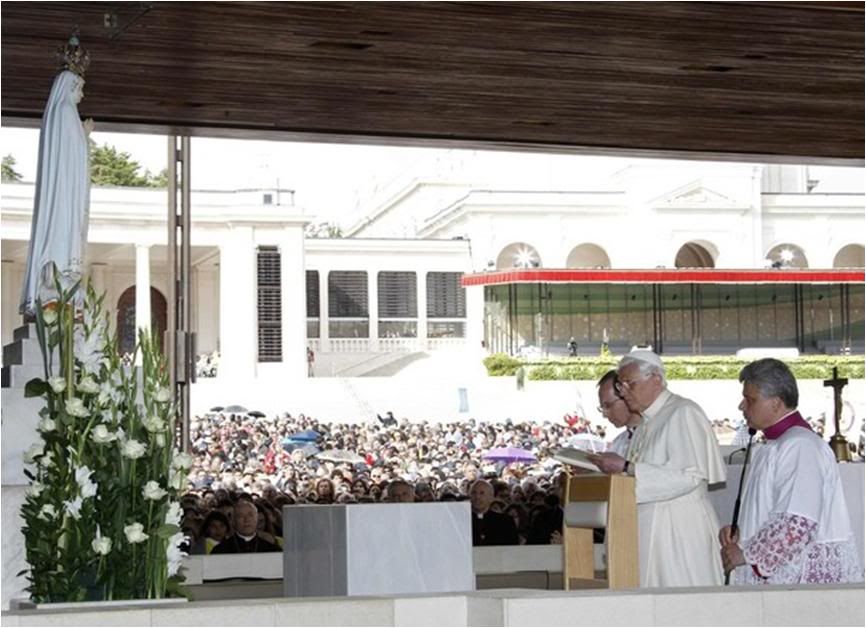
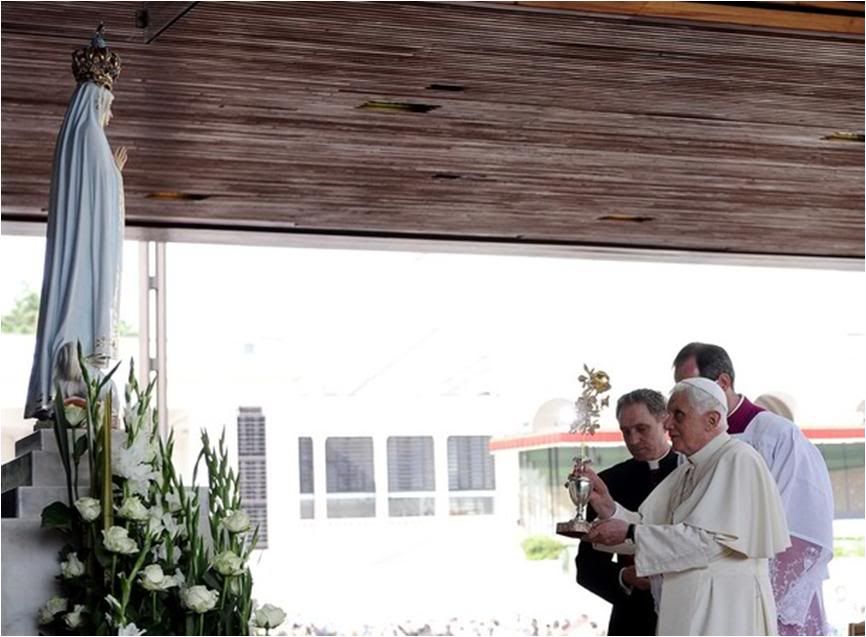 A rose for Our Lady:
A rose for Our Lady:
The Pope becomes a child
Translated from the blog

by JEAN MARIE GUENOIS
Religion Editor

May 12, 2010
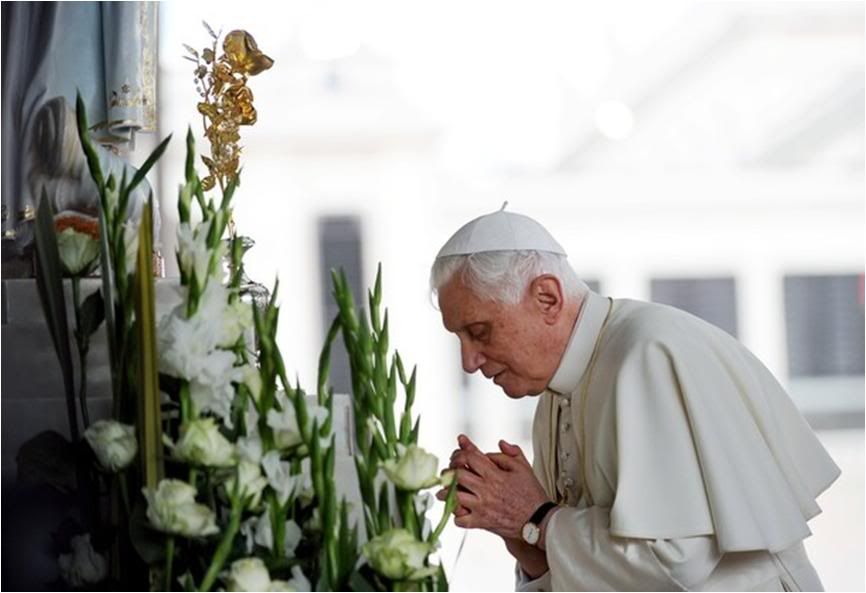
In the Marian shrine of Fatima, I had the chance on Wednesday afternoon to be a few meters away from Benedict XVI and to see him in contemplation before the venerated statue of the Virgin.
Surely there could be nothing more common than to see a Pope pray. He's merely doing his job, some would say.
It so happens I have already observed several similar situations but I have rarely noted such a ' recueillement' in anyone. [The one-word English translation is reverence or meditation, but the sense conveyed by the French word, and its cognates in the other Romance languages, is much more active, literally, a 'gathering in' of one's entire being.]
It is impressive and difficult to describe. Is this because of too much emotion or lack of objectivity [on the part of the observer]? I don't think so.
There are instances like this of 'extreme' human situations which may be signs of suffering, or of intense joy, a mythical exteriority - or a unique interiorness. Though intimate, they are nonetheless 'fact'.
What had happened? Benedict XVI went towards the image to offer it a gift - a rose in gold and silver - a symbol of thanksgiving. He had just read a prayer in which he evoked his predecessor, John Paul II, the assassination attempt on him, and the sufferings of the Church. He was the Pope and being so.
Then, he seemed to be transformed the moment his aide handed him the rose to lay at the foot of the image. Now, he was no longer a Pope but a child. He walked forward with the smile of a child on Mother's Day - at once very happy with the gift he was going to present, too moved by the knowledge of it, and rather timorous of the gesture he is making in a sort of role reversal since a child is used to receiving gifts rather than giving them.
Benedict XVI placed his present at the feet of the Virgin, then he began to pray with his whole being, it seemed - eyes closed, almost physically 'sucked in' by the image. Long minutes, paradoxical ones, made up of absence, a stunning presence, and silence.
Around him, on the esplanade, some 300,000 faithful seemed to vibrate in diapason. Now and then, the man in white regarded the image with a look of both tenderness and distress. A look that implored even as it gave thanks.
Then, his master of ceremonies came to take him by the arm gently. The child became the Pope again.
Some may scoff at this as mystical ecstasy, or mystical delirium, they would say. But I would pay my respects to a man's prayer - whoever he is. This secret dialog of the soul, in which each individual works his own alchemy. But in which one grasps, precisely from facial expressions, the 'truth' of such moments.
In the same way that, not long after, I was struck by the tears in the eyes of an old Portuguese peasant, his skin leathery from a life of work, after his eyes met the Pope's. The old man was overwhelmed. He clearly did not wish to weep but with tears in his eyes, he was an example of dignity.
This is pure emotion. In this respect, religion is very human, and shrines like Fatima are alive with high spiritual tensions.
It made me think how difficult it is to write of spiritual phenomena. As a journalist. But other professions, too, are similarly challenged. Without any doubt, there is an objectivity to religious expression. Just because it has been 'described' as subjective does not mean that it is not objective per se. And precisely as a 'factual fact', I would dare say.
I also reflected on what one calls 'spiritual struggle' which seems palpable in a place like Fatima, when thousands of persons are praying with one heart.
I then thought back to what I had written in the past regarding Benedict XVI's supposed 'distance' from Marian questions - which is his reputation at the Vatican. [I have always found this strange, but I suppose such Vatican 'doubters' are probably judging him by the standards of his predecessor's open and total devotion to Mary - 'Totus tuus' was his motto - forgetting not just that Benedict XVI is Bavarian but that he grew up in a family and an environment that was specially and actively devoted to Our Lady of Altoetting.]
I then realized that I had mixed up two things: his extremely rational approach to supernatural facts and his personal devotion. John Paul II was a Polish Pope who was a passionate lover of the Virgin Mary and never hid it. Benedict XVI has the same passion but this famously modest man does not 'display' it.
As for his rationalist approach to the phenomenon of apparitions from heaven, the Pope spoke of it on his inflight news conference en route to Lisbon.
He explained the importance for the Church of distinguishing the psychological, cultural and historic conditioning of persons who feel, see or hear supernatural manifestations, from the essence of the message for which they serve as the vehicle for communication.
Because then, faith which is stripped of its human conditionings (thus, time is needed for the right discernment) deploys its most profound sense which has universal importance and traverses history.
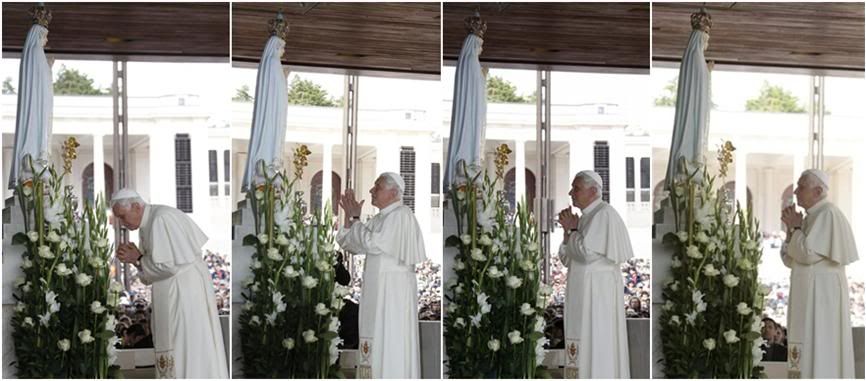
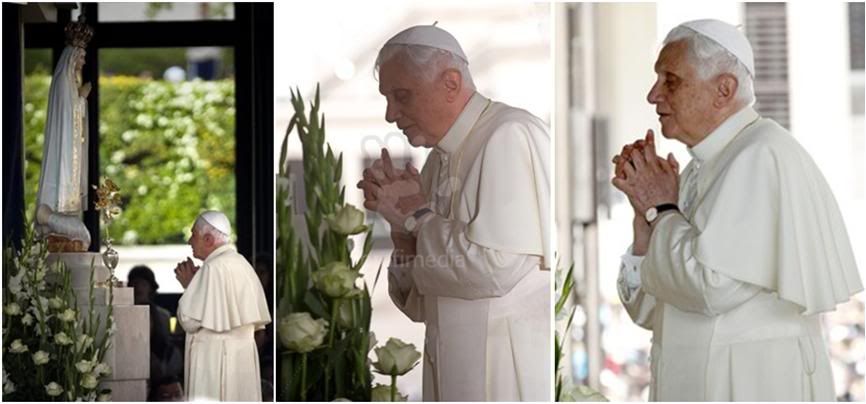 Guenois joined Le Figaro in 2008 after 10 years as religion editor for La Croix, a Catholic newspaper. As a correspondent, he lived in Rome from 1989-1998, during he founded I-Media, an international news agency that has distinguished itself for its reliable 'insider' reporting from the Vatican. In 2005, he wrote a book about Benedict XVI
Guenois joined Le Figaro in 2008 after 10 years as religion editor for La Croix, a Catholic newspaper. As a correspondent, he lived in Rome from 1989-1998, during he founded I-Media, an international news agency that has distinguished itself for its reliable 'insider' reporting from the Vatican. In 2005, he wrote a book about Benedict XVI
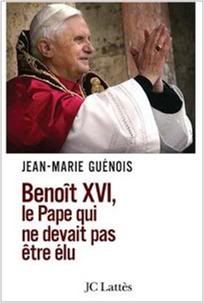
(The sense of the title is roughly 'The Pope who was not supposed to be electable').
A rose from the Pope
Editorial
by Giovanni Maria Vian
Translated from
the 5/14-5/15 issue of

The papal visit to Portugal revealed the kind and strong heart of Benedict XVI, who is increasingly perceived more clearly in his apostolic visits as carrying out the mission of the Successor to Peter.
As he did in Lisbon, Fatima and Porto, where the simple and intense affection of the Portuguese - so numerous and so enthusiastic that they surprised the impeccable trip organizers themselves, and even the international media which have not always been benevolent - was manifested passionately and movingly.
Especially in the Shrine of Fatima which is truly the spiritual heart of the nation and evident proof of the modernity of Mary, who was greeted with waving white handkerchiefs and showers of rose petals reserved by tradition for the Blessed Mother and for pilgrims coming back in olden times from Rome.
Indeed, this apostolic visit was made in the name of Our Lady of Fatima, following those of Paul VI and John Paul II, and in sight of the centenary of the apparitions in 2017.
A visit to confirm the message entrusted by the Virgin to the three child visionaries - a message so rooted in the Bible, and a prophecy that is as permanent as it is far from imaginary speculations:
Notwithstanding the selfishness that always threatens human life and peace, notwithstanding the continued suffering of the Church for the sins of her children, the last word, Benedict XVI reiterated, will never be that of evil, which was conquered by the Risen Christ, and which, therefore, Christians can and must fight and defeat through prayer, penitence and witness.
Before the small image of the Virgin and in the presence of about 300,000 pilgrims, the Pope offered her a Golden Rose that he had brought from Rome "as a son who has come to visit his Mother and does so in the company of a multitude of his brothers and sistere".
In the bullet that his predecessor had asked to be embedded in the crown of the image - the bullet that missed killing him - Benedict XVI sees a symbol of the sufferings of the Church and the world.
Thus, as the Year for Priests is coming to a close, Benedict XVI consecrated himself and all priests to the Blessed Mother, with a gesture that is within the tradition of Fatima, but which took on an added significance because of his confident appeal for radical faithfulness which is so necessary in these times.
Once more, 'Peter today', as his Secretary of State has called him, is not alone. Surrounded and sustained by the communion of saints in the affection and growing sympathy of numberless Catholics and non-Catholics, the successor of the first among the apostles called on the Catholics of Porto - but spoke to all Christians - for just one thing:
"Dear brothers and sisters, it is necessary that you become witnesses with me to the resurrection of Jesus". In order to make God present in this world, where only the light of Christ - lumen Christi - can make the flame of faith burn brightly, a flame which can be extinguished if it is not continually fed.
A flame to illuminate the darkness, like the candles of Fatima which are reflected in the Pope's rose.
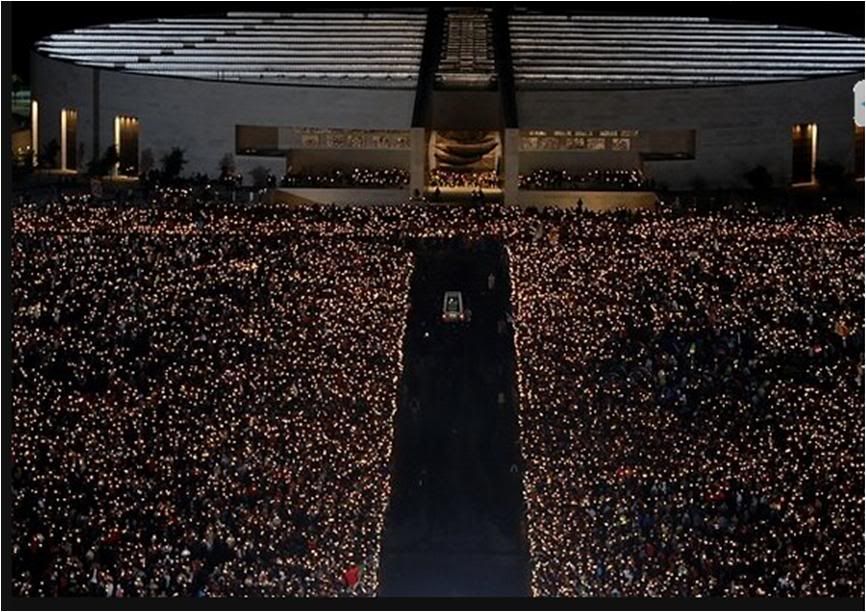
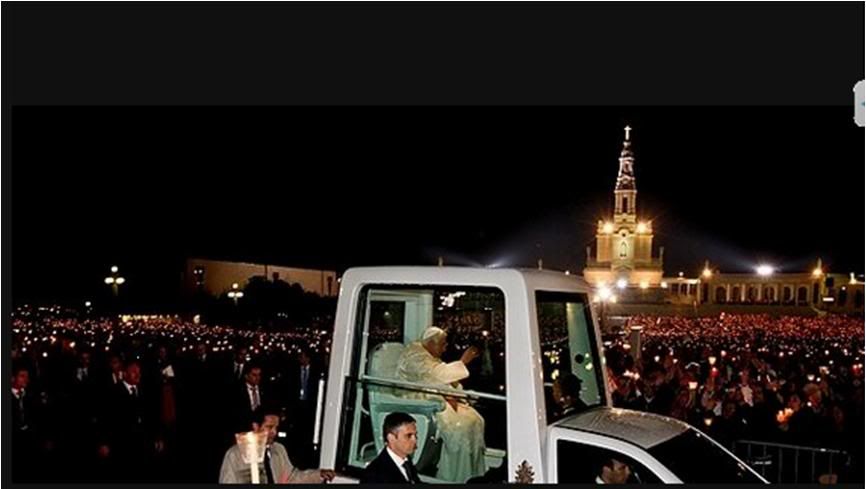

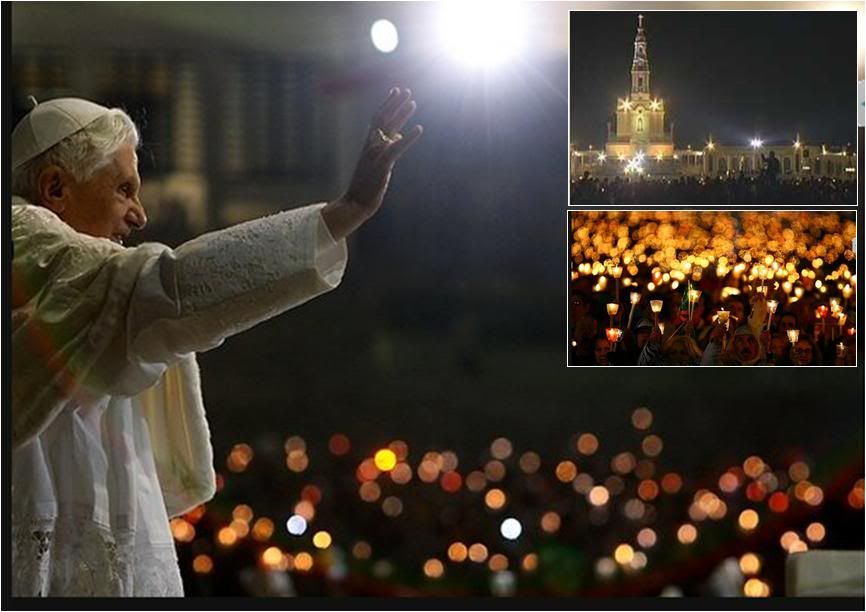
 Images from the candelight procession and rosary led by the Pope on the vigil of the Feast of Our Lady of Fatima.
Most newspaper reports on the Pope's first day in Fatima did not report it because of the earlier events - offering the Rose to the image, and the consecration of the clergy to Our Lady.
Images from the candelight procession and rosary led by the Pope on the vigil of the Feast of Our Lady of Fatima.
Most newspaper reports on the Pope's first day in Fatima did not report it because of the earlier events - offering the Rose to the image, and the consecration of the clergy to Our Lady.
Yet is was an event as significant as the Mass, if only because virtually all 500,000 who were at the Mass the following morning were already in attendance. As in Lourdes, the candlelight procession and recitation of the Rosary is a signal event, especially when led by the Holy Father.
 [Modificato da TERESA BENEDETTA 25/08/2013 08:07] |
| |
 25/08/2013 16:10 25/08/2013 16:10 |
|
| | | OFFLINE | | Post: 27.048
Post: 9.524 | Registrato il: 28/08/2005
Registrato il: 20/01/2009 | Administratore | Utente Master | |
|

 Well, he did it! When the preposterous canard about Benedict XVI speaking to some 'recent visitor' about a mystical experience was first circulated by ZENIT last week, my first reaction was that someone like Mons. Gaenswein ought to make a statement about it.... And he himself has. The opportunity came when he presided Saturday, August 24, at the annual feast of the Madonna del Lago Albano in Castel Gandolfo, in an interview with the Italian correspondent of TG%, the premier newscast on Italy's Channel 5. Thanks to Lella and her blog! The videoclip also shows scenes from the feast in CG yesterday, and brief flashbacks to B16's last public appearance as Pope and his meetings with Pope Francis :
http://www.video.mediaset.it/video/tg5/servizio/404539/-esperienza-mistica-sono-tutte-falsita-.html
Well, he did it! When the preposterous canard about Benedict XVI speaking to some 'recent visitor' about a mystical experience was first circulated by ZENIT last week, my first reaction was that someone like Mons. Gaenswein ought to make a statement about it.... And he himself has. The opportunity came when he presided Saturday, August 24, at the annual feast of the Madonna del Lago Albano in Castel Gandolfo, in an interview with the Italian correspondent of TG%, the premier newscast on Italy's Channel 5. Thanks to Lella and her blog! The videoclip also shows scenes from the feast in CG yesterday, and brief flashbacks to B16's last public appearance as Pope and his meetings with Pope Francis :
http://www.video.mediaset.it/video/tg5/servizio/404539/-esperienza-mistica-sono-tutte-falsita-.html
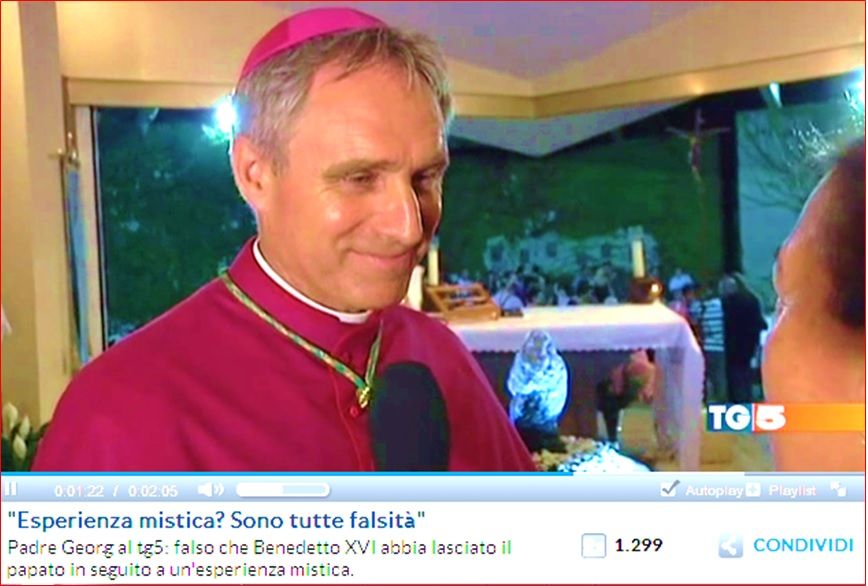 A mystical experience'? These are all lies'
A mystical experience'? These are all lies'
Padre Georg to TG5: It is not true that Benedict XVI
left the Papacy following a mystical experience
"An invention from alpha to omega - there is nothing true in what the article claims," GG says. I am unable to take a full transcript as yet of what he said, because the speakers on my PC are acting up, but I will as soon as I have.
Sadly, however, I doubt that Mons. Gaenswein's statements will ever be reported at all by the media outlets around the world that played up the ZENIT canard for all they could, as a sign it was truly God's will that B16 should go so that Francis could become Pope.
But I am happy to note that today's issue of L'Osservatore Romano carries the full text of Mons. Georg's homily at the Mass yesterday. I will post as soon as I have translated...
Also, from Lella's blog, this interview given to a German radio station by Fr. Bernd Hagenkord, SJ, who is in charge of the German service of Vatican Radio. As far as I know, he is the only Vatican official other than GG who has had the initiative, to begin with, and the common sense to point out that statements attributed to Benedict XVI in the ZENIT article 'do not seem like words from Benedict XVI" - even if, regrettably, he he continually hedges his statements...
'They don't seem like words
that would come from Benedict XVI'
Interview with Fr. Bernd Hagenkord
by Christian Schlegel
www.domradio.de
August 22, 2013
Translated from the Italian translation provided by
www.finesettimana.org
It was a 'mystical experience' that led him to renounce the Papacy - so Benedict XVI is supposed to have said. Fr. Bernd Hagenkord of Vatican Radio advised prudence in accepting such reports:
Is it just speculation? Can we trust an anonymous source?
Fr. Hagenkord: It is diffcult to say. On the one hand, it is plausible that Benedict XVI could have explained top someone why he renounced the Papacy. [To say other than what he made crystal clear in all his public statements???] On the other hand, it comes from an anonymous source, and so we must be prudent. ['Prudent' is an understatement. 'Skeptical' it should be, at the very least. An anonymous source in a 'he said...' situation is all but useless and certainly not reliable, if he can't even stand up for what he claims by identifying himself. Of course, I think this 'anonymous source' is the ZENIT writer's fiction to account for a so-called 'scoop' that has succeeded enormously in its ulterior malicious motives against Benedict XVI!]
What could such a 'mystical experience' be? It seems Benedict XVI said his renunciation was not 'an escape from the world' but 'taking refuge in God and a life in his love"?This last part could have been said by him. But that about a 'mystical experience' is rather pathetic - that does not sound like it came from Benedict XVI at all. I can imagine that in prayer, Benedict struggled about the decision for some time, and then was able to 'discern' the will of God, namely, that it was time for him to retire because of his physical condition. Which he has said before - and most Vaticanistas have found that reason plausible. [They don't have to find it plausible. It is the reason he gave, and since his retirement, not even B16's detractors have disputed his physical condition, some like Francis appointee Francesca Chaoqui even assuring the world he has leukemia, others claiming he suffers from some terminal illness and he has not long to live!]
What do you think of the other reasons that have been attributed for his resignation, such as Vatileaks?
Of course, there continues to be speculation about conspiracies, and 'mysteries' always thrive well in the Vatican. But I truly believe that his body could no longer sustain the demands of the Papacy, and that is turly the reason for resigning. He became all too aware that he would no longer be able to function as he should, and so he retired voluntarily.
It seems Benedict XVI also said that he was very happy about his decision and that he sees the popularity of Pope Francis as a confirmation. So is this a divine sign?
It sounds like he could have said these - to recognize that in Francis, the Petrine ministry is in good hands. [What else could he say??? As a good Catholic, even if he is an ex-Pope, he has to think so!] Therefore this has made him tranquil and is an a posteriori confirmation of his decision, namely that the Holy Spirit had acted both in the matter of his renunciation as well as in the election of Francis. [Idem.]
It seems that the interest in Benedict XVI remains great. Can he continue to live 'hidden from the world' as he has said he would? [That so-called interest is 'great' only when it has to do with something that can be exploited against him!]
He can continue to do so, if people stop telling tales to the media as anonymous sources. I hope he can continue to receive 'good visitors', and that he must not have to weight every single word he says to them. [He does so, naturally, anyway. No one has said Joseph Ratzinger ever spoke without thinking about what he says and how he says it. Self-editing and therefore always 'print-ready', remember?] And more, that people stop saying nonsense! [AMEN!!!! And that goes for ZENIT and all those who bought unquestioningly into its reporter's fiction! I am being openly uncharitable, of course, about such people, and God forgive me, but it's not as if 'they know not what they do'!]
August 25, 2013
P.S. It appears some media outlets have picked up Mons. Gaenswein's statements. Here's the German news agency kath.net...
Mons. Gaenswein on
Benedict XVIi's 'mystical experience':
'Media reports on why he resigned
are sheer invention from A to Z'
by Armin Schwibach
Translated from

ROME, August 25, 2013 (kath.net/as) - "An invention from A to Z". Words used by Mons. Georg Gaenswein, Prefect of the Pontifical Household and private secretary to Benedict XVI, to dismiss the media furor last week over statements attributed to the emeritus Pope.
"Nothing was true in that article," he said about the supposed account by a recent visitor of Benedict XVI reported by the Italian service of ZENIT. Gaenswein spoke to a correspondent of Italian TV channel 5 after he presided at a Mass celebrating the feast of the Madonna of Lake Albano and the 36th anniversary of the inauguration of a church built in her honor on orders of Pope Paul VI by the lakeshore of Castel Gandolfo.
[Next, the report reprises the allegations made in the ZENIT report, which are not worth repeating.]
The statements attributed to Benedict XVI, in the sensation-mongering formulation that was reported to have come from 'a recent visitor to Benedict XVI who prefers to remain anonymous' roused worldwide attention, and led Peter Seewald, a biographer of Benedict XVI, to say to kath.net: "I can only say that it's pure twaddle and invention".
Seewald told kath.net that he himself met with Benedict XVI recently, and that they talked about the resignation, but that the emeritus Pope had not expressed himself in any terms as what the ZENIT account alleges. [And surely, ZENIT's anonymous source, if he exists at all, could not possibly merit any statements more confidential than anything Benedict XVI could tell Seewald, let's get real here!]
Seewald's reaction [based on two decades of personal relationship with Joseph Ratzinger] finds its definitive confirmation in Mons. Gaenswein's remarks.
The question remains how and why, to begin with, such reports could be set out which show, first of all, a lack of respect for Benedict XVI and his privacy. Not that anyone in the media world really cares about his privacy, least of all ZENIT, a Catholic news agency, which decided to go for the cheap but bogus 'scoop' and got more than they probably expected in terms of worldwide unquestioning acceptance of a report that sounds at the very least, dubious!]

[Modificato da TERESA BENEDETTA 26/08/2013 00:00] |
| |
 25/08/2013 18:10 25/08/2013 18:10 |
|
| | | OFFLINE | | Post: 27.049
Post: 9.525 | Registrato il: 28/08/2005
Registrato il: 20/01/2009 | Administratore | Utente Master | |
|

 August 25, 2013, 21st Sunday in Ordinary Time
August 25, 2013, 21st Sunday in Ordinary Time
 Fourth from left, portrait by El Greco, ca. 1600; 6th from left, 16th century portrait of Louis feeding the poor; next to it a medieval illumination depicting the meeting in Cluny between Pope Innocent IV and Louis.
ST. LOUIS IX OF FRANCE (b France 1226, d Tunis 1270), King, Crusader, Confessor
Fourth from left, portrait by El Greco, ca. 1600; 6th from left, 16th century portrait of Louis feeding the poor; next to it a medieval illumination depicting the meeting in Cluny between Pope Innocent IV and Louis.
ST. LOUIS IX OF FRANCE (b France 1226, d Tunis 1270), King, Crusader, Confessor
Descended from the Capetian dynasty, he became king at age 12, and his mother Blanche aced as regent until he was 19, when he married Marguerite of Provence with whom he would have 11 children, one of whom would found the Bourbon dynasty. He took his coronation oath seriously to 'behave as God's anointed' and became the embodiment of the ideal Christian monarch. He was primus inter pares among the monarchs of Europe because France at the time was the largest and wealthiest of the European nations. He brought many reforms to civil administration, particularly in the justice system, and building on the earlier work of his mother, he successfully fought down the Albigensian (Cathar) heresy. But in his efforts to defend the faith, he also expelled the Jews and strengthened the Inquisition in France. He was devoted to his people, keeping lists of the needy to bring them regular aid, founding hospitals, visiting the sick, caring for lepers, and bringing together all classes of people by his personality and holiness. He was a patron of arts and culture, under whom Gothic architecture and arts flourished, and Paris reinforced its medieval reputation as center and arbiter. He built the famous Sainte Chapelle in Paris as his private chapel. As a Christian king, he took part in the Seventh and Eighth Crusades. The first time, he conquered the Egyptian city of Damietta, but ended up being captured by the Mameluke army and had to be ransomed by the Knights Templar. He spent the next four years in the Holy Land, using his wealth to help the Crusaders and build defences in Acre, Jaffa and Haifa. More than 20 years later, in 1570, he would take part in the Eighth Crusade, but he died unexpectedly of disease (probably dysentery) in Tunis. He was canonized in 1297, just 24 years after his death. He is the only French king to have been canonized.
Readings for today's Mass:
www.usccb.org/bible/readings/082413.cfm
AT THE VATICAN TODAY
Sunday Angelus - Pope Francis reflected on today's Gospel in which Jesus says, "Strive to enter through the narrow gate", saying that gate is Jesus himself, and that he is open to everyone. After the prayers, he expressed concern anew for the civil war in Syria and called on the international community to do everything possible to stop the violence.
Vatican Radio's English translation may be found here:
http://en.radiovaticana.va/news/2013/08/25/pope_francis:_you_are_not_excluded!/en1-722638
 One year ago...
One year ago...
No events announced for Benedict XVI on this day. But he named Cardinal Raúl Eduardo Vela Chiriboga, emeritus Archbishop of Quito (Ecuador), as his special representative to the celebration of the 475th anniversary of the Diocese of Cuzco (Peru), first diocese established in Peru and in South America. The celebrations take place on Oct. 22-28, 2012.
 35 YEARS AGO TODAY...
Here is my post from last year to mark the anniversary today of the Conclave that elected Cardinal Albino Luciani Pope in 1978...
35 YEARS AGO TODAY...
Here is my post from last year to mark the anniversary today of the Conclave that elected Cardinal Albino Luciani Pope in 1978...
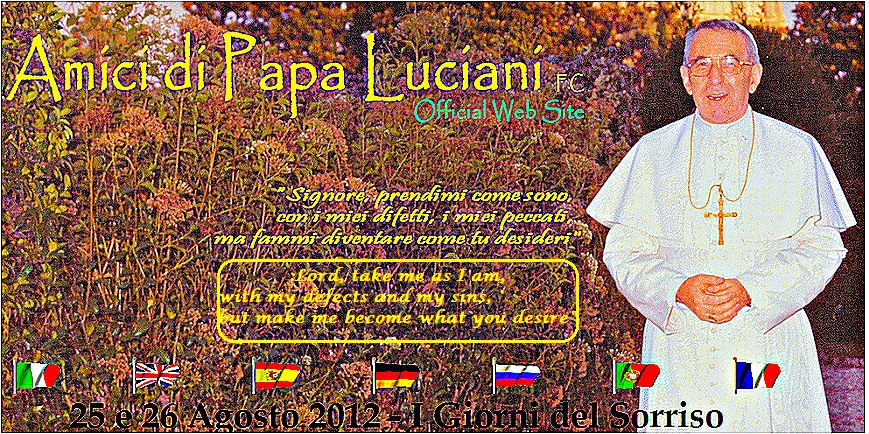 August 25-26, 2012 Days of Smiles - Observance of the anniversary by the Associazione Amici di Papa Luciani.
August 25-26, 2012 Days of Smiles - Observance of the anniversary by the Associazione Amici di Papa Luciani.
The Conclave began which would elect Cardinal Albino Luciani, Patriarch of Venice, the next day, on the fourth ballot, to succeed
Paul VI as Pope and Bishop of Rome, taking the name John Paul I.
[In 2012], John Paul I's town of Canale d'Agordo in northern Italy has also been celebrating this year the centenary of his birth, which will culminate on October 17, the actual birth date. [Modificato da TERESA BENEDETTA 25/08/2013 18:24] |
| |
 25/08/2013 18:34 25/08/2013 18:34 |
|
| | | OFFLINE | | Post: 27.050
Post: 9.526 | Registrato il: 28/08/2005
Registrato il: 20/01/2009 | Administratore | Utente Master | |
|
 On this day last year, there was this most interesting article from the OR... The feast days of St. Augustine and his mother, St. Monica, are celebrated on August 28 and 27, respectively.
On this day last year, there was this most interesting article from the OR... The feast days of St. Augustine and his mother, St. Monica, are celebrated on August 28 and 27, respectively.
 It took some time but I finally found a French website on Annaba, from which the photos come.
Benedict XVI makes personal contribution
It took some time but I finally found a French website on Annaba, from which the photos come.
Benedict XVI makes personal contribution
to restore the Basilica of St. Augustine
in Algerian city of Annaba, former Hippo
by Tiziana Campisi
Translated from the 8/25/12 issue of


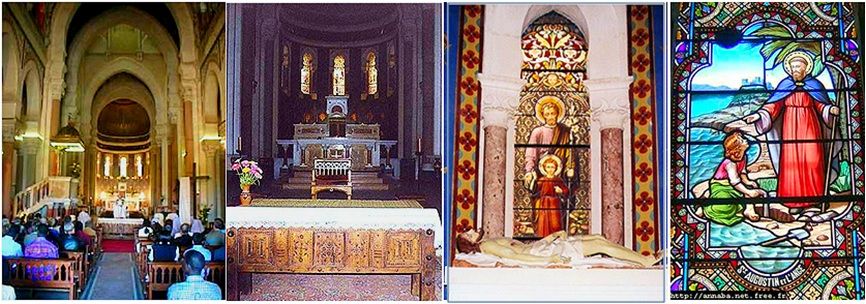 The Basilica without the scaffoldings; and the interior.
The Basilica without the scaffoldings; and the interior.
 A sarcophagus with a lifesize effigy of the saint in the Basilica stands in for Augustine's final resting place in the church of San Pietro in Ciel d'Oro, Pavia, Italy. His remains were taken from Hippo by Catholic bishops expelled from North Africa by a Vandal leader in the early 6th century. They brought the remains to Cagliari, Sardinia, where in the early 8th century, a Bishop of Pavia ransomed them from conquering Saracens.
A sarcophagus with a lifesize effigy of the saint in the Basilica stands in for Augustine's final resting place in the church of San Pietro in Ciel d'Oro, Pavia, Italy. His remains were taken from Hippo by Catholic bishops expelled from North Africa by a Vandal leader in the early 6th century. They brought the remains to Cagliari, Sardinia, where in the early 8th century, a Bishop of Pavia ransomed them from conquering Saracens.
The restoration work began more than a year ago. On its hill overlooking the Algerian port city of Annaba, scaffolding and work bridges hide the Arab-Moorish/Romanesque-Byzantine exterior of the Basilica dedicated to St. Augustine, Bishop from 395 to 430 of Hippo, the ancient name for the place.
[Annaba is in the northeastern corner of Algeria. With a population of about 260,000 in 2008, it is Algeria’s fourth largest city, a leading industrial center, and the main port for exporting its minerals.]
Next year, this place of worship, built by Africans who were able to harmonize diverse cultures, will resound once more - from its splendid facade, its multicolored stained glass windows, its precious marbles - with the words of the great philosopher-theologian whom the Church recognizes as a Father and Doctor of the Church.
The major restoration is financed by Algerian and French public authorities, various institutions, religious orders, dioceses, and diverse individual benefactors.
Among the latter, Benedict XVI, who has made a personal contribution.

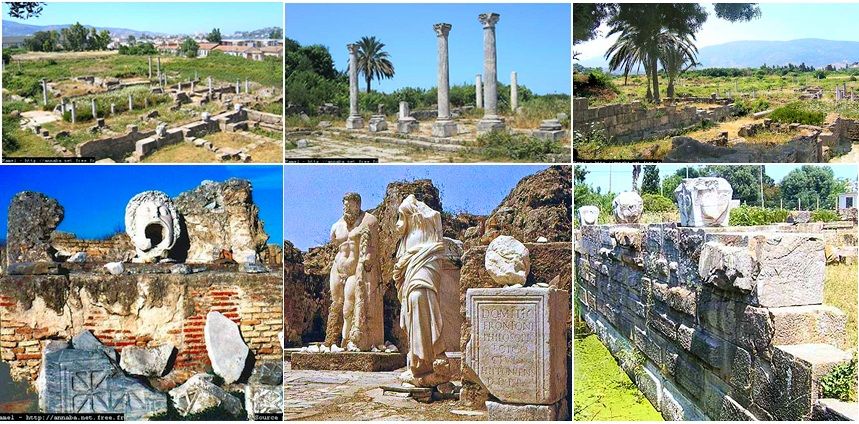 A statue of Augustine looks down from the Basilica on the ruins of Hippo and the modern city of Annaba.
L'Osservatore Romano
A statue of Augustine looks down from the Basilica on the ruins of Hippo and the modern city of Annaba.
L'Osservatore Romano interviewed Mons. Paul Desfarges, Bishop of Constantine-Hippo, on the progress of the work and the importance of the shrine.
MONS DEFARGES: Its importance may be gauged by the fact that Benedict XVI himself has taken an interest in the restoration. The Papal Foundation already made a contribution. But the Pope wished to make his own personal contribution. We all know, of course, how dear the saint is to the Pope.
He also knows that this is not just about the Basilica. The hill of Hippo, at the top of which the Basilica was built, is a symbolic site of coexistence, of spiritual and human fraternity. It is a trans-cultural, trans-religious place because of St. Augustine who transformed these values through his humanism, his faith and his culture, to lead man to the essential. As he loved to day, to live is to love. This message is actual today as it was yesterday.
The Basilica, which was consecrated in the first years of the 20th century is a hundred metres above the archaeological site of ancient Hippo Regius, which still has remains of the Basilica Pacis, where Augustine exercised his ministry. The cathedra as well as the baptismal font have been recovered.
This is not just a matter of pride for the Catholic Church in Algeria but all Algerians. That is why the restoration was welcomed and is supported by everyone. The people of Annaba are proud of St. Augustine. The pastoral care of the Basilica is entrusted to the Augustinians, and the Little Sisters of the Poor run a home for old people who have no families to live with or who have no resources.
How is it that the work has had the collaboration of so many institutions, including the Algerian and French governments.
Institutional cooperation has been great. From France, there has been great support especially from the Rhone-Alpes region, where three cities - St. Etienne, Grenoble and Lyons are twinned with Annaba, Constantine and Setif, respectively in Algeria.
As I said, the work represents solidarity and brotherhood between the two sides of the Mediterranean, between Christians and Muslims, between West and East, among men who seek reason and truth..
What exactly do the Augustinians do who are in charge of the pastoral work at the Basilica?
Right now, there are just three of them, but they hope to have more colleagues soon. But we have to resolve the problem of visas for priests, which continues to be an obstacle for priests and religious coming to work in Algeria [as it has been in Israel!]
However, they have been successful in animating pastoral life. They celebrate the liturgies and administer the sacraments and they act as guides for visitors. We get many - Algerian Muslims, Muslims from other countries, and tourists who come not only to visit the place, but to knwo more about St. Augustine, to pray and to meditate. Once they enter the Basilica, they know they have not entered a museum but a place where the silence and the peace can be gripping. And since the Augustinians are a religious order, they perform their daily office as if they were in a monastery, and so the life of the Basilica is has the rhythm of monastic life.
How can people contribute to the restoration work?
First of all, through prayer, through the communion of fraternal friendship, to make our church and this symbolic site known. Financially, I can say we still need about 500,000 euro to complete the restoration. We trust in Divine Providence. But we also ask for prayers without frontiers in order to be heard.
What is the situation of the Church in Algeria today?
The Catholic Church in Algeria at present is mostly represented by young sub-Saharans who are scholars from their respective countries, and in some cases, are also financed by the Algerian state. For some of them, it is not always easy to integrate. But with time, relationships deepen into friendship,and it is part of the mission of the Church to foster this.
Besides the students, there are those who work in the construction industries, mostly Filipinos. It is not easy for them to attend church regularly but they turn out for all the big religious holidays.
Then there are the Algerian Catholics themselves. We call some of them the friends of St. Augustine - persons who, in their own way, discovered like Augustine the presence of God in their heart and have therefore been able to call on Jesus. They are a sign that God desires to dwell in us and among us.
The Catholic communities of Algeria are small, somewhat like those of the primitive Church. They are minorities in in a geographical area where another religion prevails. What is the value of their witness and can they be an example?
I don't know. We don't claim to be an example. We are a small Church, discreet and modest. Sr. Madeleine, who founded the Little Sisters of Jesus of Charles de Foucault, used to say that in a Muslim country, we should not cast a shadow on anyone. All we want to do is to exist. That is our vocation, and that of the whole Church. God wants to dwell among his people. As Jesus would say, "Whoever welcomes you welcomes me, and whoever welcomes me welcome him who sent me:. Here we feel welcome.
Is there respect for religious freedom?
The freedom of conscience of some persons [Muslims] who have encountered Christ is not always respected. It is not easy. The Cross is never absent in our journey. But here, we also experience the beauty of profound spiritual and human encounters. The Church here is a sign of the love of God the Father who comes in his Son Jesus to dwell among us.
What is the relationship with Islam?
We know the Holy Spirit works in the heart of all believers. I would call some important and profound encounters with the spirituality of Islam surprising. We often have the distorted view that Islam is nothing but a political and ideological religion, and very often, its interior aspects are overlooked. We find here many Muslims who are genuinely spiritual.
The Christian brothers at Thibirine used to tell the Algerians that Christ so loved Algeria that he died for them, for all of us. We are a manger-Church, like Jesus, laid in a manger, who became bread for us. The Church here wishes to be a humble presence alongside the people.
 Left, 2001 rite at the Basilica during which the Algerian government finally 're-appropriated' Augustine as a figure in the universal patrimony, after centuries of being denounced as a symbol of Christian colonialism. At the initiative of then President Bouteflika, an international colloquium was held in Annaba from April 1-7, 2001, on the theme, "St Augustine: Africanity and Universality'; right, Augustine's tomb in Hippo.
Left, 2001 rite at the Basilica during which the Algerian government finally 're-appropriated' Augustine as a figure in the universal patrimony, after centuries of being denounced as a symbol of Christian colonialism. At the initiative of then President Bouteflika, an international colloquium was held in Annaba from April 1-7, 2001, on the theme, "St Augustine: Africanity and Universality'; right, Augustine's tomb in Hippo.
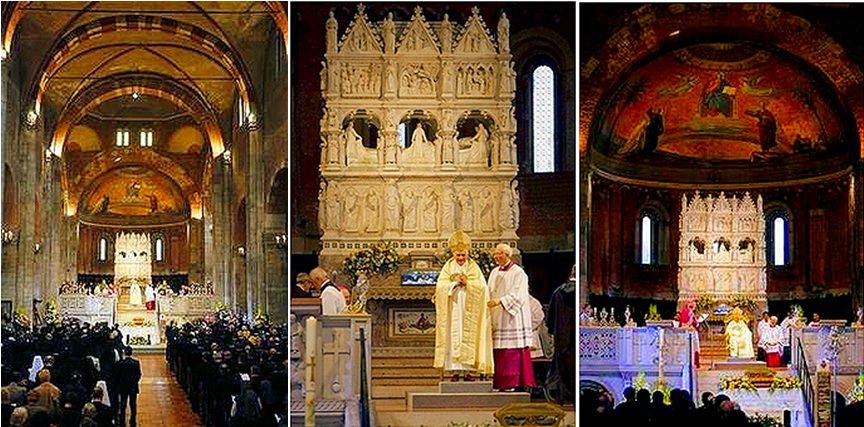 Benedict XVI at Augustine's tomb in San Pietro in Ciel d'Oro, Pavia, in April 2007.
For the record, the title given by the OR to this article, which was featured on the back page of the 8/25/12 issue, along with a photo of the restoration in progress
Benedict XVI at Augustine's tomb in San Pietro in Ciel d'Oro, Pavia, in April 2007.
For the record, the title given by the OR to this article, which was featured on the back page of the 8/25/12 issue, along with a photo of the restoration in progress

translates to 'Benedict XVI's donation for another thousand years of splendor', even though there is no reference to these 'thousand years of splendor' in the text. Since the Basilica was constructed in the first decade of the 20th century, and the basilica Augustine used in Hippo probably did not survive the sack of the Vandals, neither date could have been the reference point for the headline-writer's flight of fancy. Yet another editorial oversight at OR. |
| |
 25/08/2013 19:21 25/08/2013 19:21 |
|
| | | OFFLINE | | Post: 27.051
Post: 9.527 | Registrato il: 28/08/2005
Registrato il: 20/01/2009 | Administratore | Utente Master | |
|
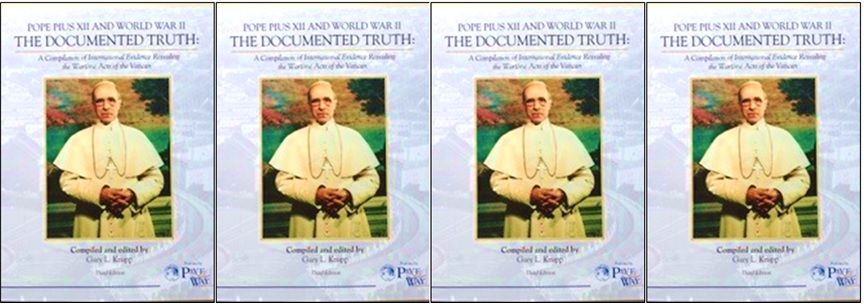 Sorry to have taken note of this so late...
Great book of documentary evidence
Sorry to have taken note of this so late...
Great book of documentary evidence
about the Pontificate of Ven. Pius XII
by Fr. John Zuhlsdorf

August 14, 2013
I just received in the mail a copy of the 3rd edition of POPE PIUS XII AND WORLD WAR II: THE DOCUMENTED TRUTH : A Compilation of International Evidence Revealing the Wartime Acts of the Vatican.
Wow. Useful and compelling.
The compiler/editor is Gary L. Krupp. He is Jewish and has the distinction of having been knighted by John Paul II and then raised to the Order of St. Gregory by Benedict XVI. He is the founder of the Pave The Way Foundation [to promote dialog between Christians and Jews; however, Mr. Krupp has perhaps been the single layman most dedicated to disseminating the truth about Pius XII and what he did to help Jews during World War II - this book is but the latest product of his major continuing initiative to do this. His work is invaluable, and fair-minded Catholics who do not buy all the anti-Pius propaganda cannot think him enough for it.].
The book aims to present evidence helpful for an accurate understanding of what Pius XII actually did. As such, it is part of his Foundation’s goal of removing obstacles and misinformation and foster true inter-religious dialogue.
I have posted a number of articles on this Forum and in the Papa Ratzinger Forum about the work done by Mr. Krupp and Pave the Way Foundation. In the case of Pius XII, however, none are more blind than those who refuse to see - and that goes for all those who have condemned him for his 'silence' about the Holocaust while ignorning abundant factual evidence that his deeds belie their obstinate accusations against him in which he has replaced Adolf Hitler as the villain of the Jewish Holocaust - his 'silence', not anything the Nazis did, caused the Holocaust; if he had not been 'silent', it would not have happened. They are all crazed by extreme prejudice against the Catholic Church.]
[Modificato da TERESA BENEDETTA 26/08/2013 14:28] |
| |
 26/08/2013 01:36 26/08/2013 01:36 |
|
| | | OFFLINE | | Post: 27.052
Post: 9.528 | Registrato il: 28/08/2005
Registrato il: 20/01/2009 | Administratore | Utente Master | |
|

 So, while I was busy with other things during the day, I see that Beatrice has transcribed the full TG5 videoclip with Mons. Gaenswein and posted the translation on her site. As she knows Italian as much as she does French, I shall take the easy way out and simply translate from her transcript. Thanks a lot for this and many other great leads and tips, Beatrice! And Lella, of course, who first posted the videoclip . You have both helped make this thread more comprehensive about Benedict XVI than it would have been just by myself.
Mons. Gaenswein's TG5 interview
So, while I was busy with other things during the day, I see that Beatrice has transcribed the full TG5 videoclip with Mons. Gaenswein and posted the translation on her site. As she knows Italian as much as she does French, I shall take the easy way out and simply translate from her transcript. Thanks a lot for this and many other great leads and tips, Beatrice! And Lella, of course, who first posted the videoclip . You have both helped make this thread more comprehensive about Benedict XVI than it would have been just by myself.
Mons. Gaenswein's TG5 interview
with Alessandra Buzzetti
August 24, 2013
Translated from the video report
transcribed and translated to French
by Beatrice B.
Buzzetti:How is the emeritus Pope?
GG: He is doing very well... He was here recently to visit the Apostolic Palace, to enjoy a beautiful promenade in the Gardens, and then to listen to a little concert.
Thus, Mons. Gaenswein confirms the recent excursion of Benedict XVI who made a very private visit to the pontifical estate in Castel Gandolfo.
Pope Benedict's ex(?)-private secretary lives like Benedict XVI in the Mater Ecclesiae convent in the Vatican, but as Prefect of the Pontifical Household, he works with Pope Francis during the day.
He was back Saturday in the Alban hills outside Rome to lead the evocative celebration of the feast of the Madonna of the Lake (Albano).
The Apostolic Palace in Castel Gandolfo is 'empty' at this time because Pope Francis has decided to stay in the Vatican for the summer, and Mons. Georg does not mask his nostalgia.
GG: For eight years, each year we were here for many weeks. Whether it was the Pope, me or others among us, it was a unique experience that we miss.
Mons. Gaenswein was beside Benedict XVI when, at 8:00 p.m. on February 28, the closing of the front doors of the Apostolic Palace in Castel Gandolfo symbolized the end of his Pontificate.
Benedict XVI's renunciation of the papacy is historic, not just for the Church, but it was not motivated by any mystical experience as reported last week in the media.
GG: All invented, from alpha to omega. There is nothing true in that article [the original ZENIT article in which an anonymous source out words into the mouth of Benedict XVI].
Buzzetti: For five months, you yourself have had the totally unprecedented task of serving as a go-between for two Popes. What is their relationship like?
GG: There is an excellent relationship between Pope Benedict and Pope Francis. I would not wish to be a wall but a bridge between the emeritus Pope and the reigning Pope.
Buzzetti: Where do you see the continuity between them?
GG: There is a continuity of substance. Of course, there are some elements of style that are very different because they are two different characters... If one just looks into the thread that runs through the first few months of Pope Francis's Pontificate, one sees that there is a classic continuity.
L'Osservatore Romano published the text of Mons. Gaenswein's homily at the feastday Mass in Castel Gandolfo on Saturday.
 The lady who never abandons
The lady who never abandons
by Mons. Georg Gaenswein
Homily on the Feast of
the Madonna del Lago
Castel Gandolfo, August 24, 2013
Translated from the 8/25/13 issue of

The feast of the Madonna del Lago is an optimal occasion to remember the role of Mary as a companion of the Lord and as the example that she is for us Christians.
Theologians teach that a healthy Christology is always accompanied by a healthy Mariology. To know the Lord we should also know his Mother.
The incarnation of God in Jesus Christ was manifested in the divine maternity of Mary. So whoever wishes to be Christian, who wishes to remain Christian, must look to the Mother of the Lord, the Most Blessed Mary.
All her actions, from the moment of the Annunciation by the angel, were oriented towards Christ. Mary did not simply give earthly life to Jesus - she also followed him and accompanied him on his earthly journey.
Mary is the prototype of every Christian vocation, of every call to take part in the work that God expects of men. We are all related to Mary because she intercedes for us with her Son. Everything she does is done with her Son in mind.
Mary introduced Jesus to earthly life. She herself was his first companion. Hidden, without any noise, without seeking applause or merit, she accompanied him in life. The more silent she was, the stronger and the more perceptible her words becAme.
From the beginning, Mary learned that the eternal Word of the Father lives in silence, not in noise. Therefore she kept in her heart and meditated silently on everything that she perceived about this Word. She knew: "From the beginning was the Word". The Word - not chatter - and that at the end, there will be no vain words but once again, only the Word.
Thanks to her contemplation, her activity was no empty activity but powerful and effective action. Therefore, not just her words but her whole behavior has exemplary importance for all those who wish to follow her Son.
Mary makes us see and understand an important Christian rule: "You ananot tell yourself the words that will help you". Mary asks the angel, after hearing his incredible message: "How can this happen when I do not know any man?" (Lk 1,34).
The answer was: "The Holy Spirit will descend upon you" (Lk 1,35). The angel says the words that help Mary to understand. Remembering this exprience, she will say years later at the wedding in Cana: "Do whatever he tells you to do" (Jn 2,5). They, too, the apostles, could not tell themselves the words that would help them. Mary had to tell them.
Mary is like John the Baptist, precursor of Christ in his earthly life. Mary knew this well. In the great icons of Christ that are found in the Oriental churches, representations of the Lord always show him accompanied by Mary and John the Baptist.
But Mary and John are merely the echo, not the Word. Each in his own way, both knew to let the Word resound. And if we are not to keep the word of Christ mute, let us go to Mary. We cannot forget that "You cannot tell yourself the words that can help you".
So the words that can help our society and our Church are those we cannot tell ourselves. On the other hand, all of us, like Mary, are called upon not to remain silent wherever and whenever it is necessary to say the words that will help - namely, to confess our faith courageously.
Mary accompanied Jesus through his earthly life. All his life, she was with him, for him, next to him. Mary was his first cop-ilgrim on the roads of the world. This journey was no stroll through the 'land of plenty' but a courageous walk with the Lord to be with him up to the Cross. Because her Son had come to seek out and rescue those who are lost.
Mary was with Jesus in the poverty of the cave in Bethlehem, she brought him as a baby to be presented in the temple in Jerusalem, she was with him on the flight to Egypt. Later, she was with him at the wedding in Cana, where she acted like a faithful servant, attentive that nothing should be lacking that was needed for the feast.
Mary's following of Christ was a school. Later, other women and men would accompany Jesus to serve him along the roads of Galilee and Judea. The Lord allows himself to be helped in seeking out and saving those who are lost. Jesus has given all of us a great responsibility to help save other men. Like the first disciples, near Mary, we too wish to accompany the Lord through the roads of the world.
But, just as in Jesus's time, today there are those who choose to abandon the company of the Lord. After his discourse on the Bread of Life, it was said, "Many [of] his disciples returned to their former way of life and no longer accompanied him" (Jn 6,66).
Today, as then, there are men and women who abandon the company of Jesus. Of Judas Iscariot, it was written, "He took the morsel and left quickly" (Jn 12,30) [It was the Last Supper, and Jesus had just told him, 'What you have to do, go and do quickly". The other apostles thought that since Judas kept the money bag, he Was being sent to buy what they needed for the Passover feast or give money to the poor.]
Judas was one of the Twelve, but he chose to go away from Jesus - towards ruin. To abandon, to leave, to go away are unfortunately key words in our present time, in the Church today.
Jesus abandoned is not the notion of an overheated imagination or of exaggerated piety, but is a serious reality.
Mary went all the way to Calvary in accompanying Jesus. Like Mary, the Church faithfully accompanies her Lord for all time and brings him to everyone. History teaches us that the Lord has 'emigrated' from places where his followers have abandoned him. In the eighth and ninth centuries after Christ [the birth and rise of Islam], so many flourishing nations and regions were lost to the Church this way - in Europe, in Asia, in Africa, in the Middle East.
Whoever goes with Jesus all the way goes with him to Golgotha, but also takes part in the Paschal triumph. Mary, the co-pilgrim of the Lord, became both the Sorrowful Mother and the Victorious Mother.
In her life, she took with her many others directly to Christ - Joseph, Elizabeth, Zachary, Simeon, Anna, the Apostles, her own relatives and friends. Mary did not need admirers but co-pilgrims and companions for Jesus.
Mary followed her son. Following becomes the passage from believing to seeing, but also from seeing to believing. Elizabeth told her, "Blessed are you for you believed". And as a consequence, the Word became flesh. Mary saw it, touched it, felt the Word become flesh, making the passage from believing to seeing.
This was evident on that pilgrimage to the temple of Jeerusalem by Joseph and Mary with the 12-year-old Jesus. All three were pilgrims together. But on the return home, Jesus stayed behind. Mary and Joseph went back, searching for him for three days. The son was no longer with them, but ahead of them. He had become the object of their 'trip'.
It was no longer blood ties that were decisive but the bonds of the Holy Spirit: "Don't you know that I should go about my Father's business?" Not even biological parenthood would guarantee salvation but faith in him. "Blessed are you because you believed".
To follow Christ through Mary is the way from seeing to believing in her Son as the Son of the living God, from the house in Nazareth to the Church of Christ. That is why on the Cross, the Lord draws Mary's attention from himself towards John, and draws the attention of the disciple he loves from himself towards Mary: "Behold your Mother!"
The Lord had created a new bond, a new covenant: the Church. On Pentecost, he gives the Church the Holy Spirit, and the Holy Spirit covers the Church like a shadow, as in Nazareth, he descended upon Mary. And thus Mary became, first, the Mother of Jesus, and then, the Mother of the Church.
After the Holy Mass, we shall accompany the image of the Madonna del Lago in a procession to the lakeshore. Then we shall accompany her on the water and then welcome her back on the beach. But it is really she who accompanies us in our journey.
As we go along our way of faith, Mary already preceded us in it. Mary as companion, teacher and guide invites us all to walk together towards Christ, Light of the world.
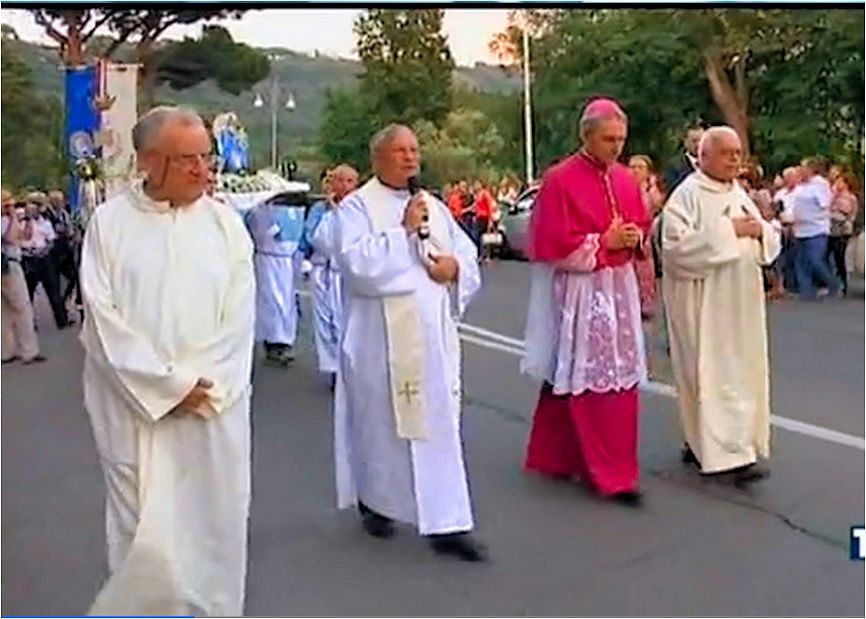
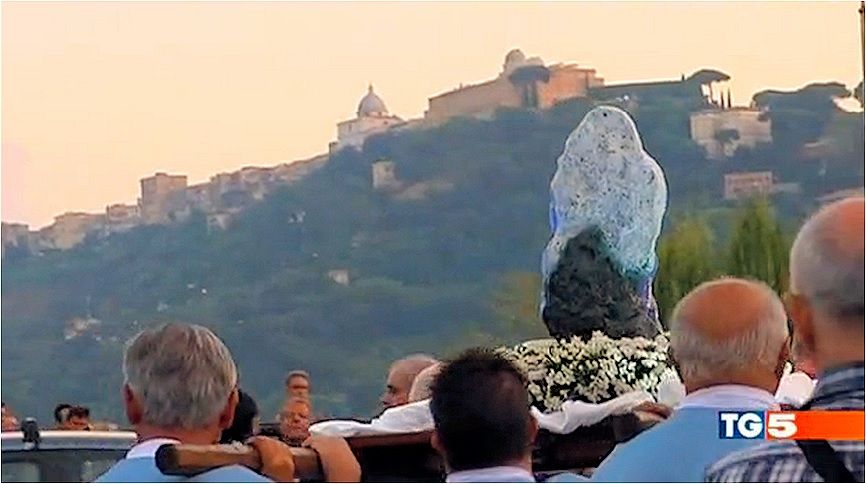 Above, videocaps from the TG5 video report on Mons. Gaenswein. So far, I have found no other photos online.
Above, videocaps from the TG5 video report on Mons. Gaenswein. So far, I have found no other photos online.
[Modificato da TERESA BENEDETTA 28/08/2013 01:17] |
| |
|
|
|
|